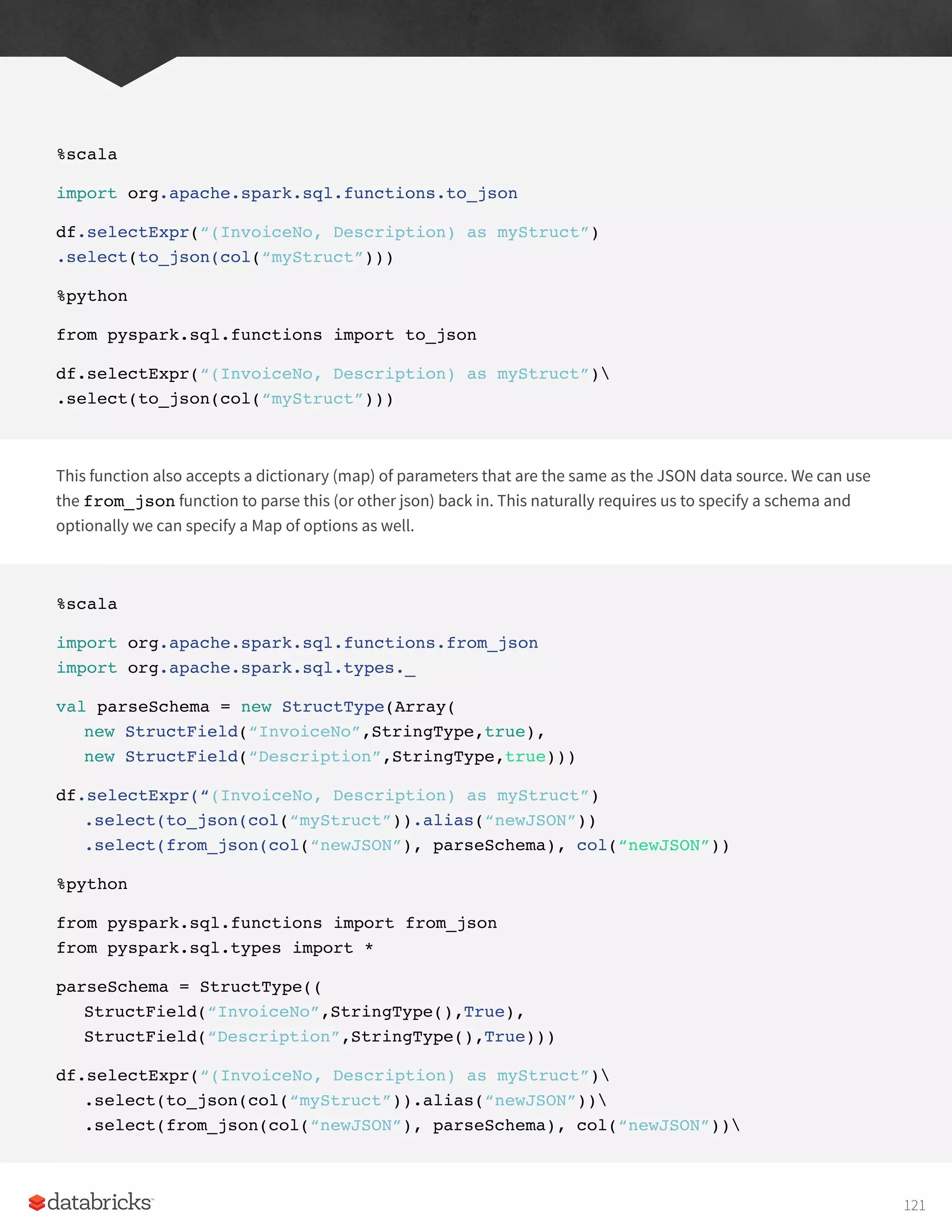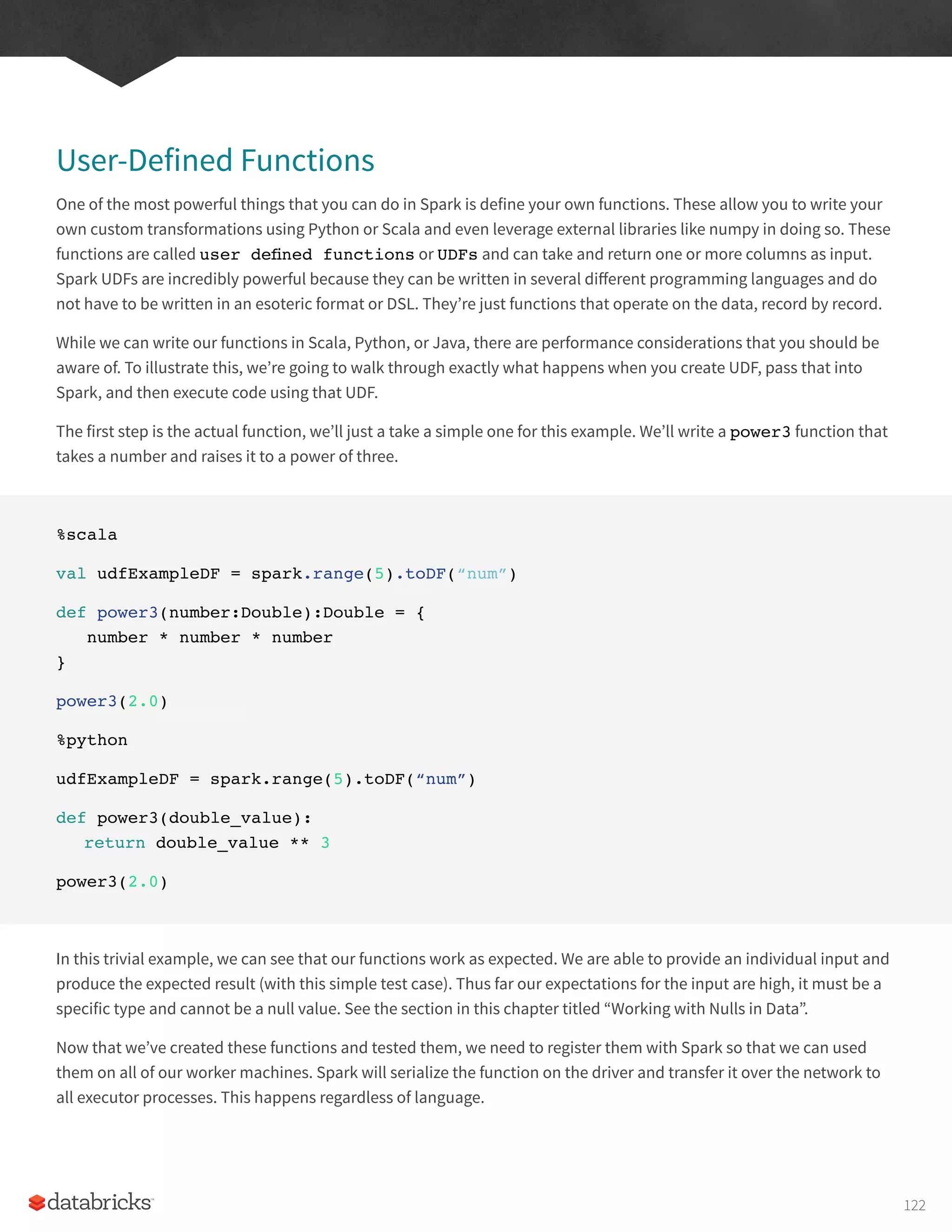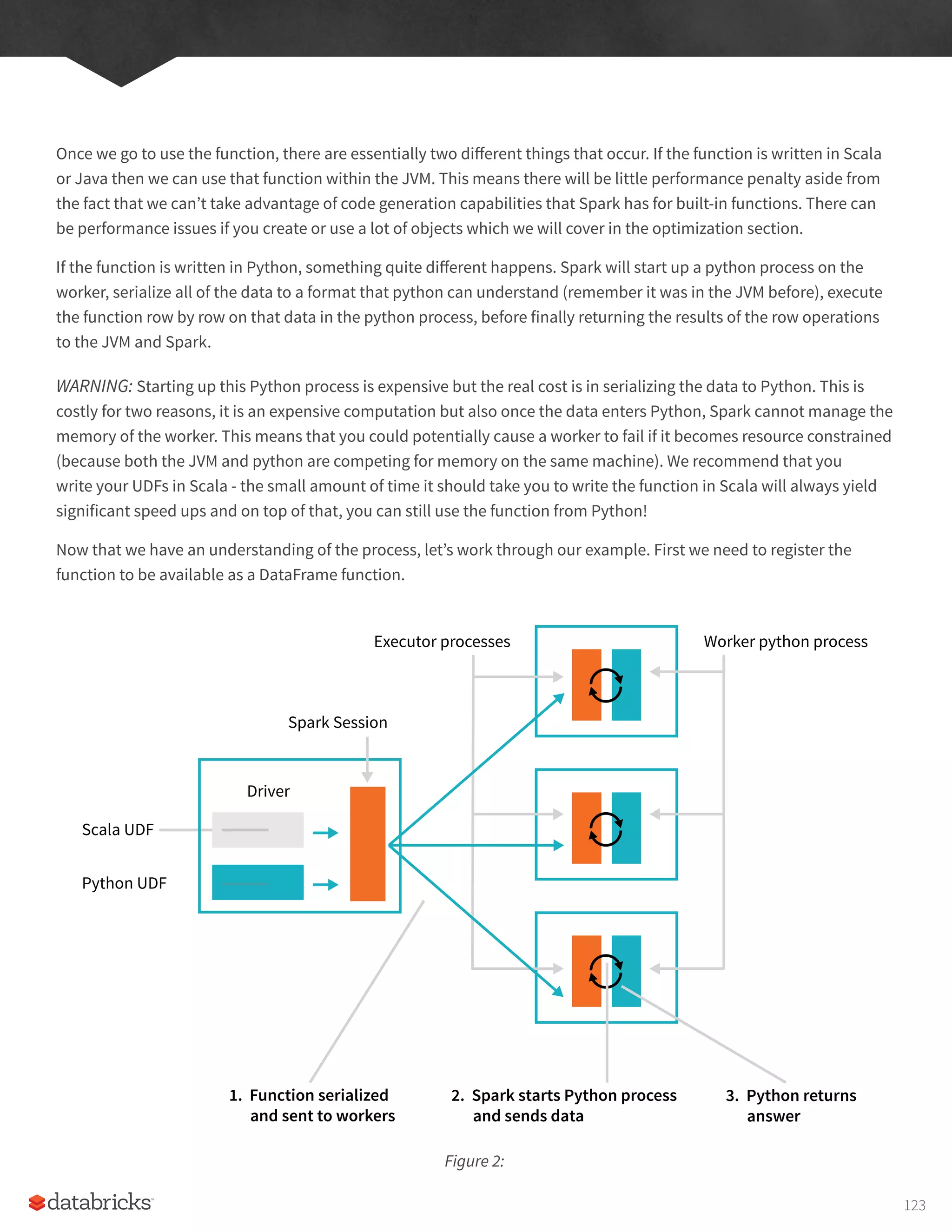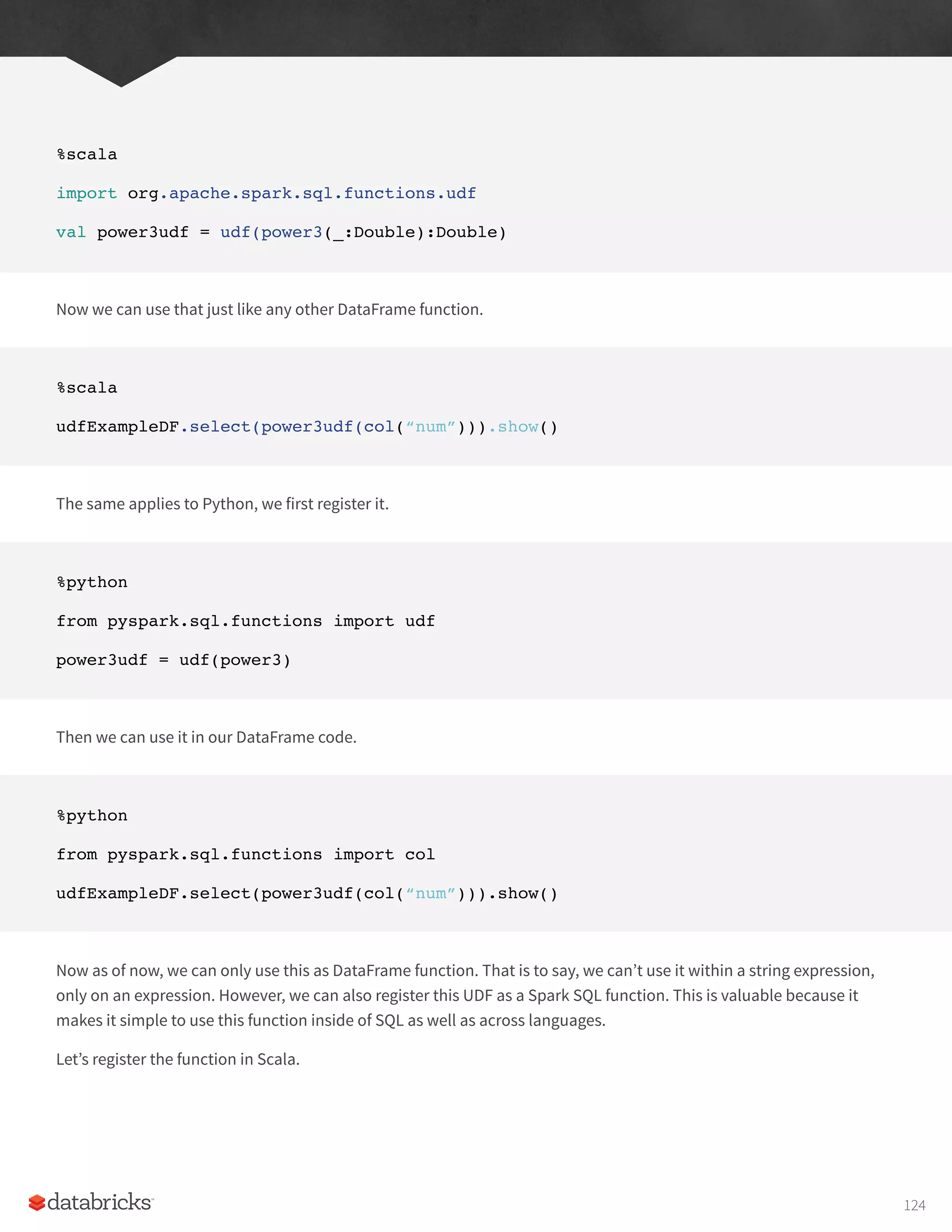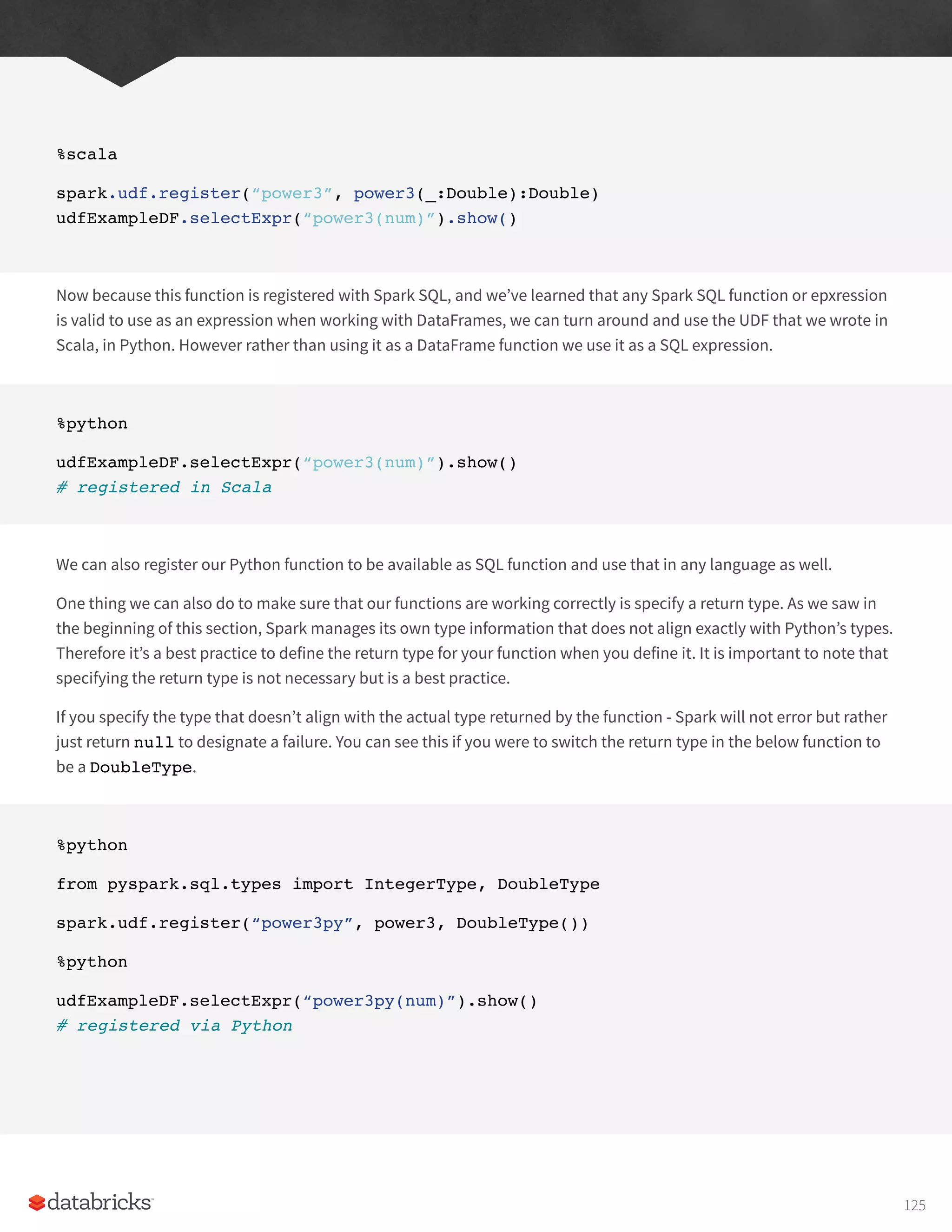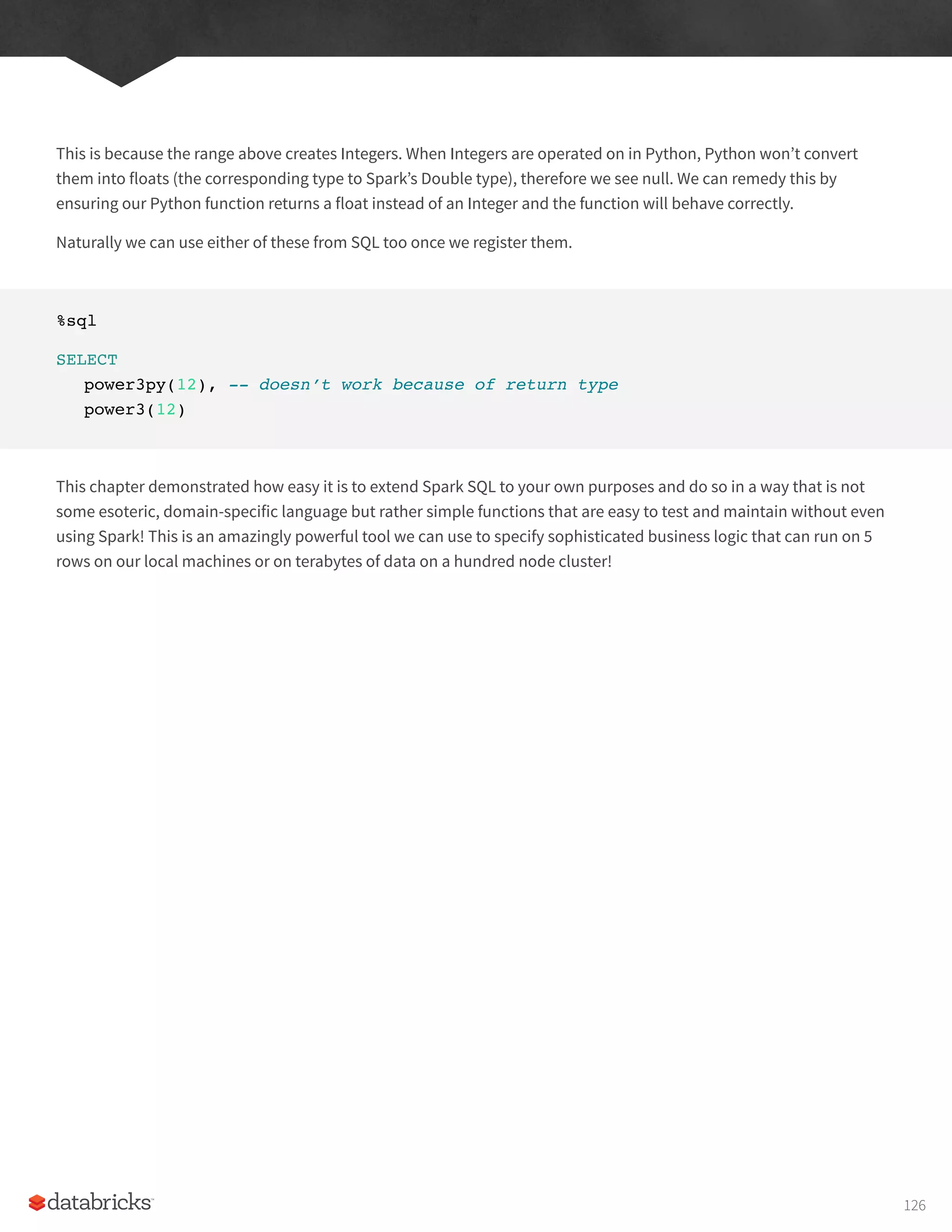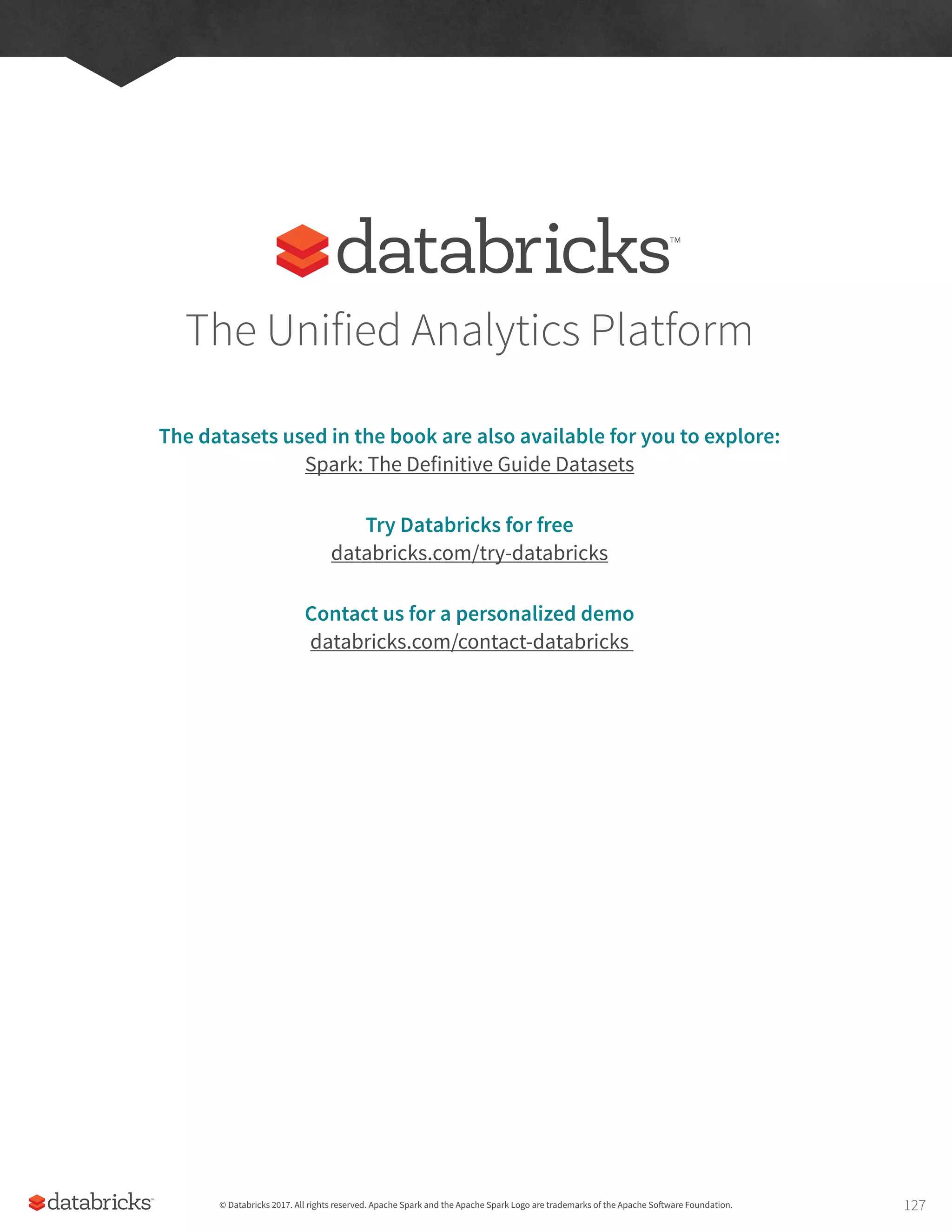This document provides an excerpt from the book "Spark: The Definitive Guide" which introduces some of the core concepts of Apache Spark. It discusses Spark's basic architecture including the driver program, executors, and cluster managers. It also covers Spark applications, DataFrames, transformations and actions. Finally, it provides a sample end-to-end example reading CSV flight data to demonstrate these concepts.
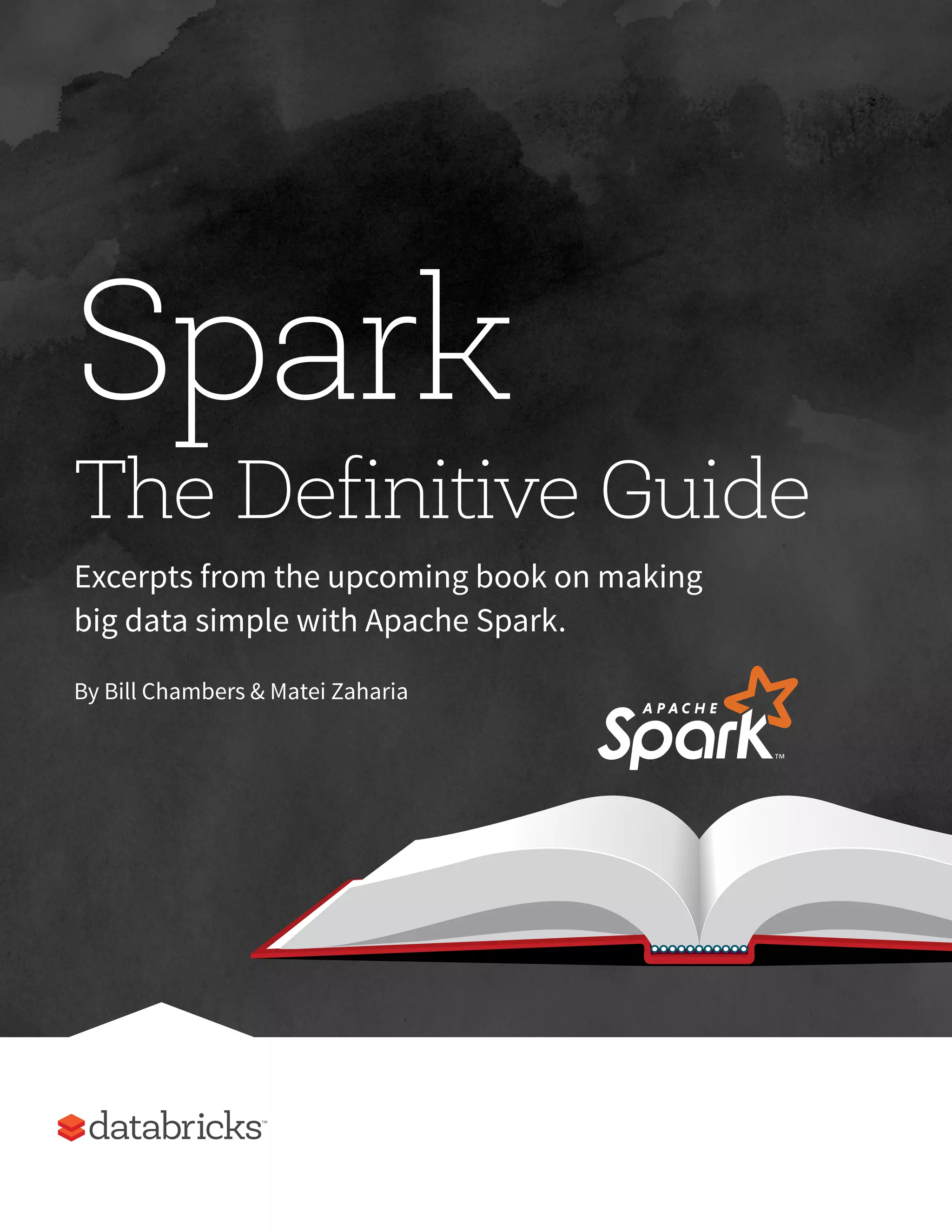
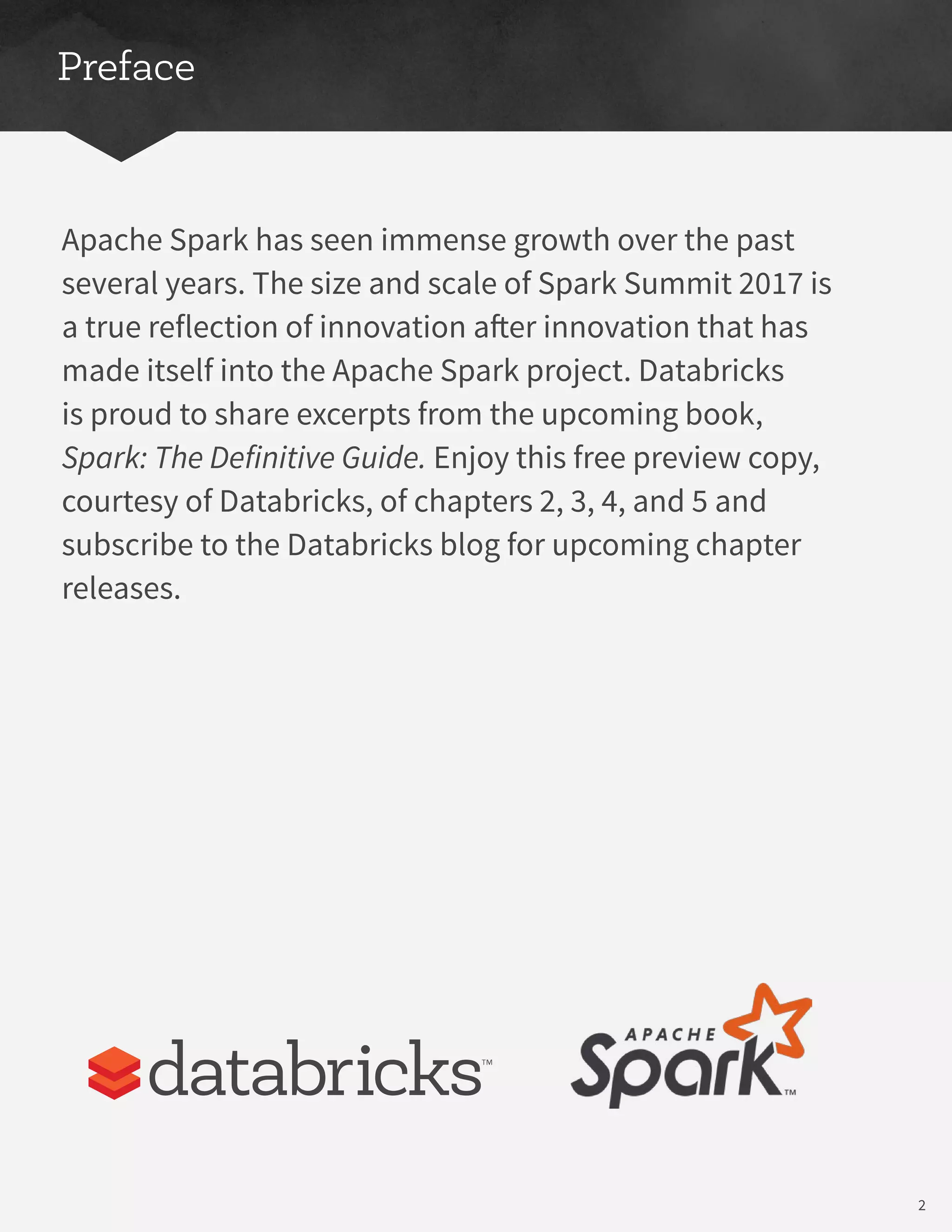
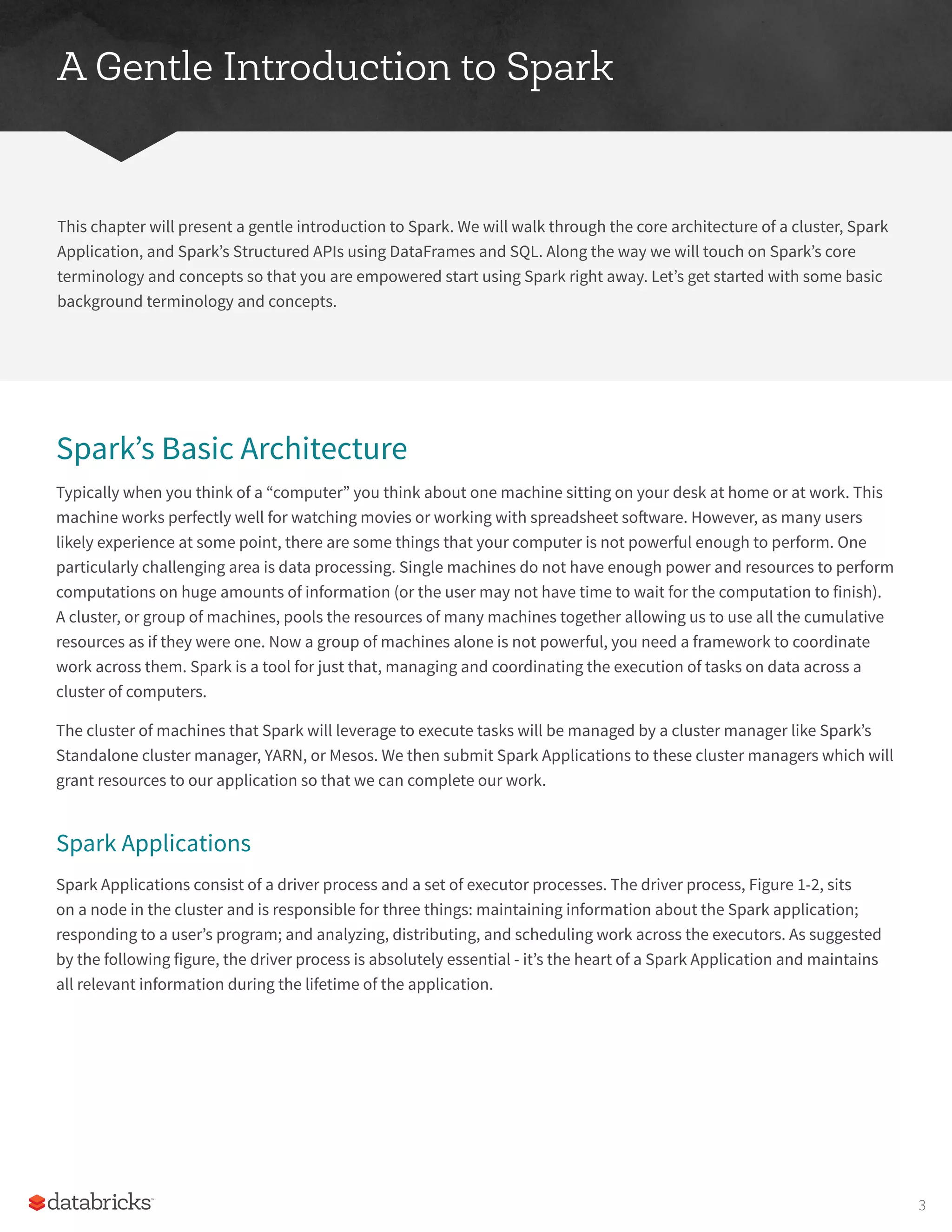

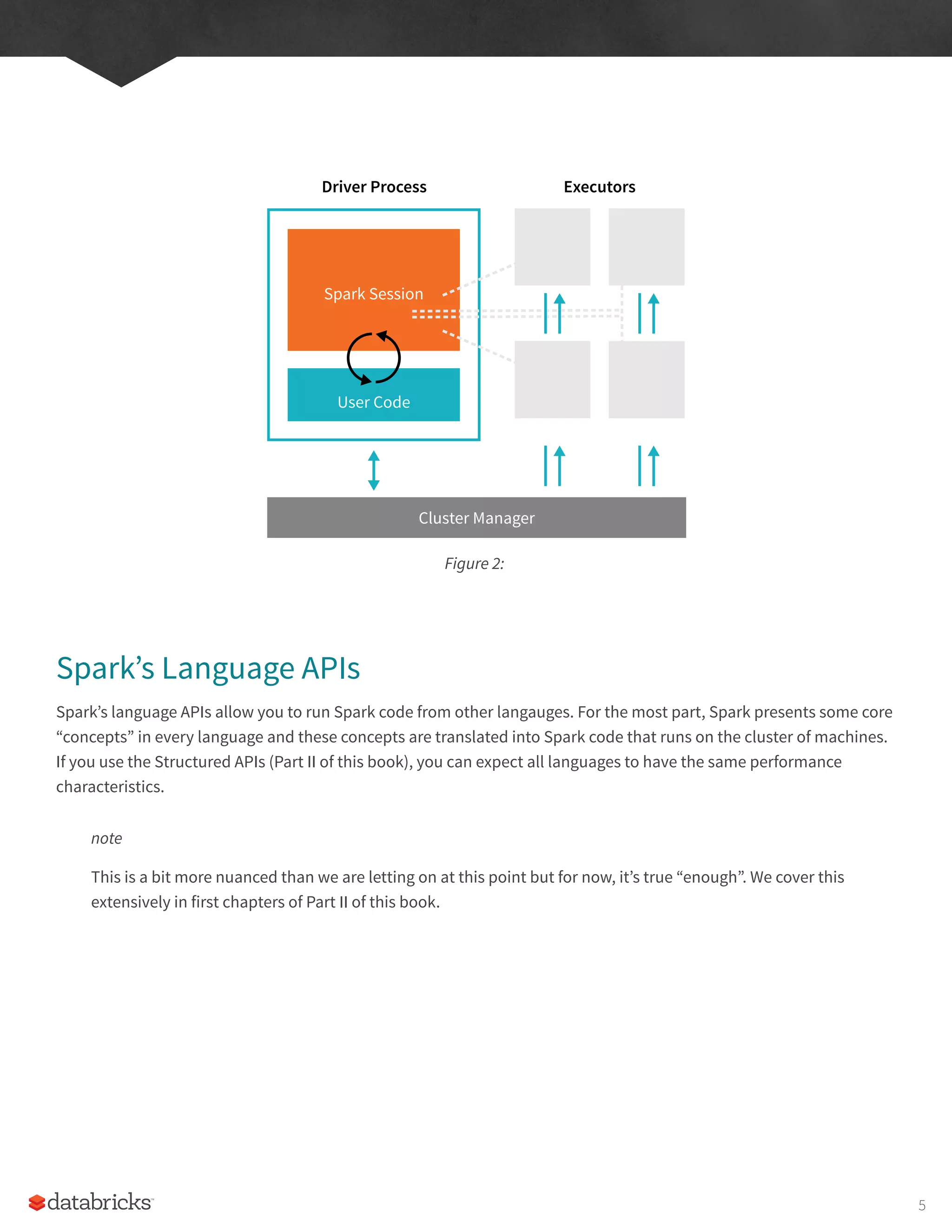
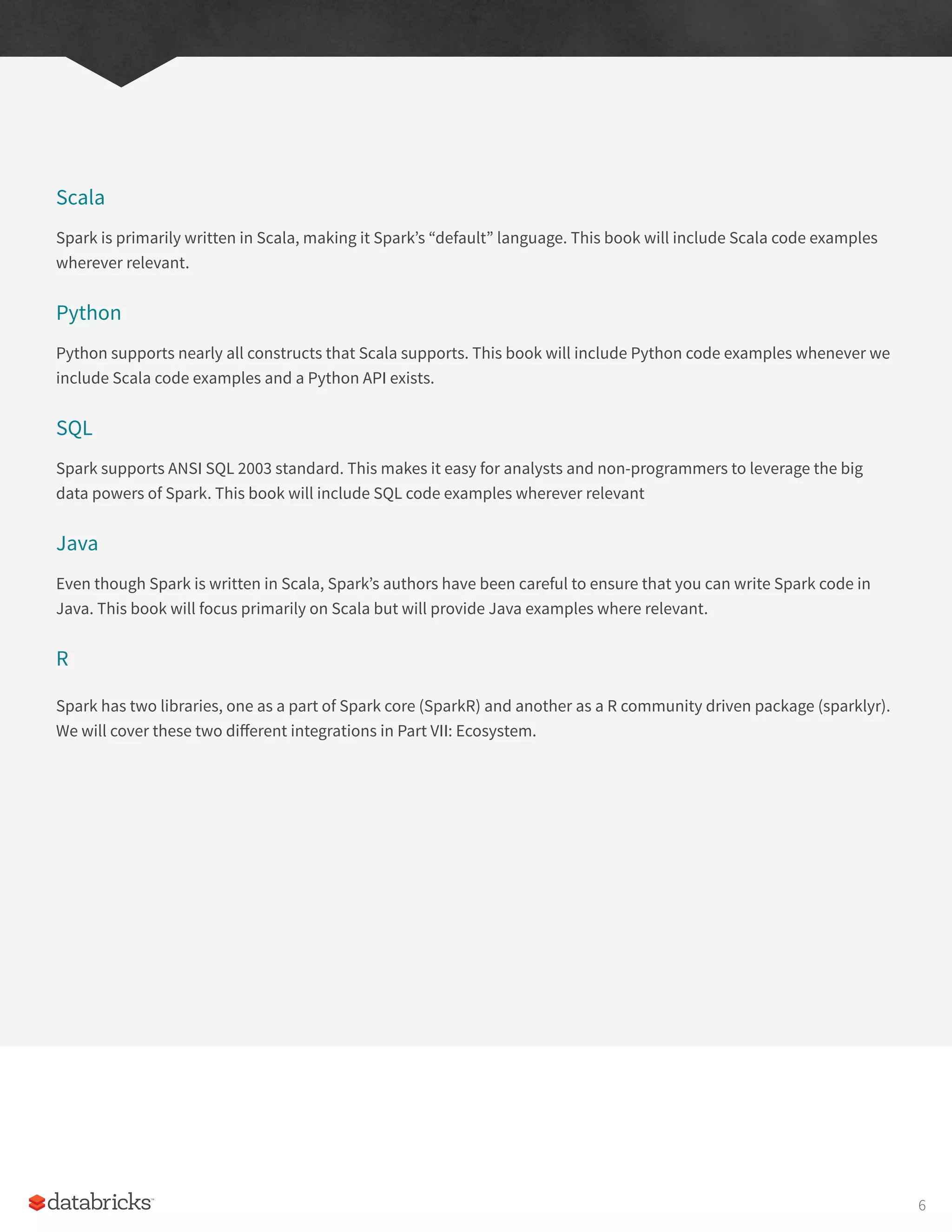
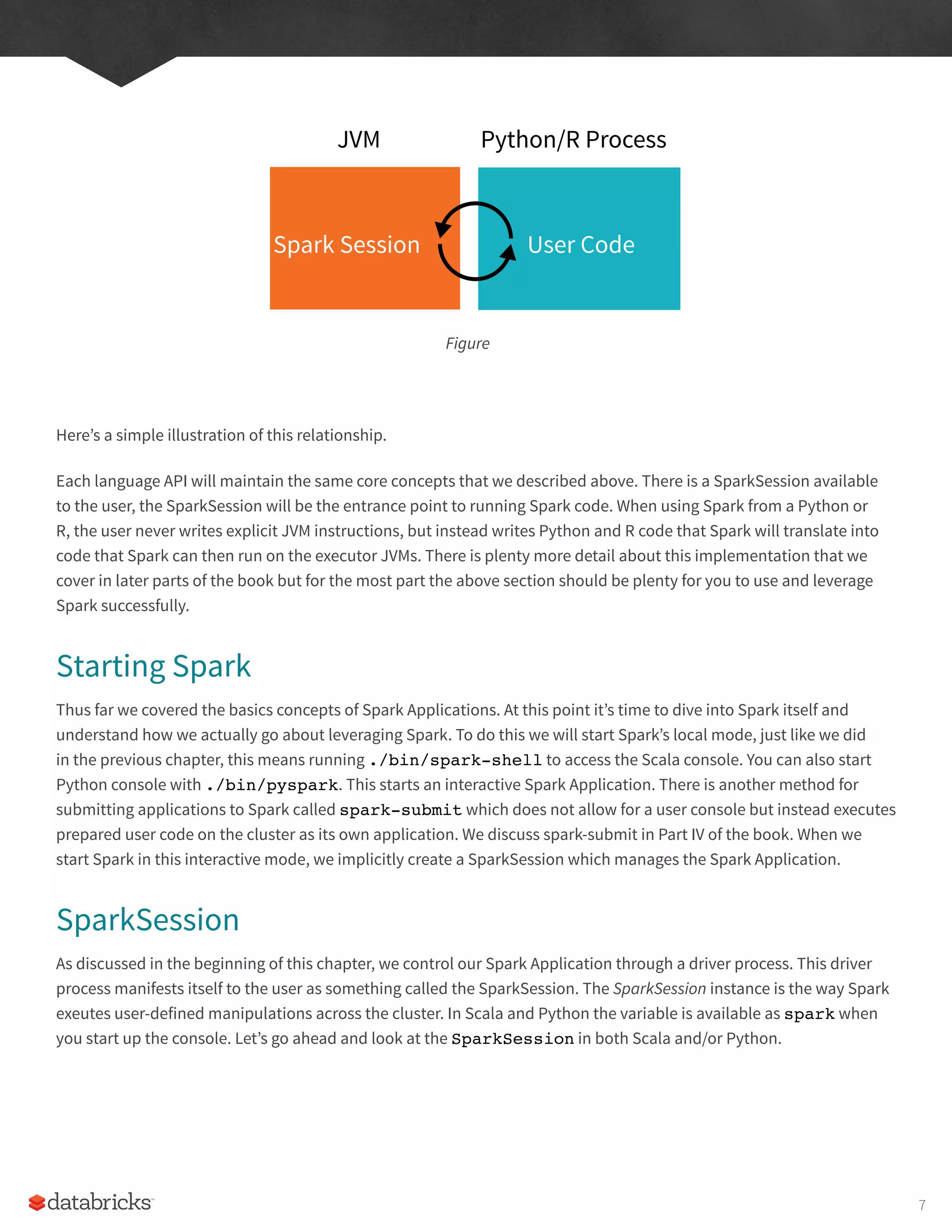
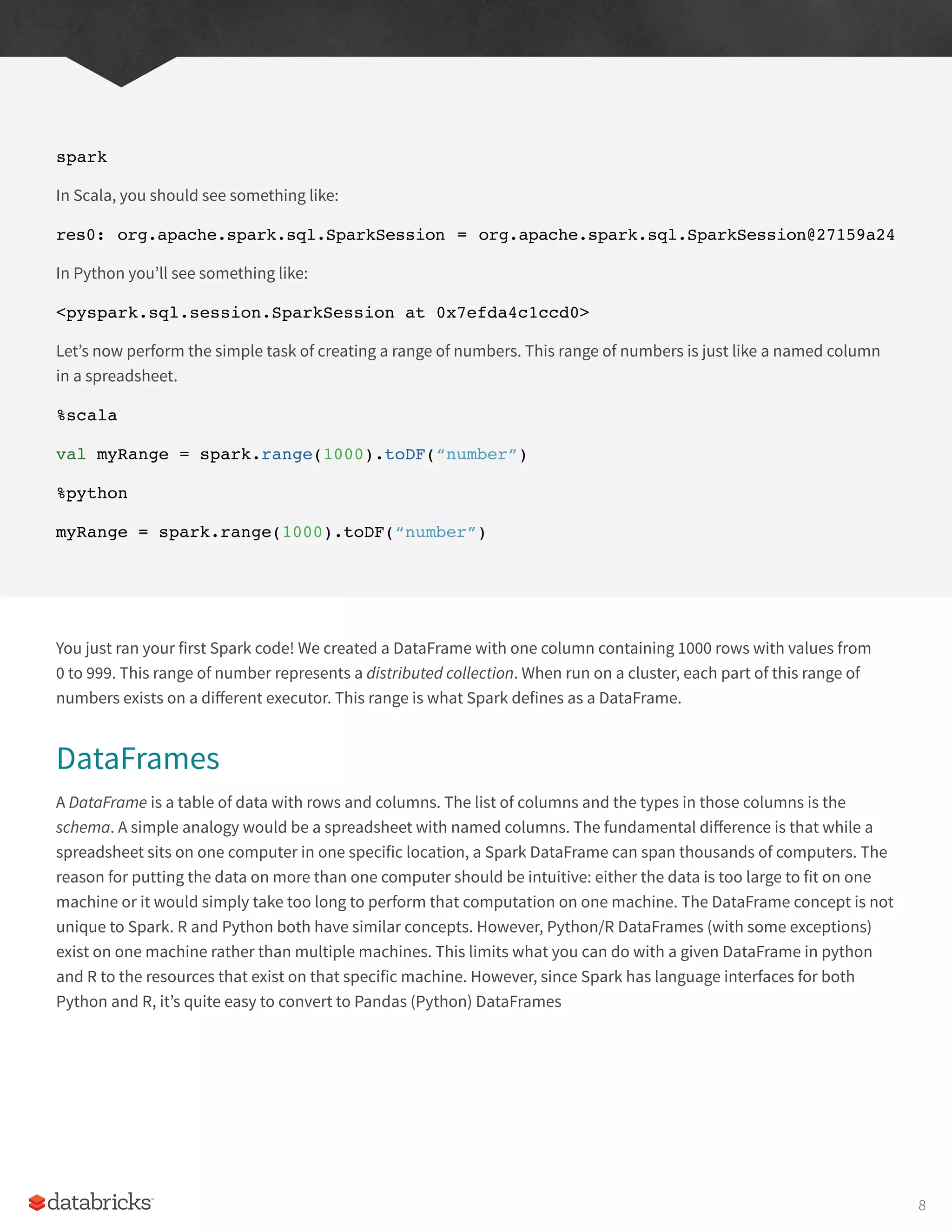
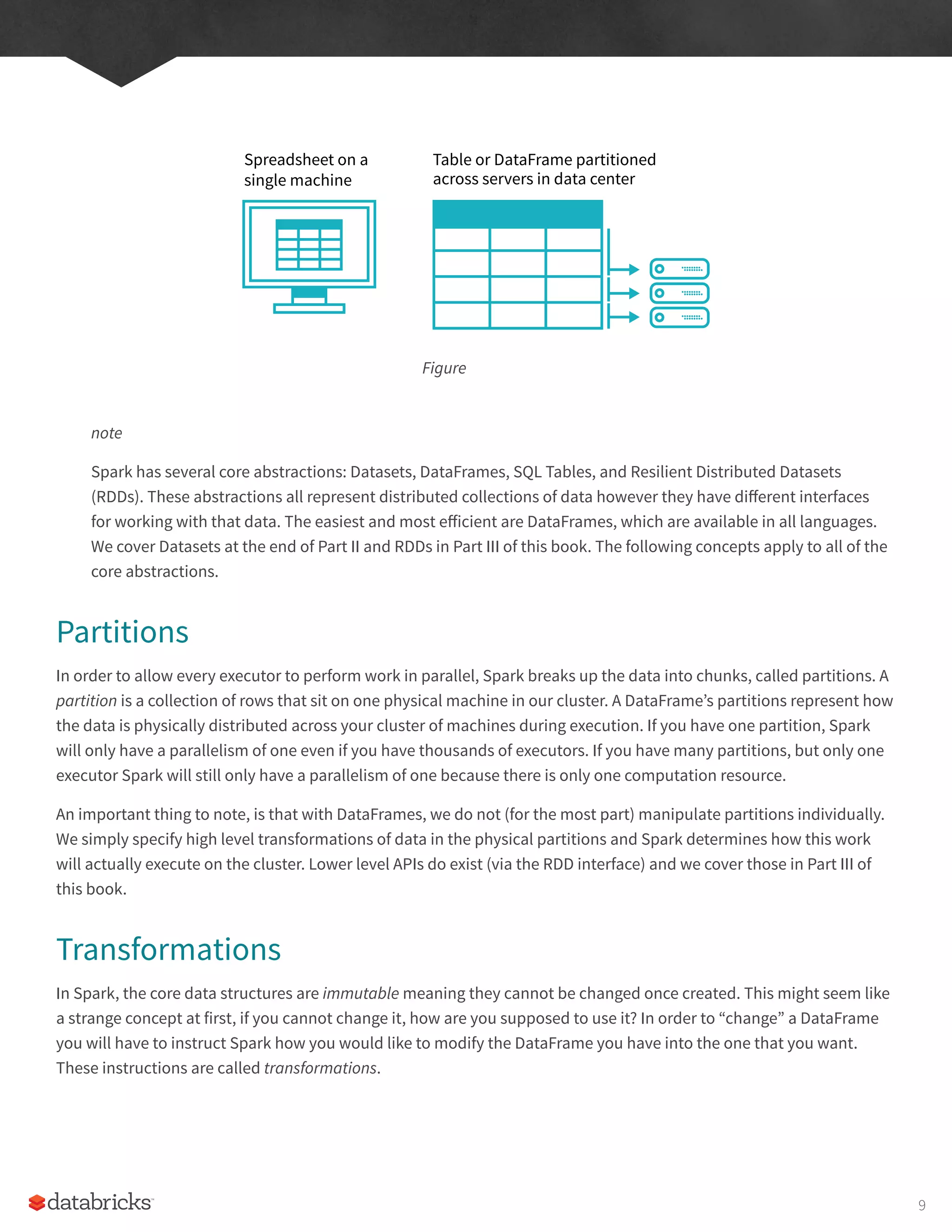
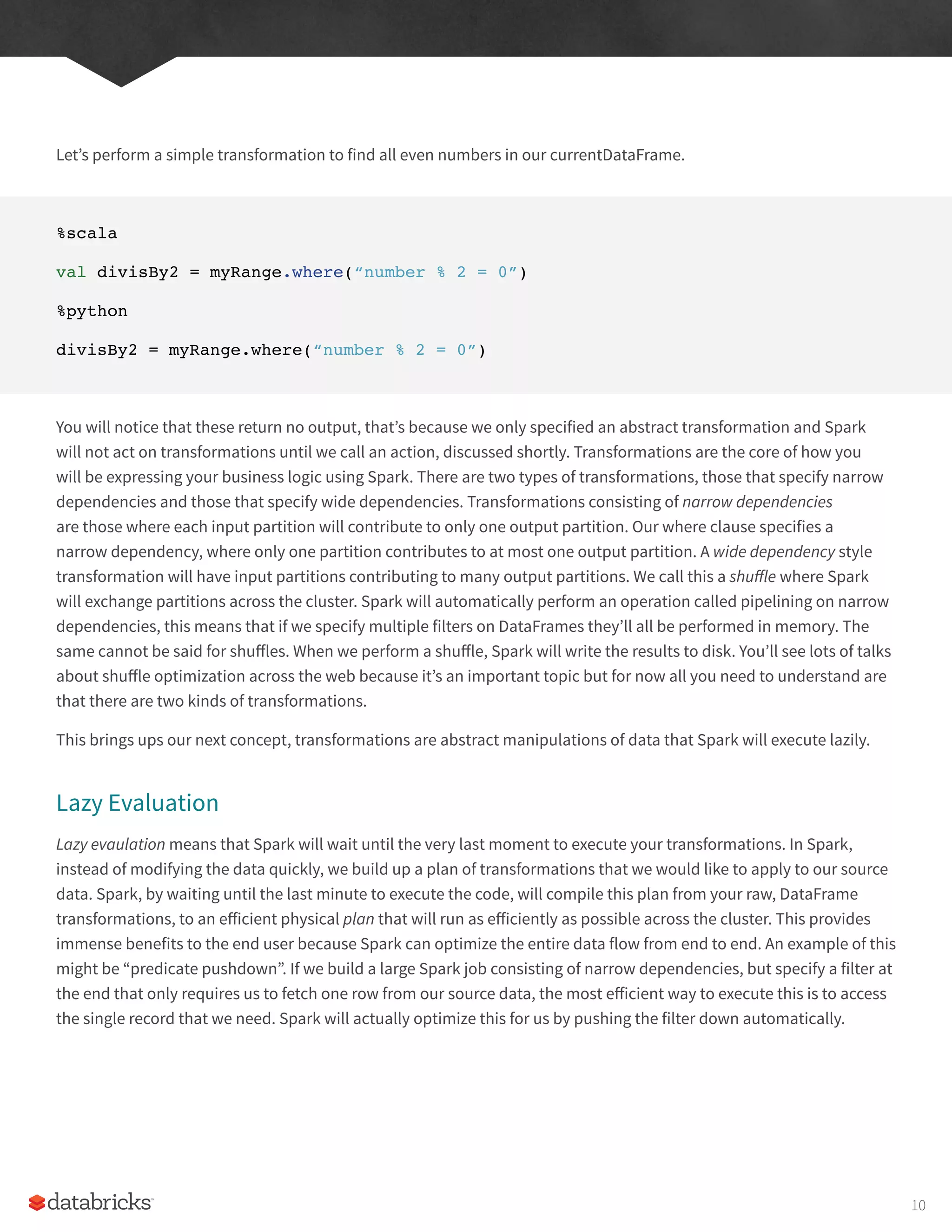
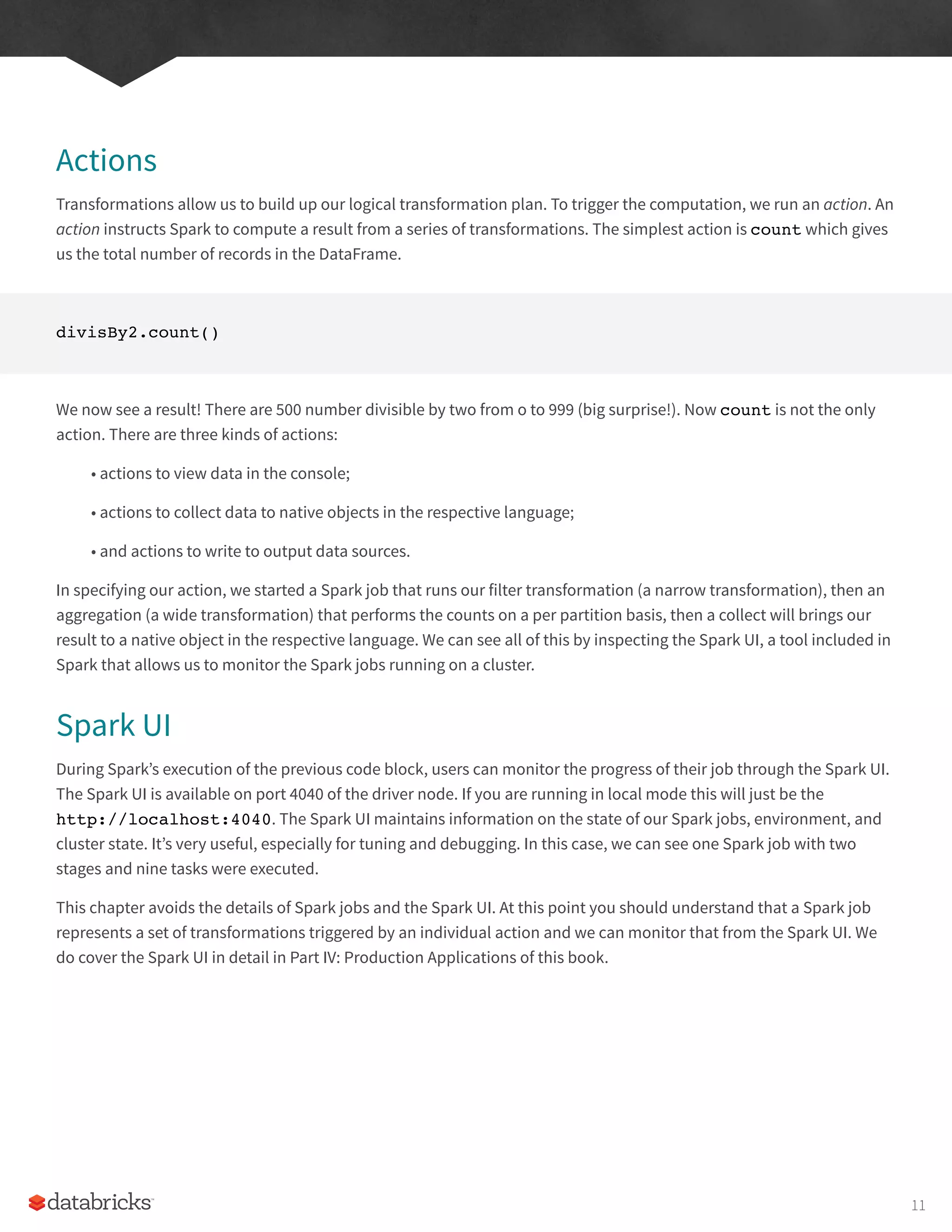
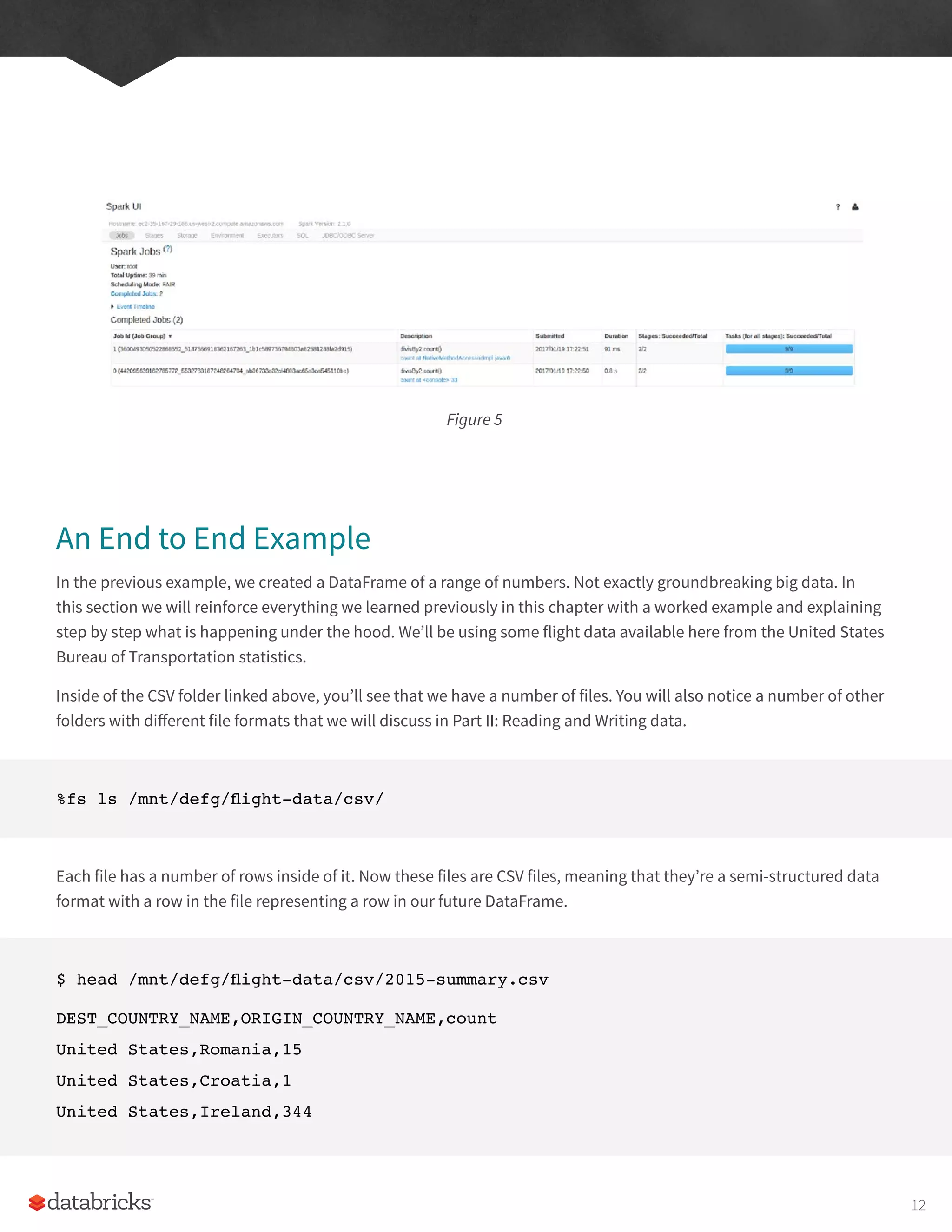
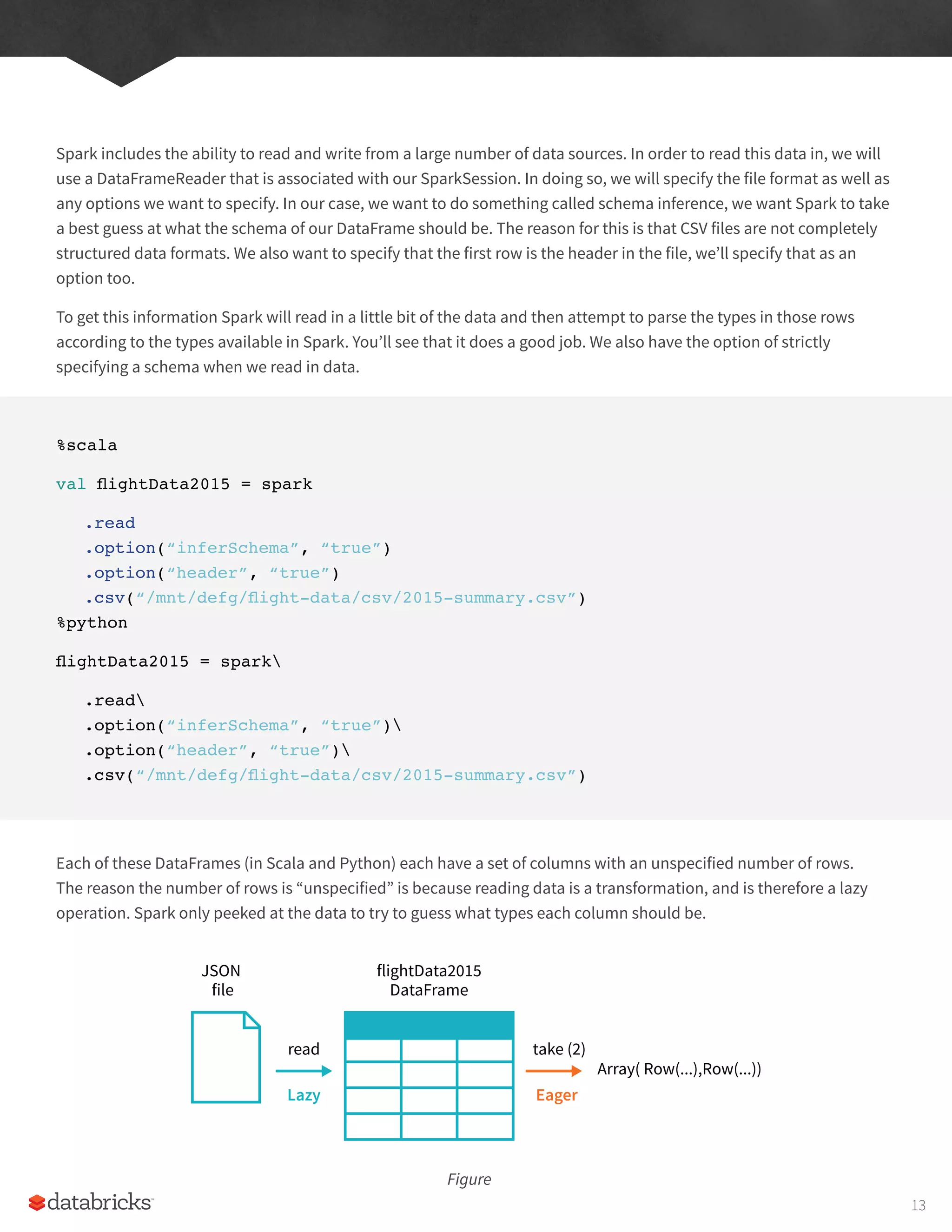

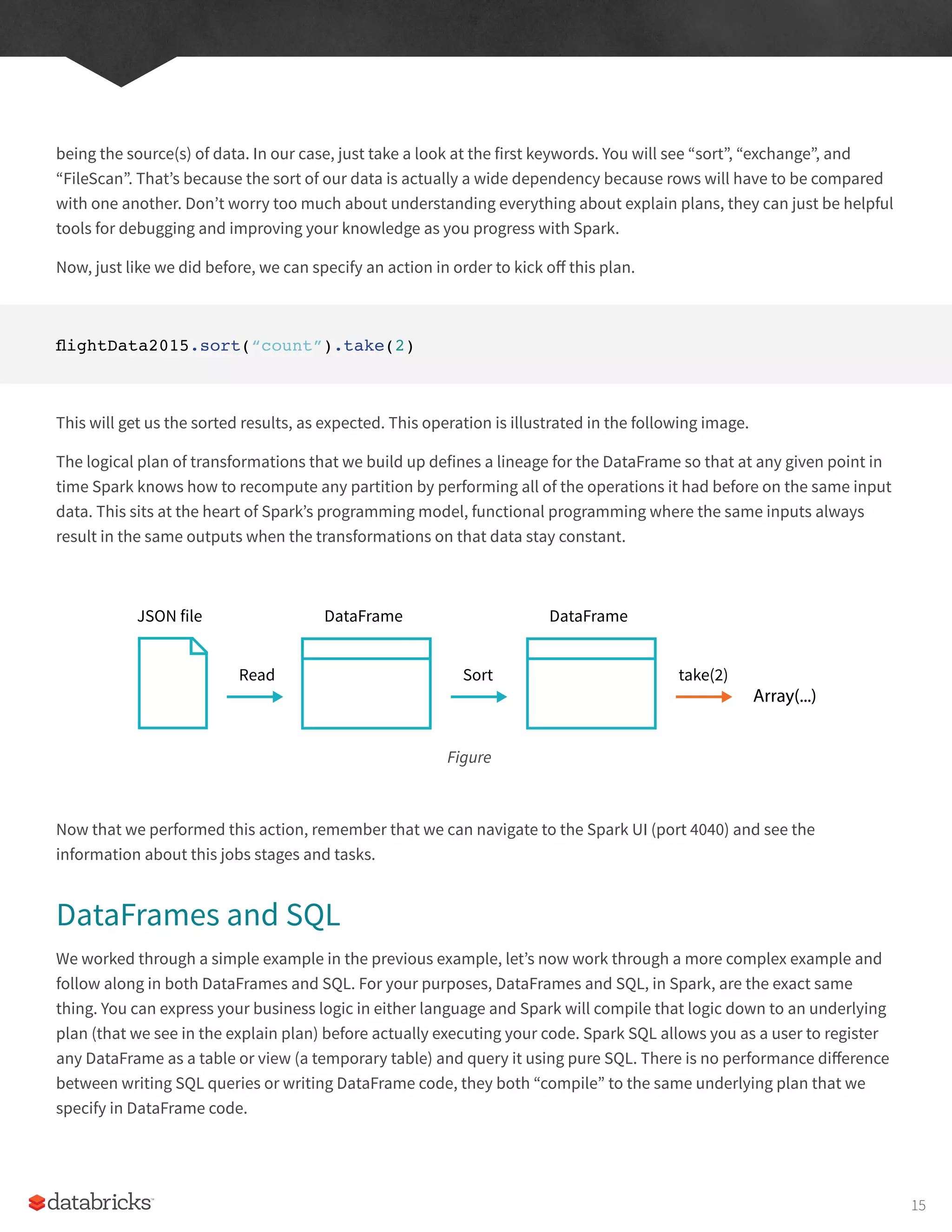
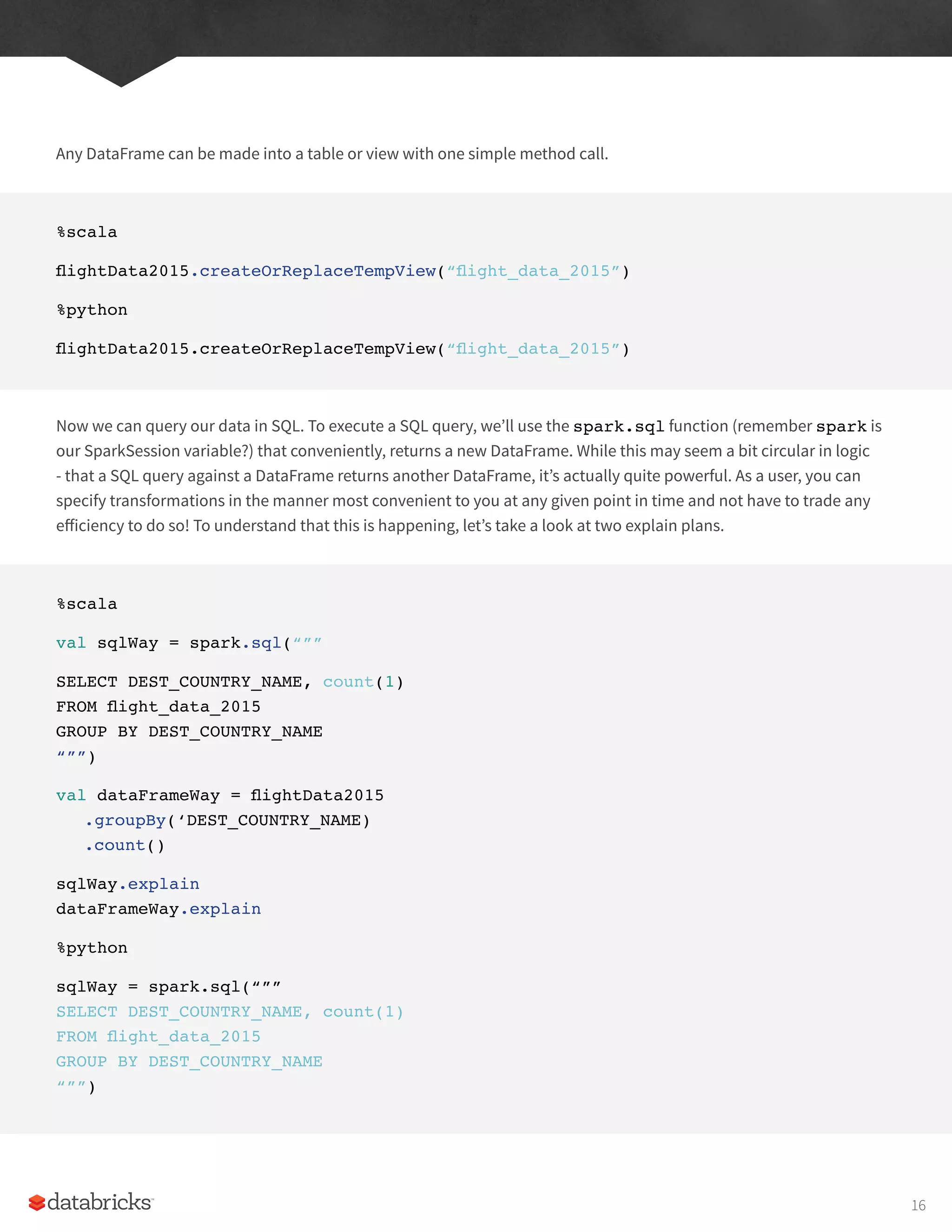
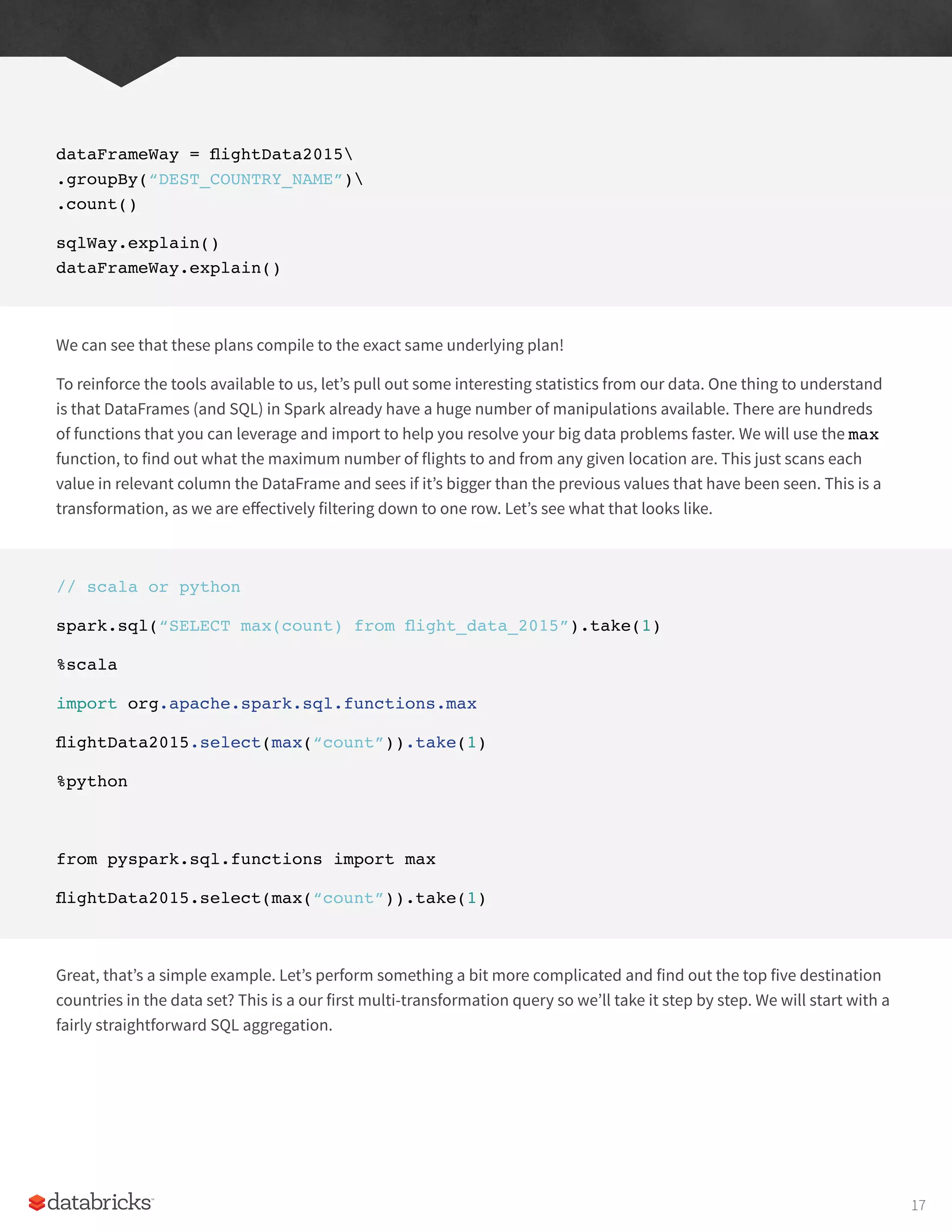
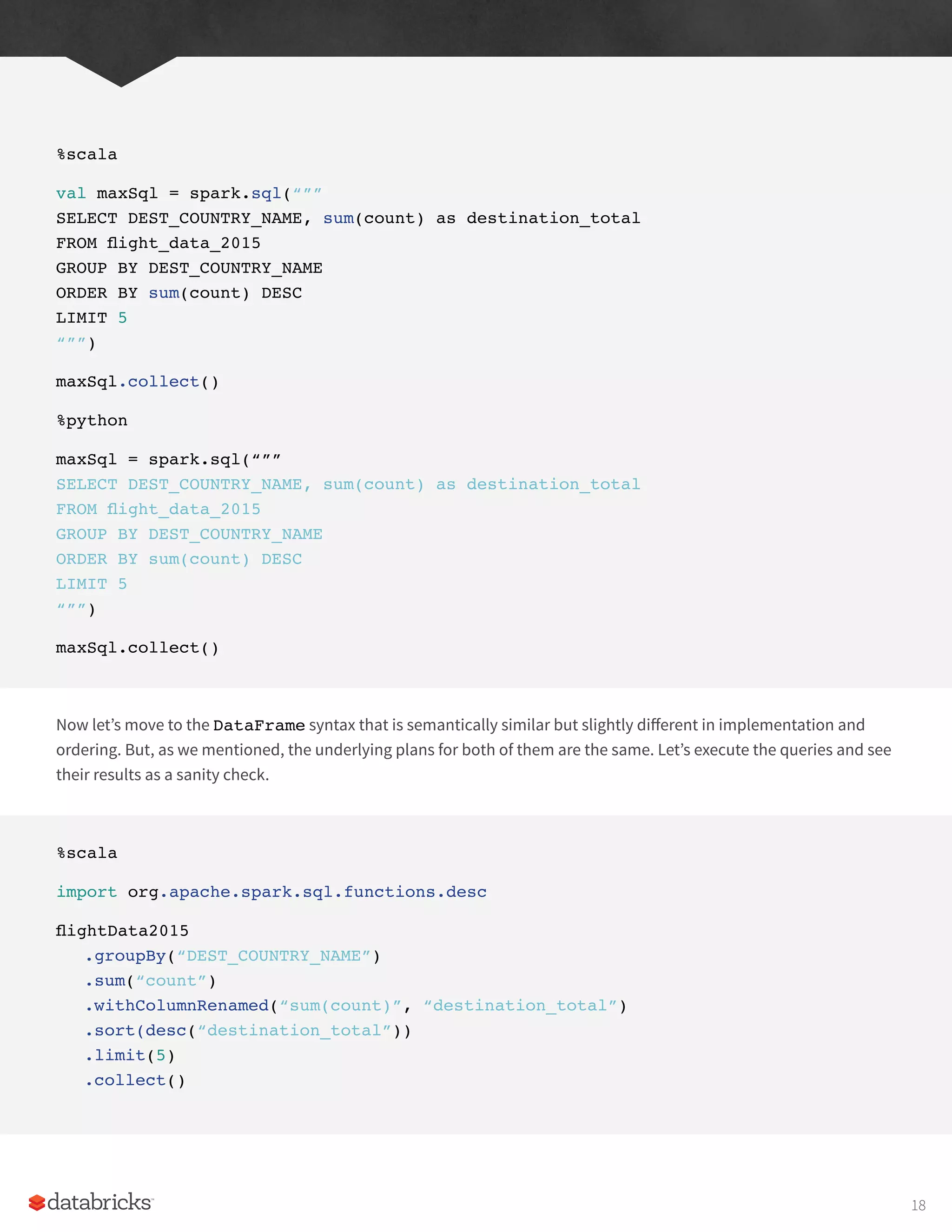
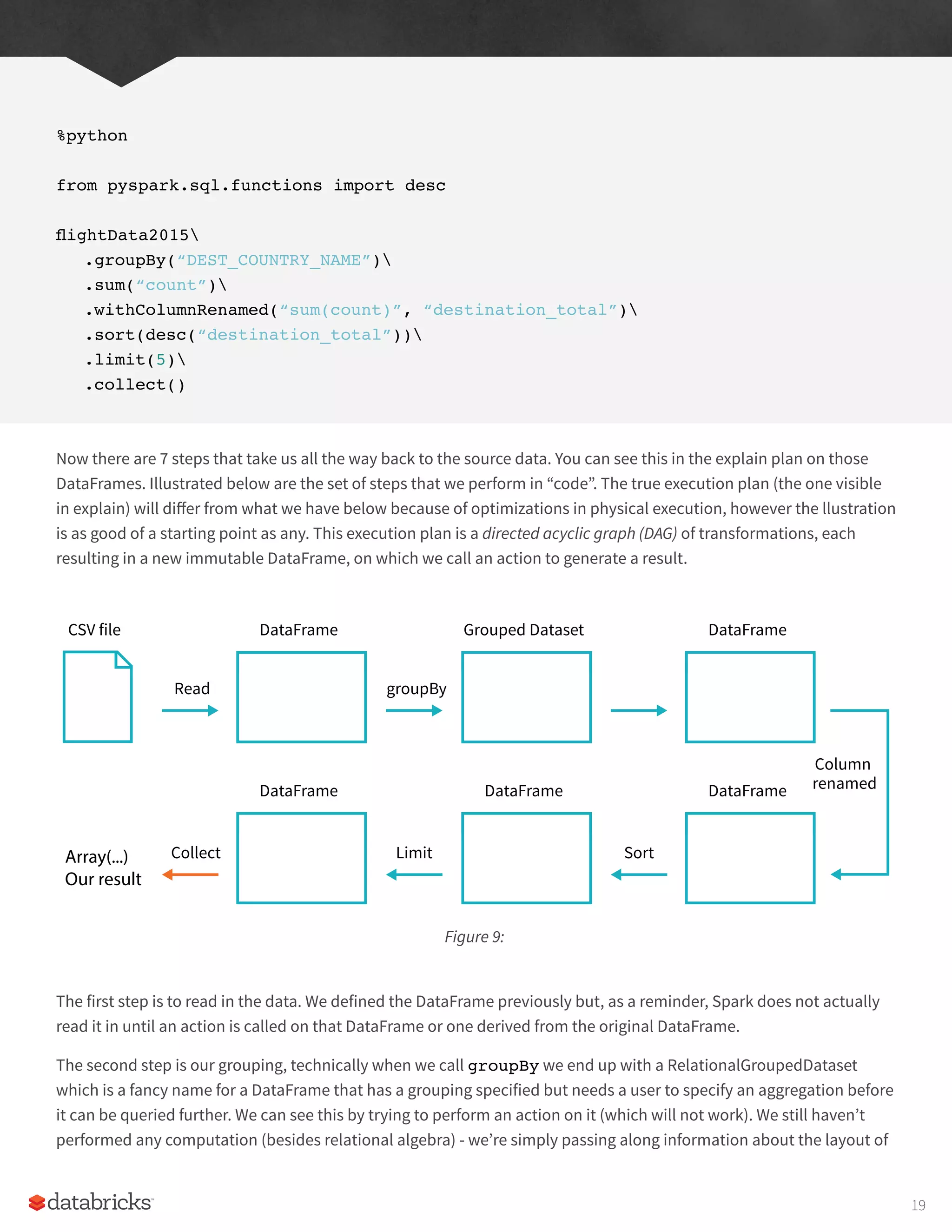

![.sort(desc(“destination_total”))
.limit(5)
.explain()
== Physical Plan ==
TakeOrderedAndProject(limit=5, orderBy=[destination_total#16194L DESC],
output=[DEST_COUNTRY_
+- *HashAggregate(keys=[DEST_COUNTRY_NAME#7323], functions=[sum(count#7325L)])
+- Exchange hashpartitioning(DEST_COUNTRY_NAME#7323, 5)
+- *HashAggregate(keys=[DEST_COUNTRY_NAME#7323], functions=[partial_
sum(count#7325L)])
+- InMemoryTableScan [DEST_COUNTRY_NAME#7323, count#7325L]
+- InMemoryRelation [DEST_COUNTRY_NAME#7323, ORIGIN_COUNTRY_NAME#7324, count#
+- *Scan csv [DEST_COUNTRY_NAME#7578,ORIGIN_COUNTRY_NAME#7579,count#7580L]
While this explain plan doesn’t match our exact “conceptual plan” all of the pieces are there. You can see the limit
statement as well as the orderBy (in the first line). You can also see how our aggregation happens in two phases, in
the partial_sum calls. This is because summing a list of numbers is commutative and Spark can perform the sum,
partition by partition. Of course we can see how we read in the DataFrame as well.
Naturally, we don’t always have to collect the data. We can also write it out to any data source that Spark supports.
For instance, let’s say that we wanted to store the information in a database, we could write these results out to JDBC.
We could also write them out to a new file.
This chapter introduces the basics of Spark. We talked about transformations and actions, how Spark lazily executes
a DAG of transformations in order to optimize the execution plan on DataFrames. We talked about how data is
organized into partitions and set the stage for working with more complex transformations. The next chapter will help
show you around the vast Spark ecosystem. We will see some more advanced concepts and tools that are available
in Spark, from Streaming to Machine Learning, to explore all that Spark has to offer in addition to the features and
concepts covered in this chapter.
21](https://image.slidesharecdn.com/apache-spark-the-definitive-guide-excerpts-r1-211010030627/75/Apache-spark-the-definitive-guide-excerpts-r1-21-2048.jpg)
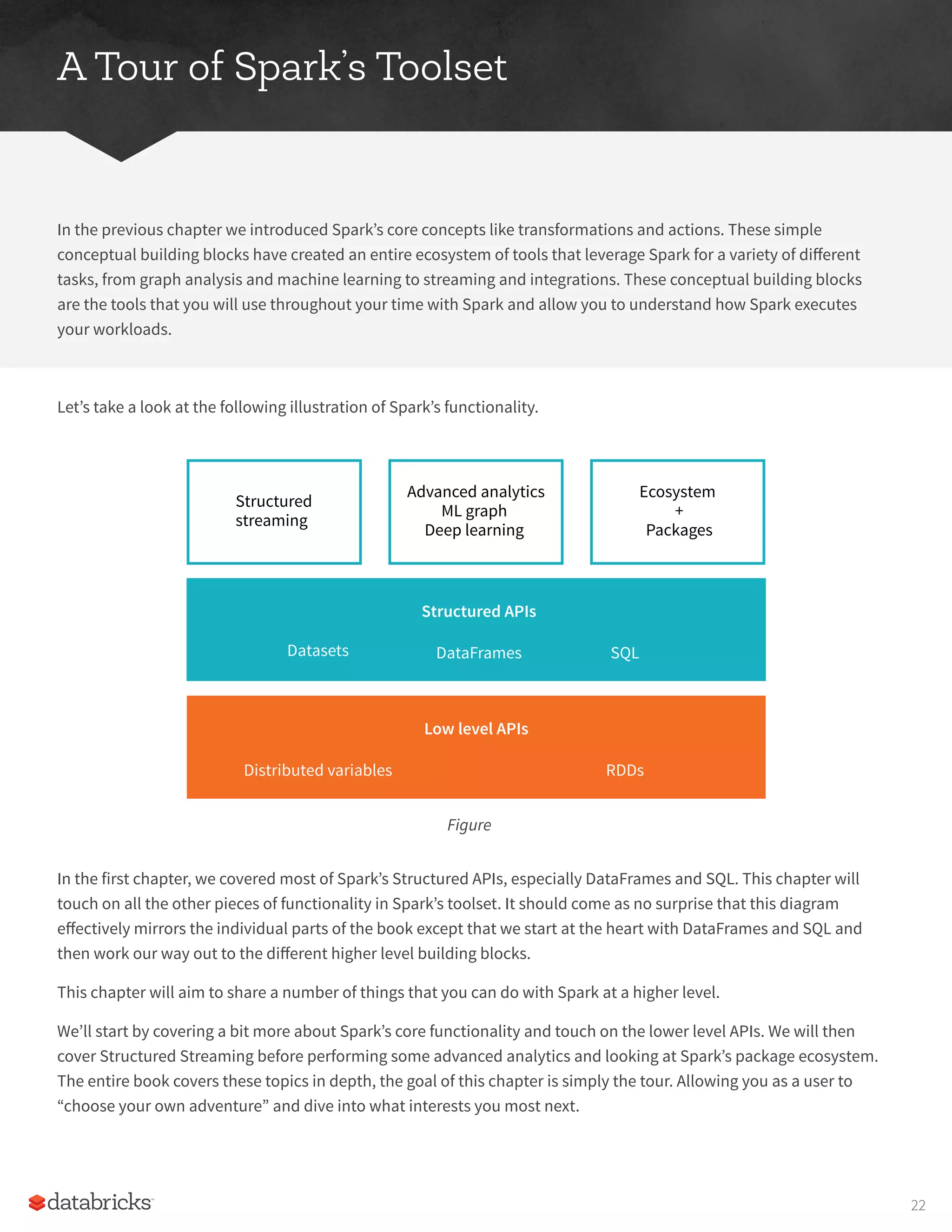
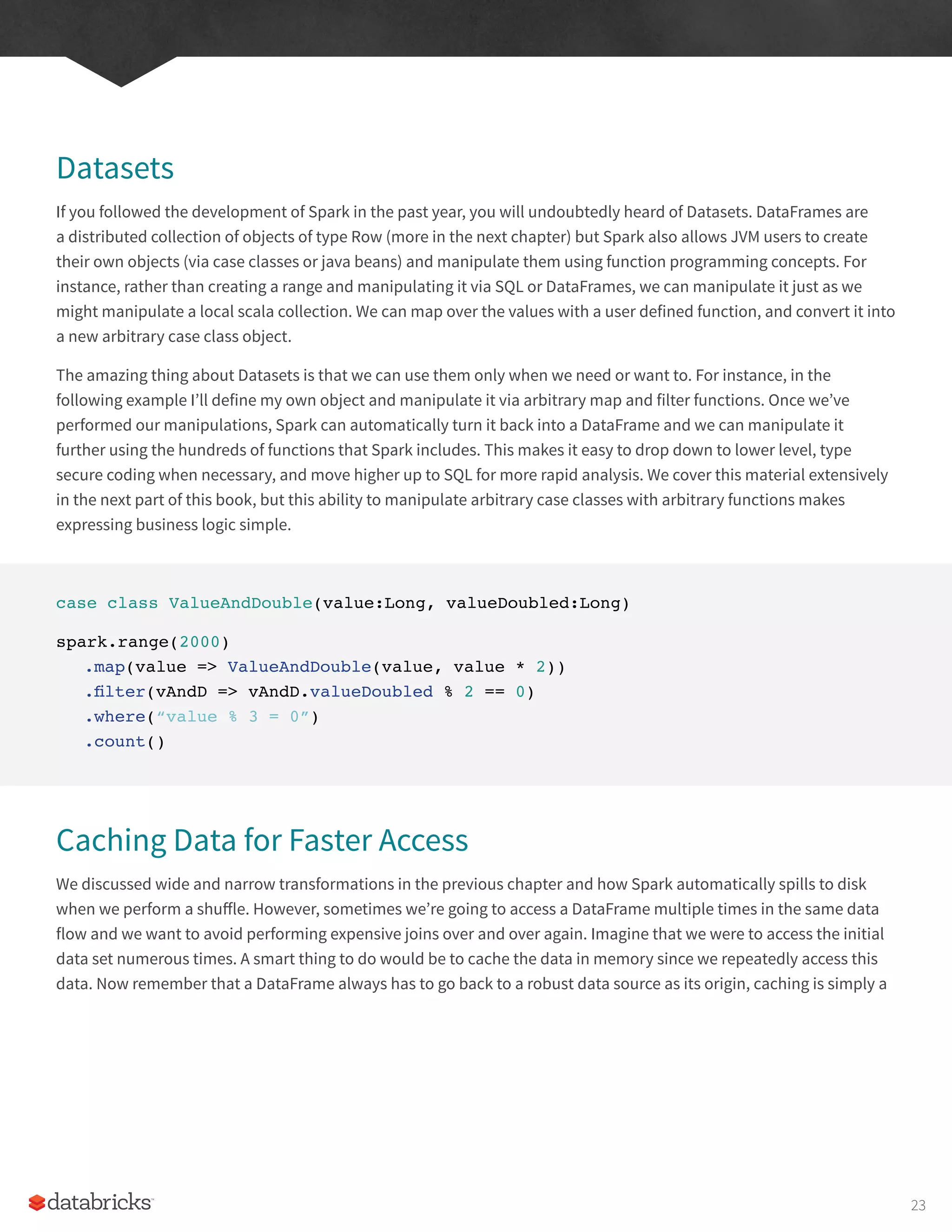

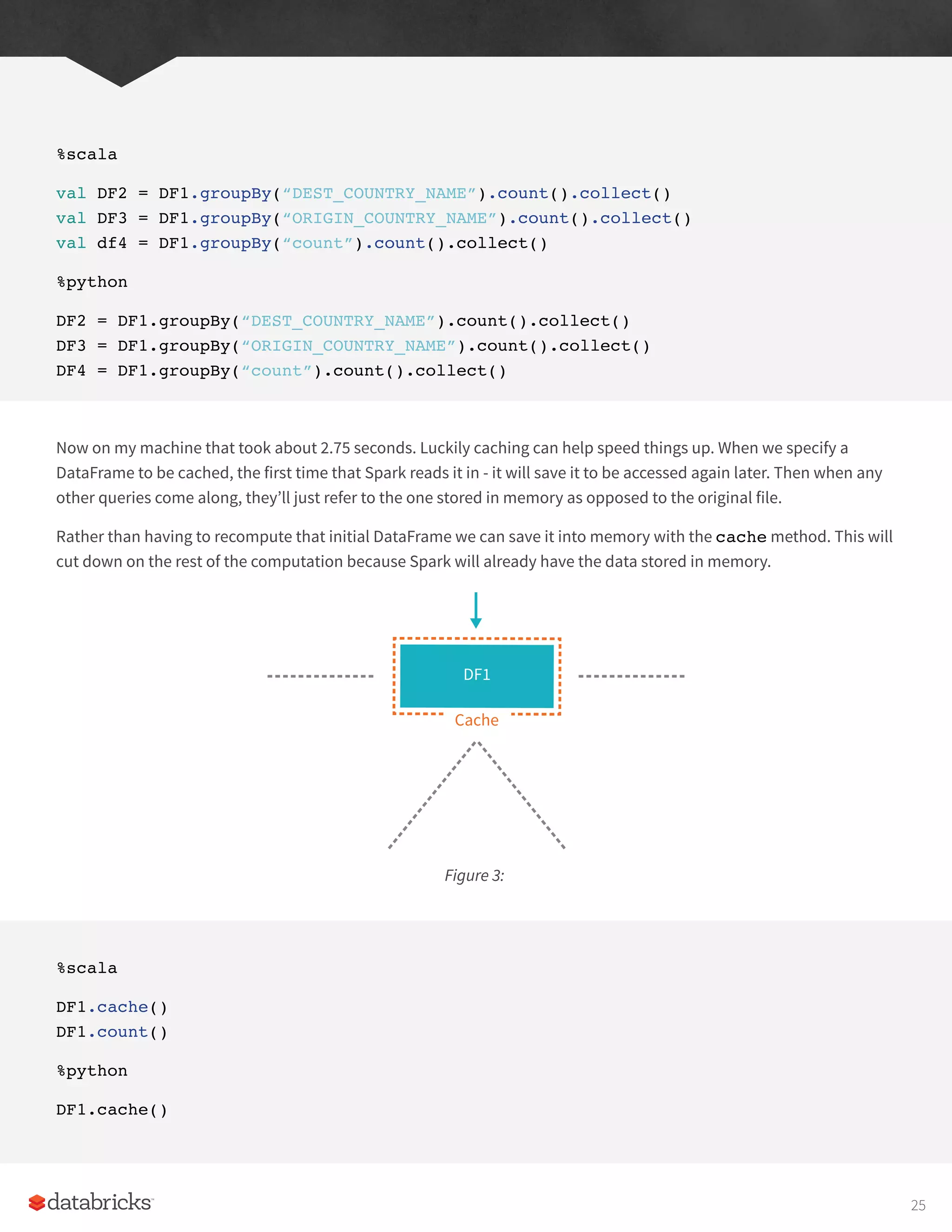
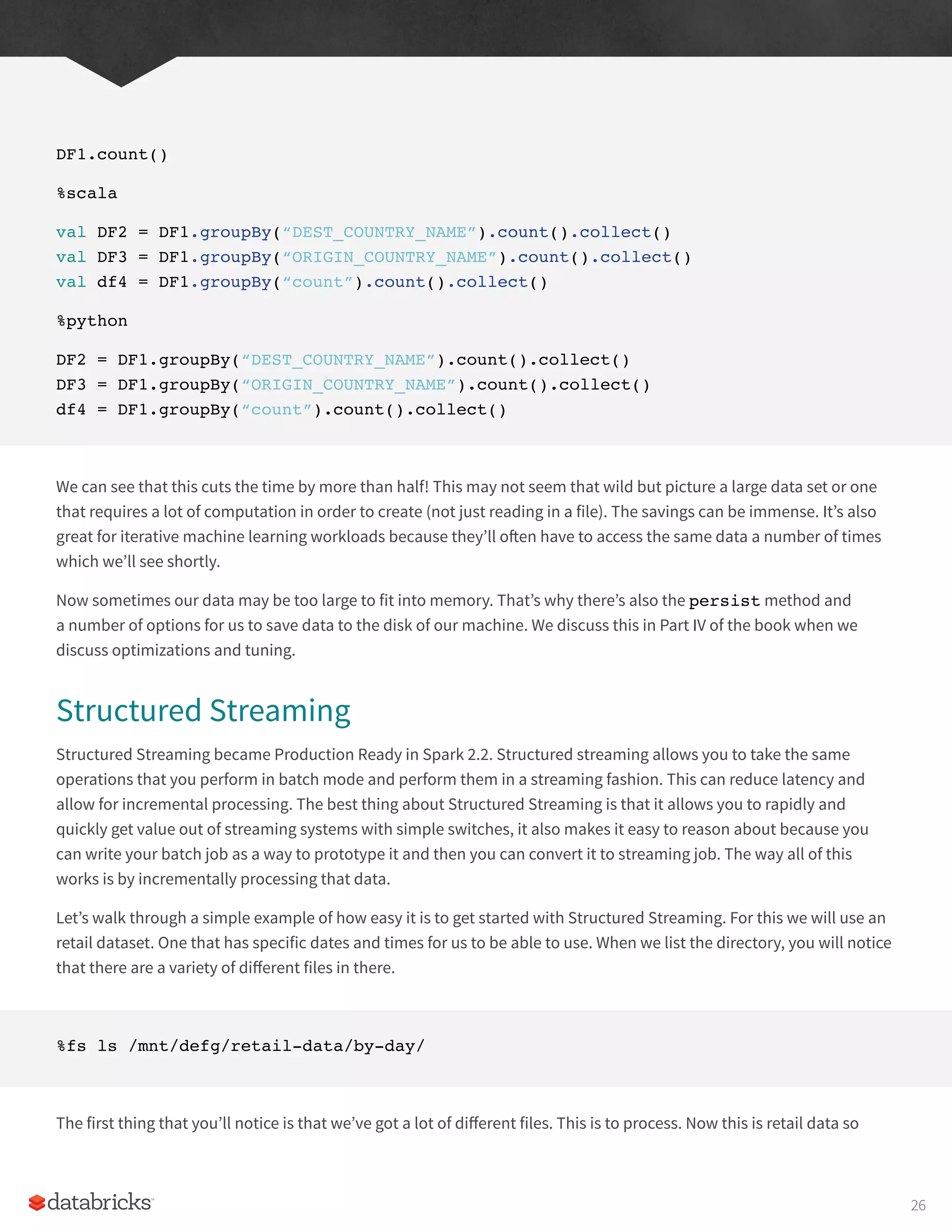
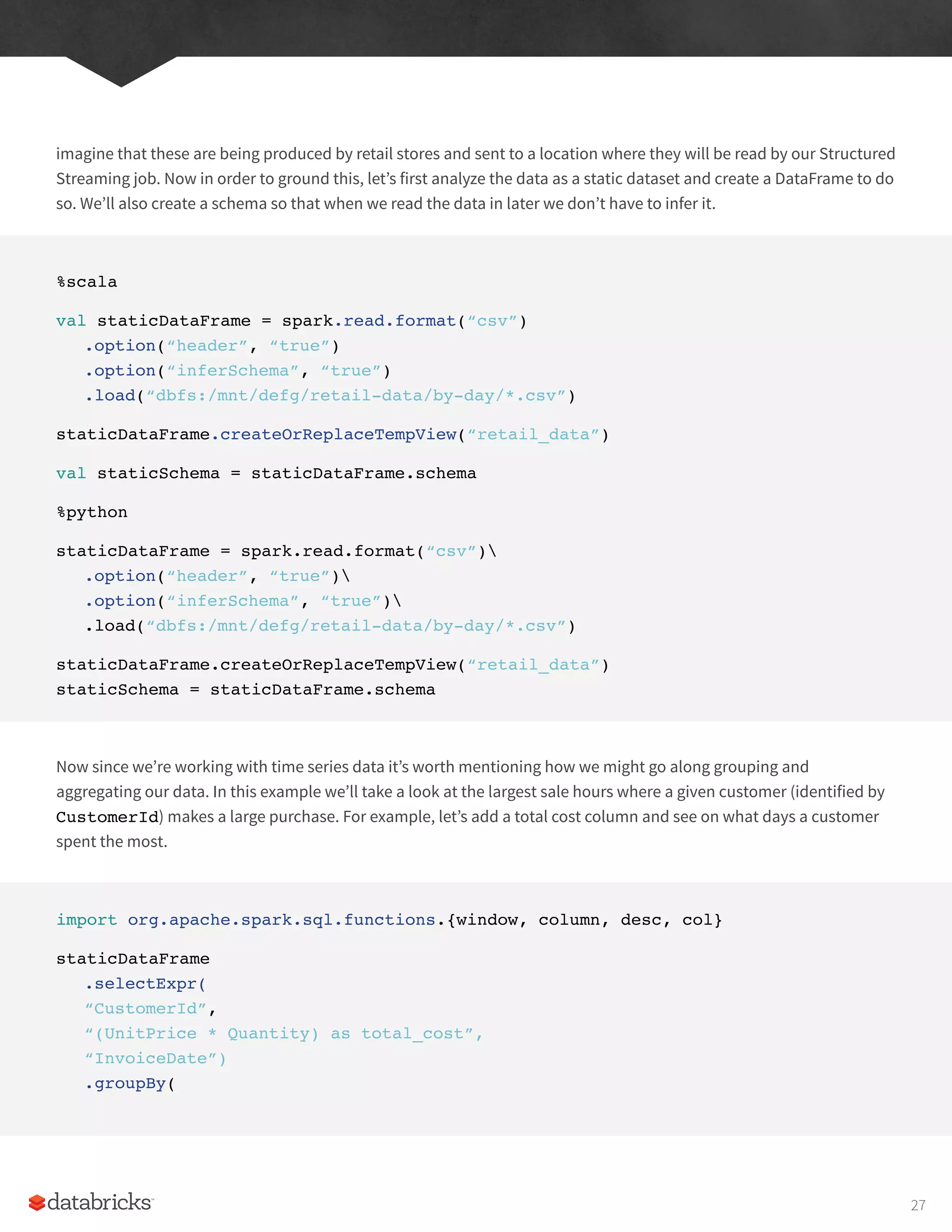
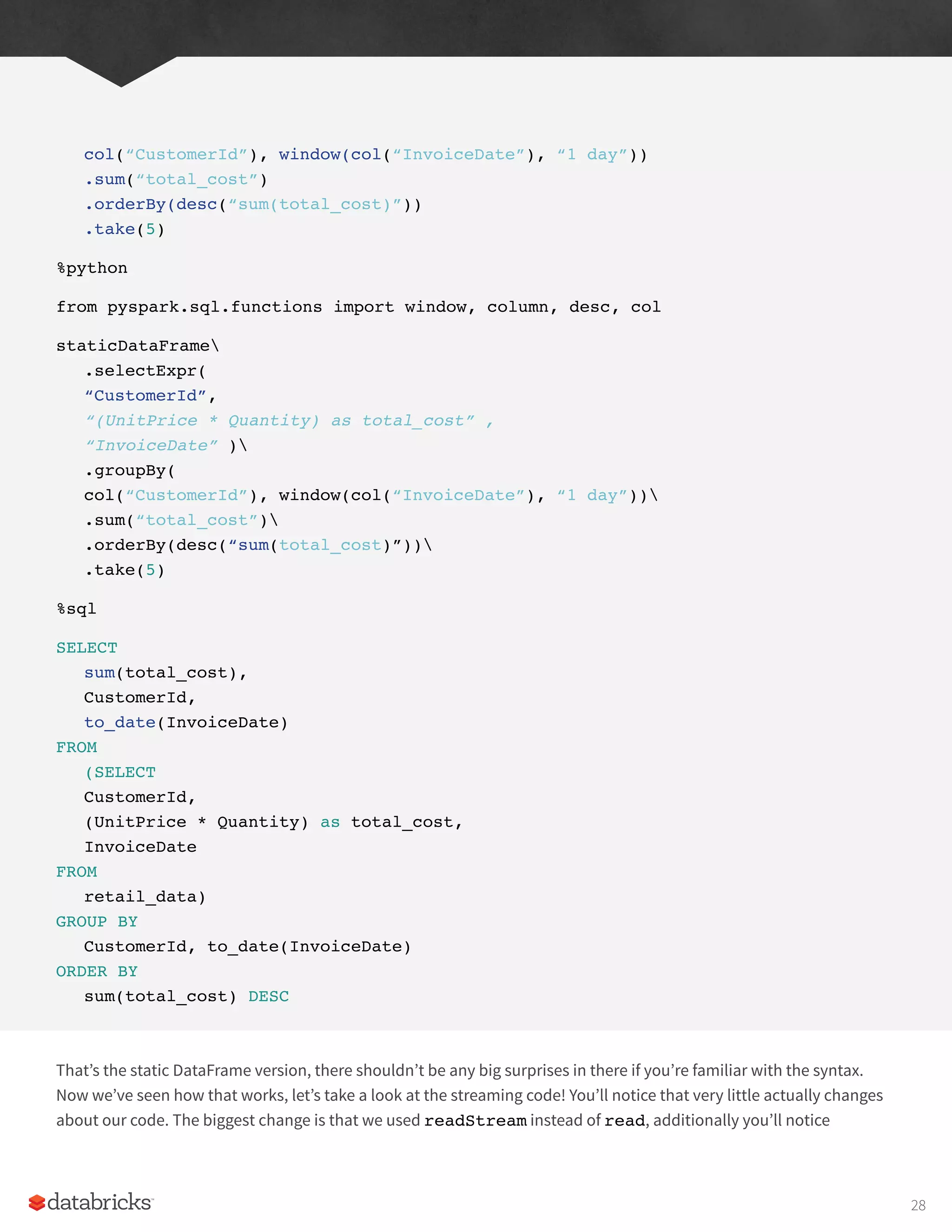

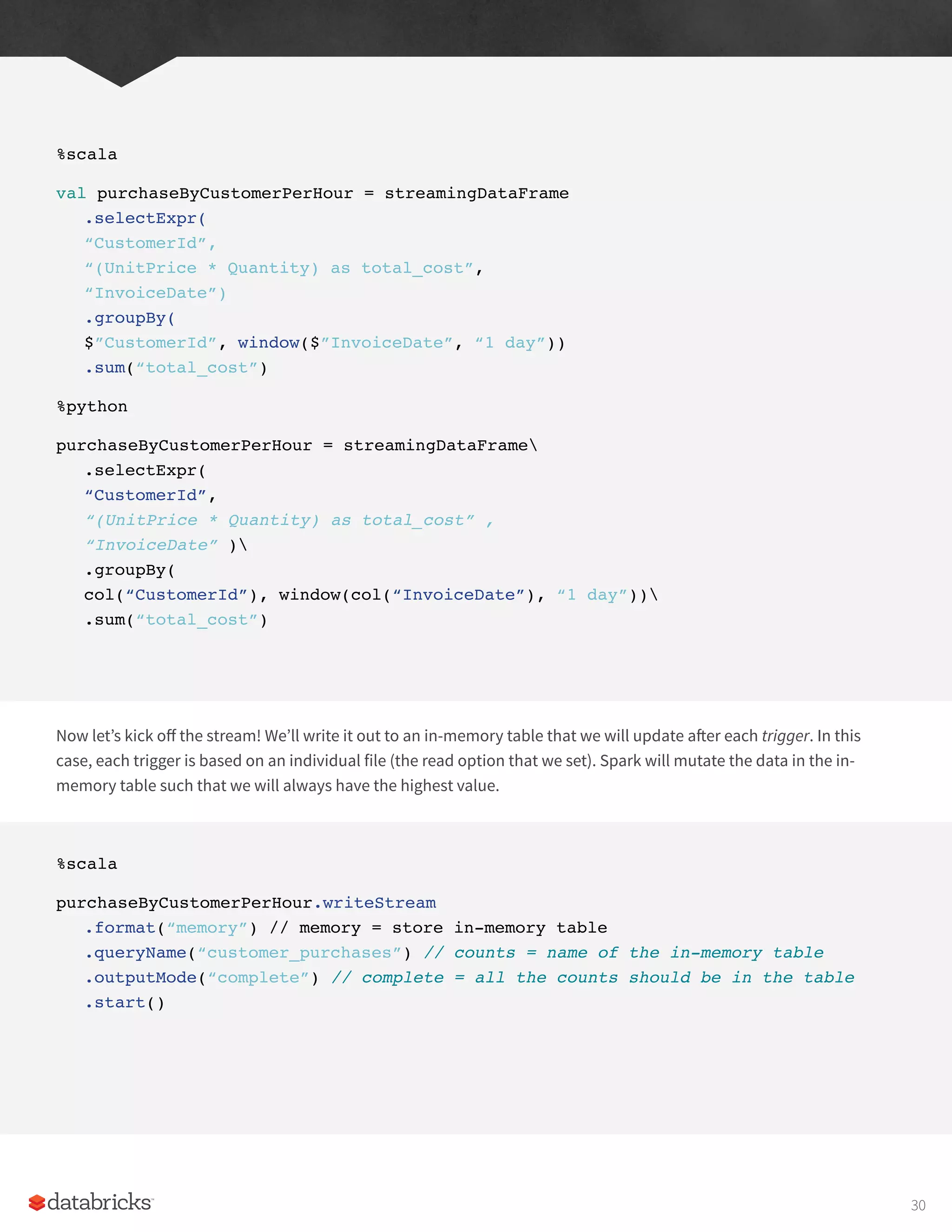
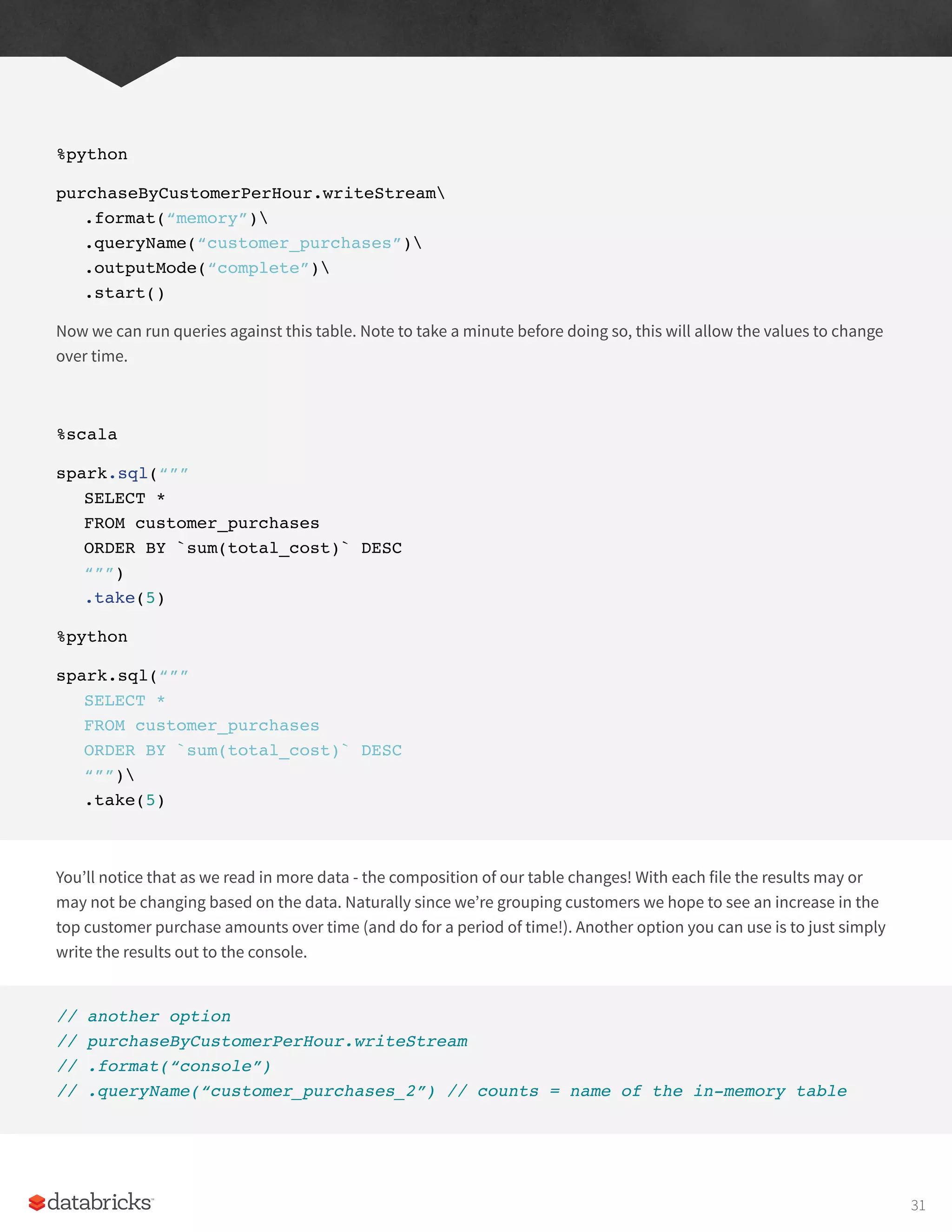
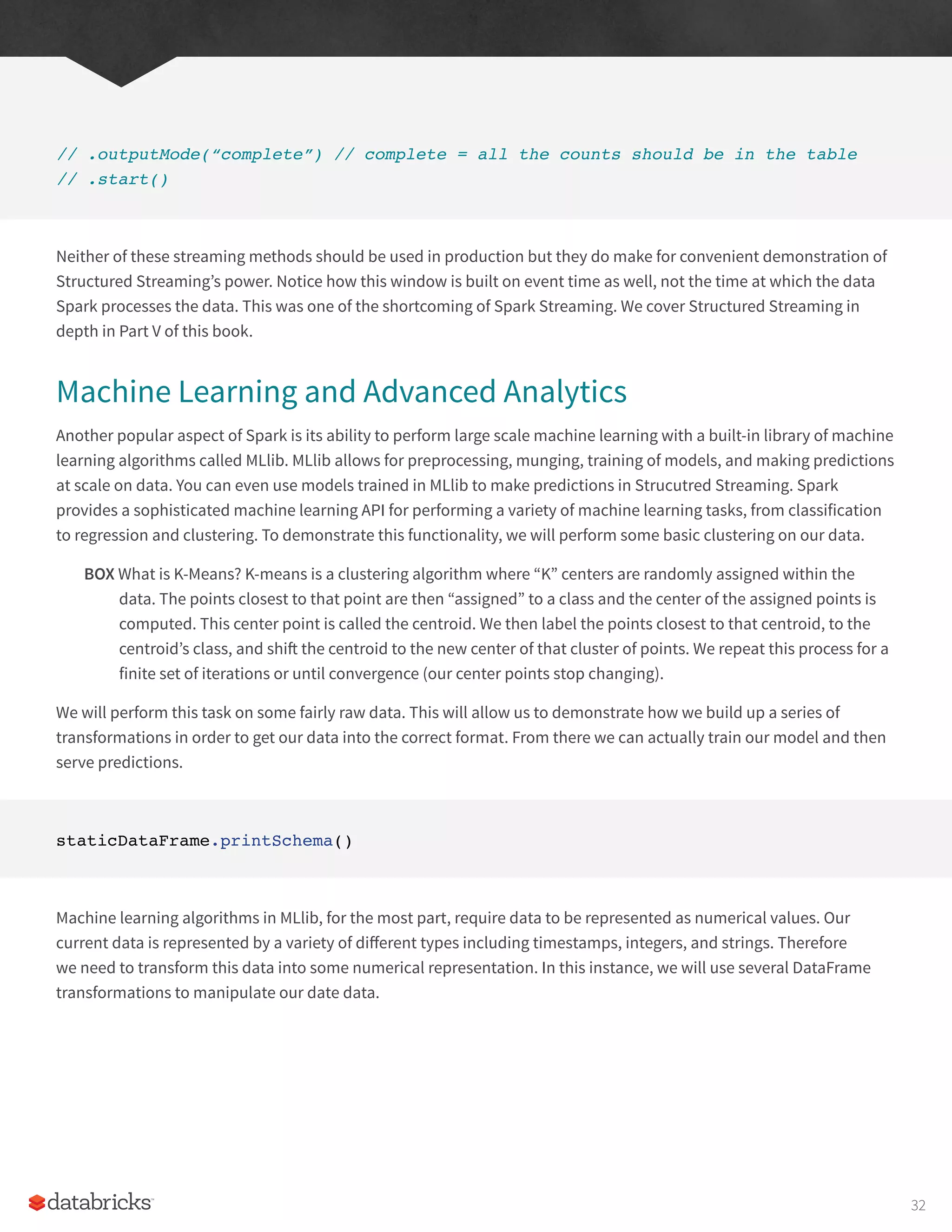
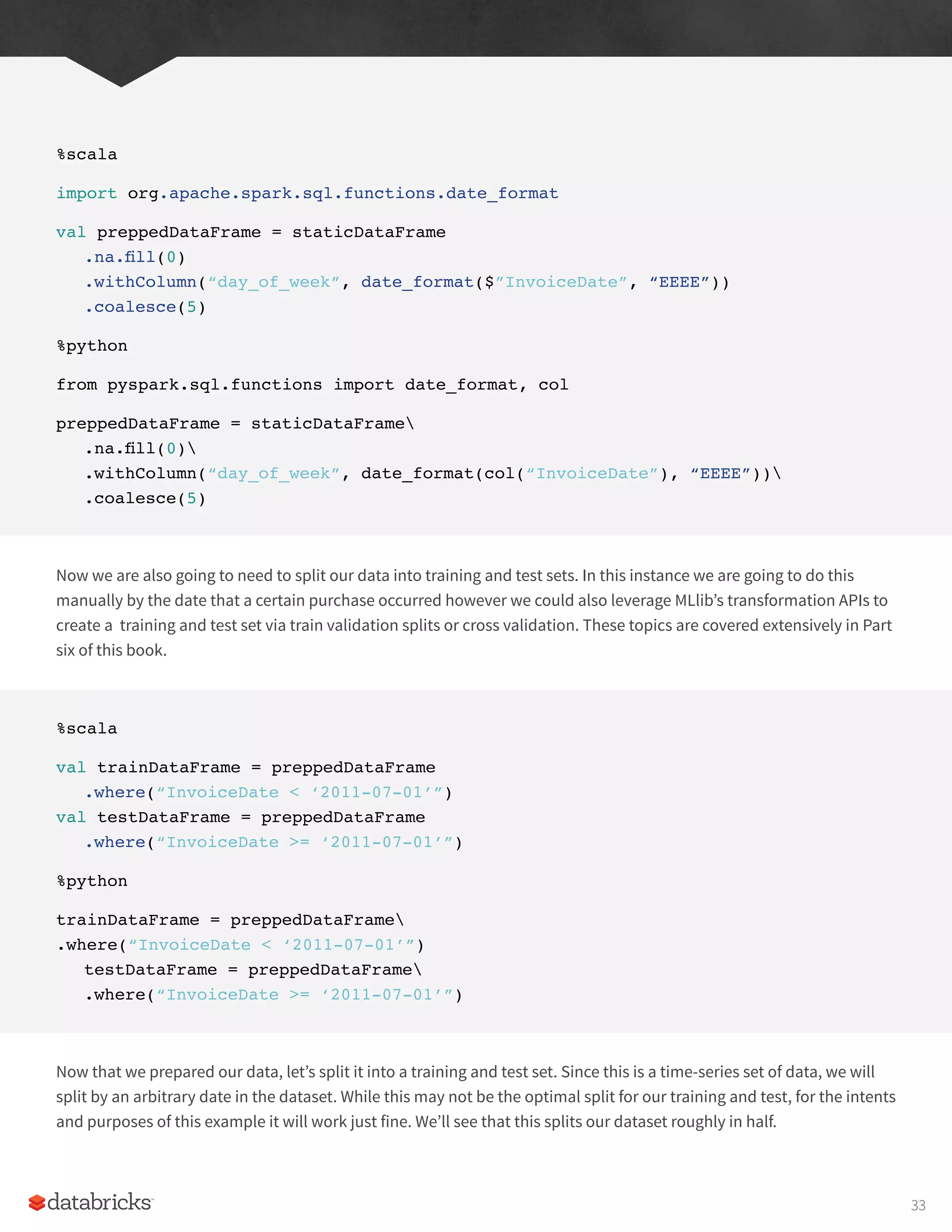
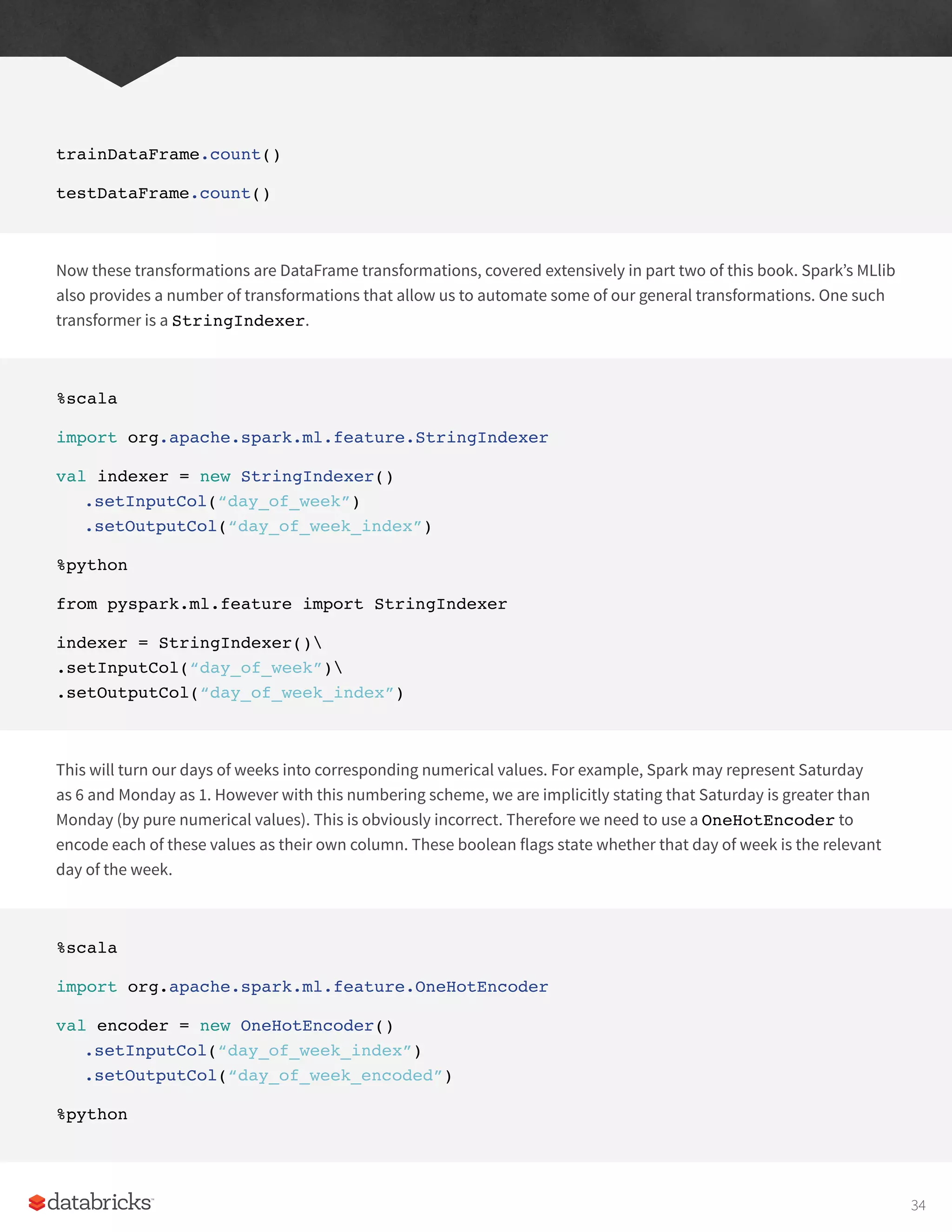
![from pyspark.ml.feature import OneHotEncoder
encoder = OneHotEncoder()
.setInputCol(“day_of_week_index”)
.setOutputCol(“day_of_week_encoded”)
Each of these will result in a set of columns that we will “assemble” into a vector. All machine learning algorithms in
Spark take as input a Vector type, which must be a set of numerical values.
%scala
import org.apache.spark.ml.feature.VectorAssembler
val vectorAssembler = new VectorAssembler()
.setInputCols(Array(“UnitPrice”, “Quantity”, “day_of_week_encoded”))
.setOutputCol(“features”)
%python
from pyspark.ml.feature import VectorAssembler
vectorAssembler = VectorAssembler()
.setInputCols([“UnitPrice”, “Quantity”, “day_of_week_encoded”])
.setOutputCol(“features”)
We can see that we have 4 key features, the price, the quantity, and the day of week. Now we’ll set this up into a
pipeline so any future data we need to transform can go through the exact same process.
%scala
import org.apache.spark.ml.Pipeline
val transformationPipeline = new Pipeline()
.setStages(Array(indexer, encoder, vectorAssembler))
%python
from pyspark.ml import Pipeline
35](https://image.slidesharecdn.com/apache-spark-the-definitive-guide-excerpts-r1-211010030627/75/Apache-spark-the-definitive-guide-excerpts-r1-35-2048.jpg)
![transformationPipeline = Pipeline()
.setStages([indexer, encoder, vectorAssembler])
Now preparing for training is a two step process. We first need to fit our transformers to this dataset. We cover this in
depth, but basically our StringIndexer needs to know how many unique values there are to be index. Once those
exist, encoding is easy but Spark must look at all the distinct values in the column to be indexed in order to store
those values later on.
%scala
val fittedPipeline = transformationPipeline.fit(trainDataFrame)
%python
fittedPipeline = transformationPipeline.fit(trainDataFrame)
Once we fit the training data, we are now create to take that fitted pipeline and use it to transform all of our data in a
consistent and repeatable way.
%scala
val transformedTraining = fittedPipeline.transform(trainDataFrame)
%python
transformedTraining = fittedPipeline.transform(trainDataFrame)
At this point, it’s worth mentioning that we could have included our model training in our pipeline. We chose not to
in order to demonstrate a use case for caching the data. At this point, we’re going to perform some hyperparameter
tuning on the model, since we do not want to repeat the exact same transformations over and over again, we’ll
instead cache our training set. This is worth putting it into memory because that will allow us to efficiently, and
repeatedly access it in an already transformed state. If you’re curious to see how much of a difference this makes,
skip this line and run the training without caching the data. Then try it after caching, you’ll see the results are (very)
significant.
transformedTraining.cache()
36](https://image.slidesharecdn.com/apache-spark-the-definitive-guide-excerpts-r1-211010030627/75/Apache-spark-the-definitive-guide-excerpts-r1-36-2048.jpg)
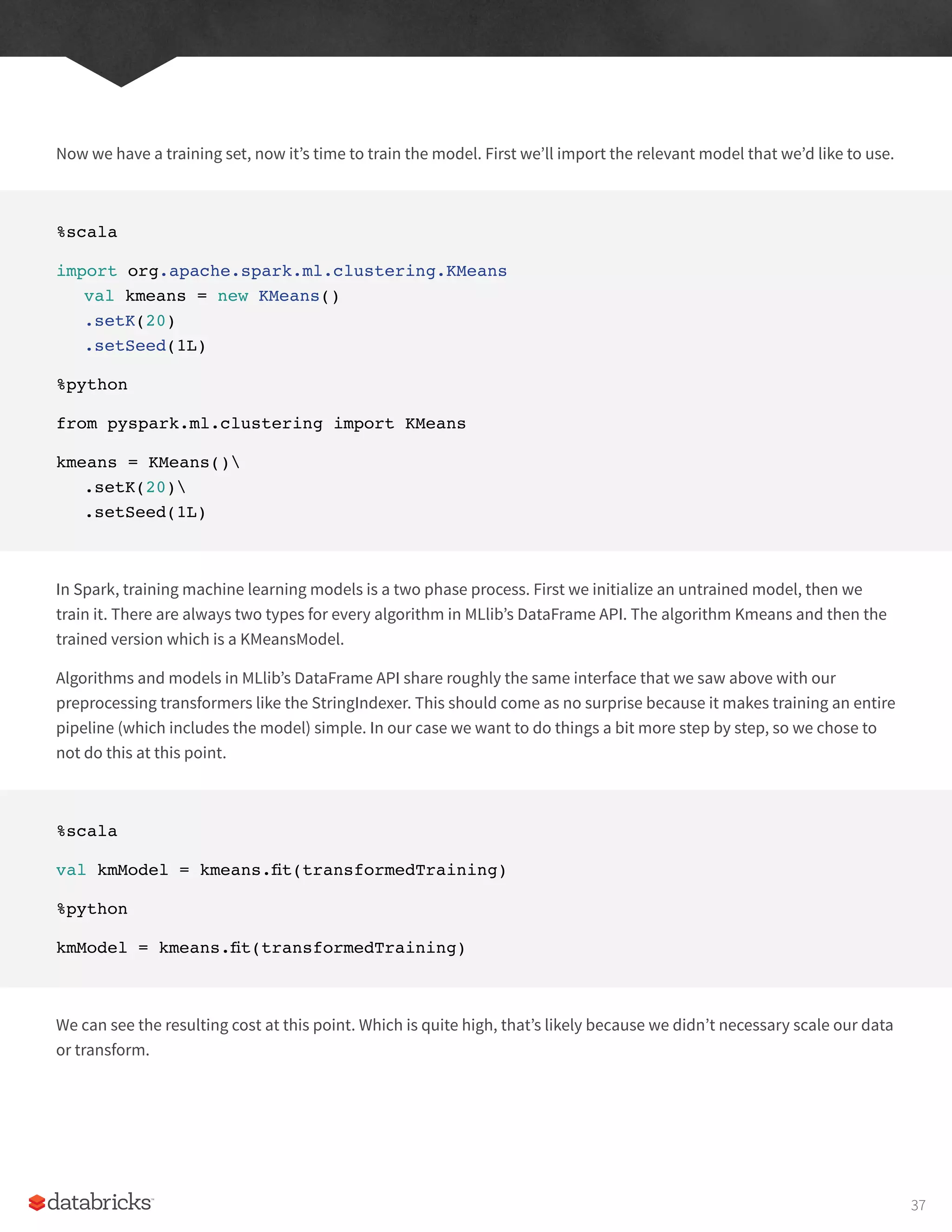
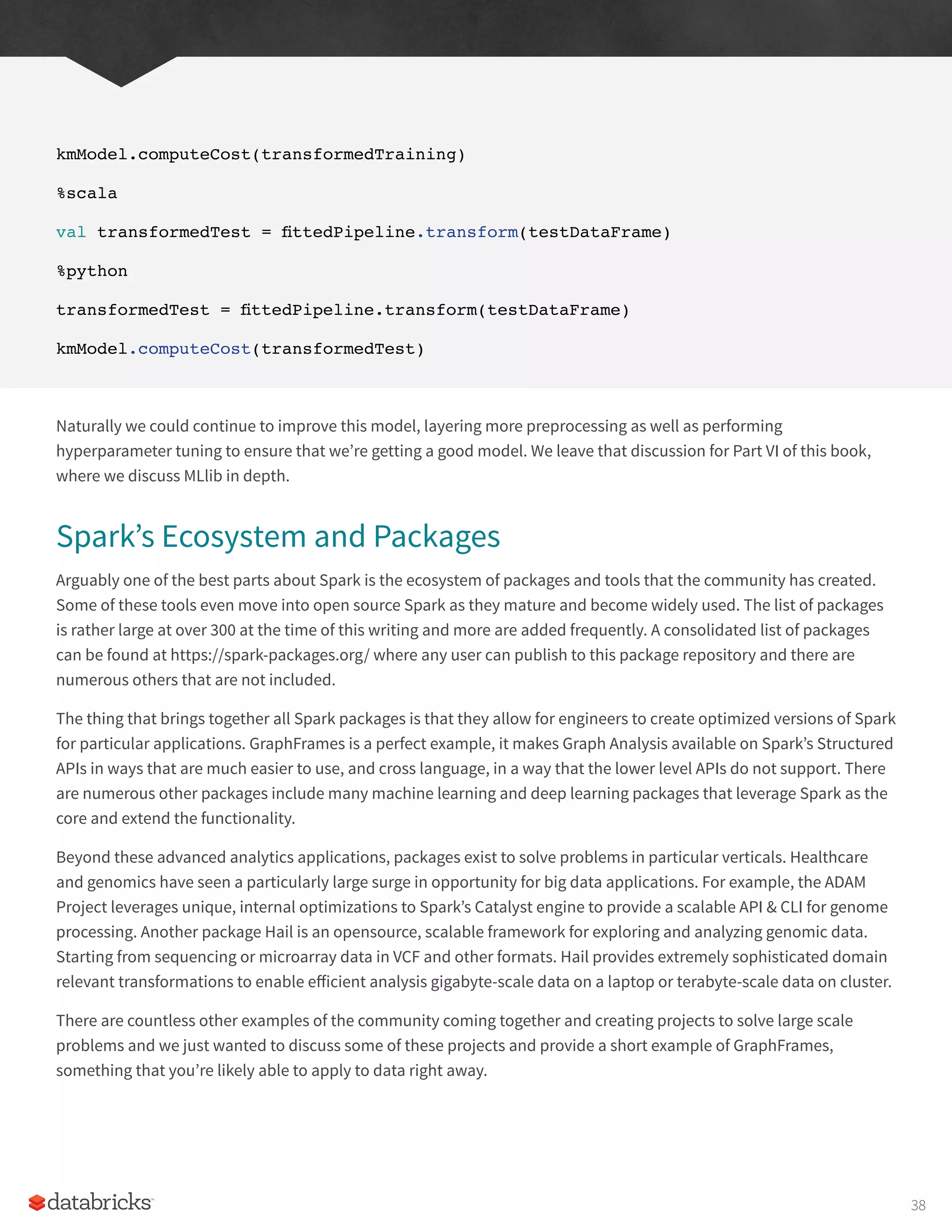
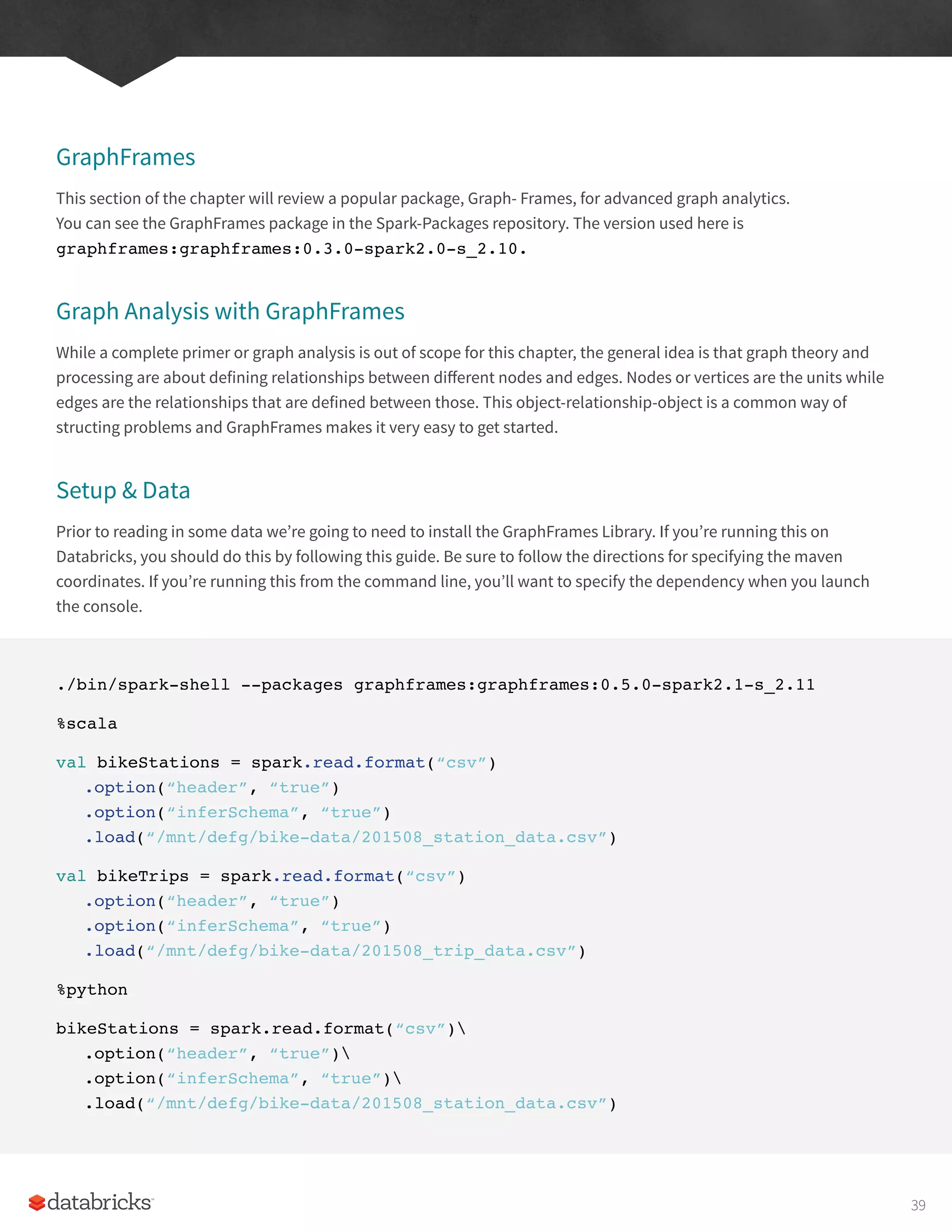
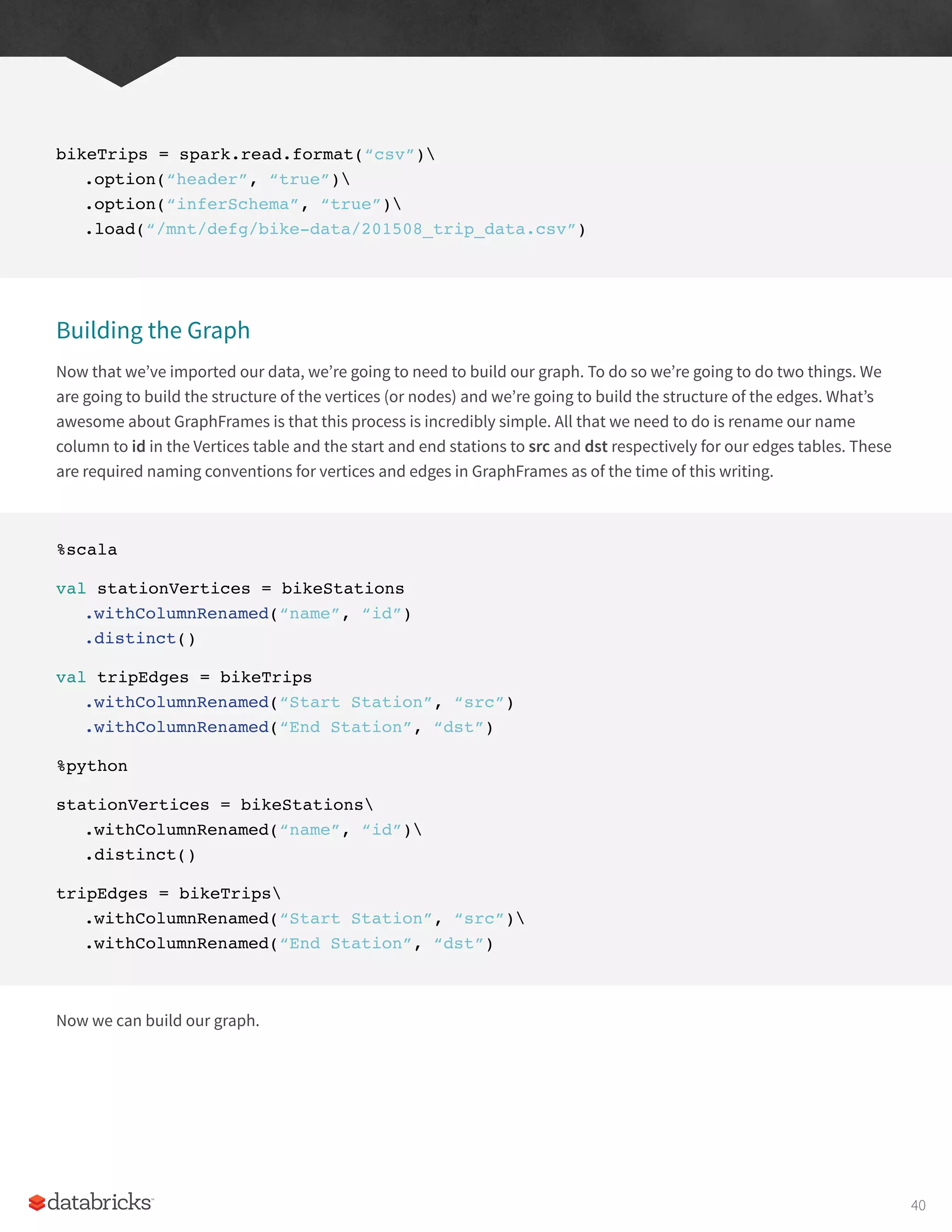
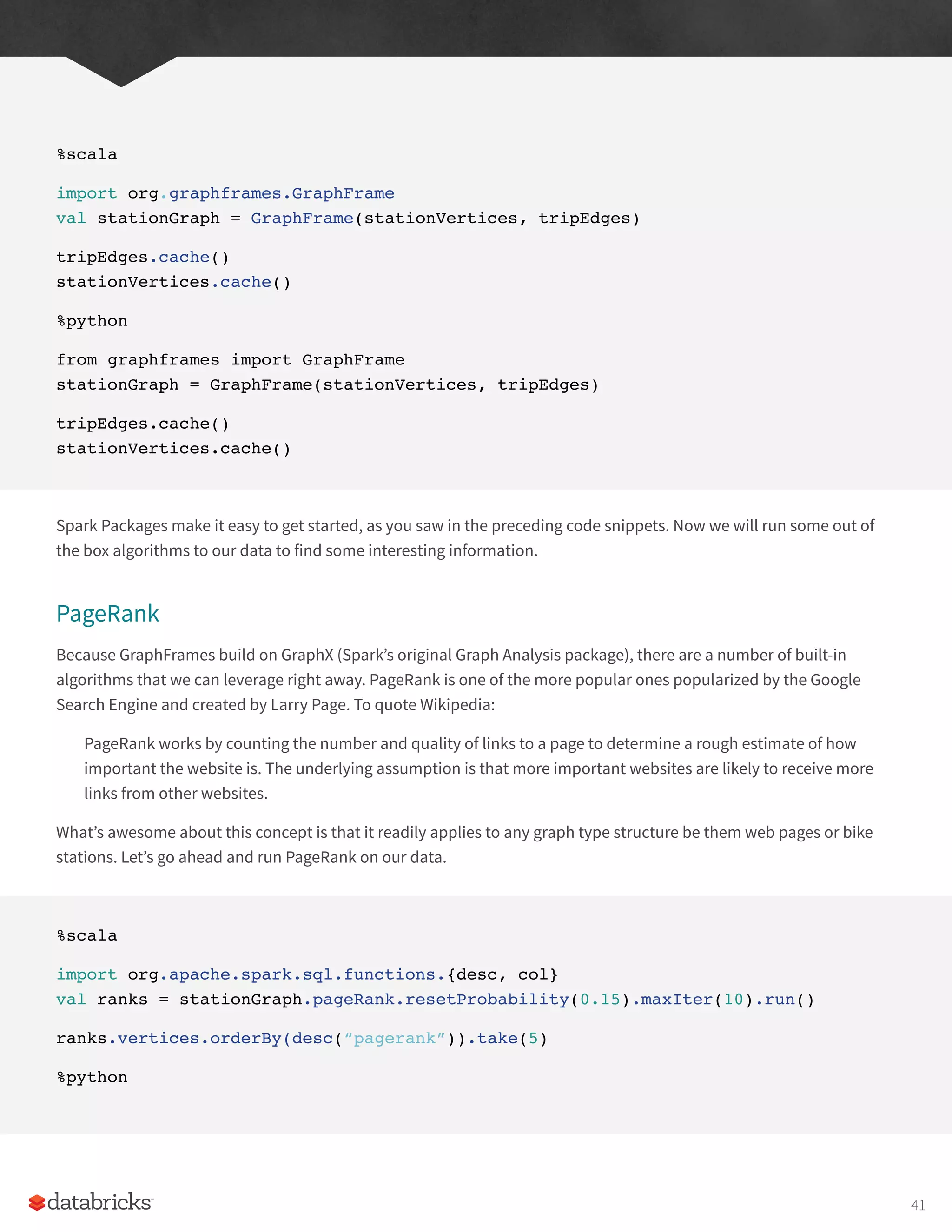
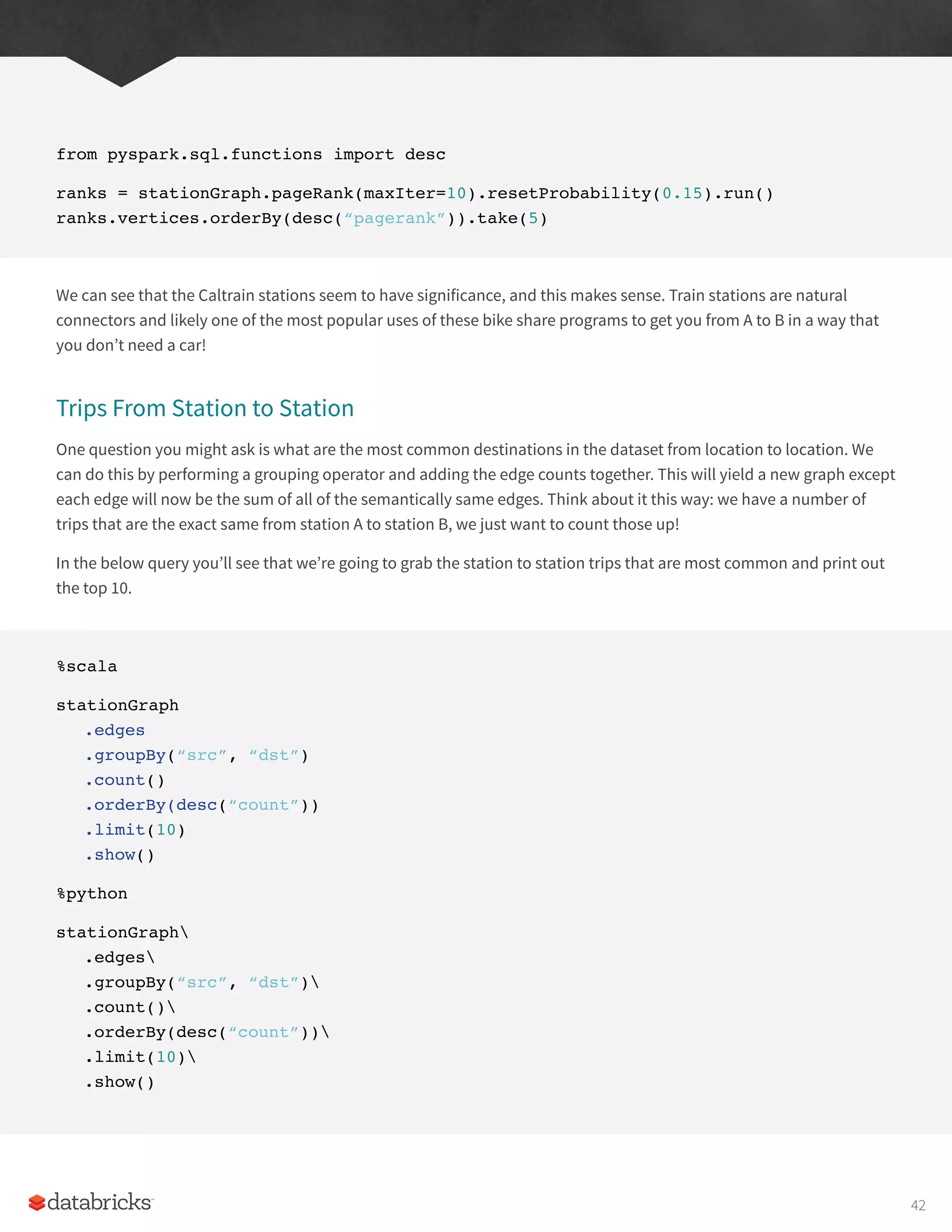

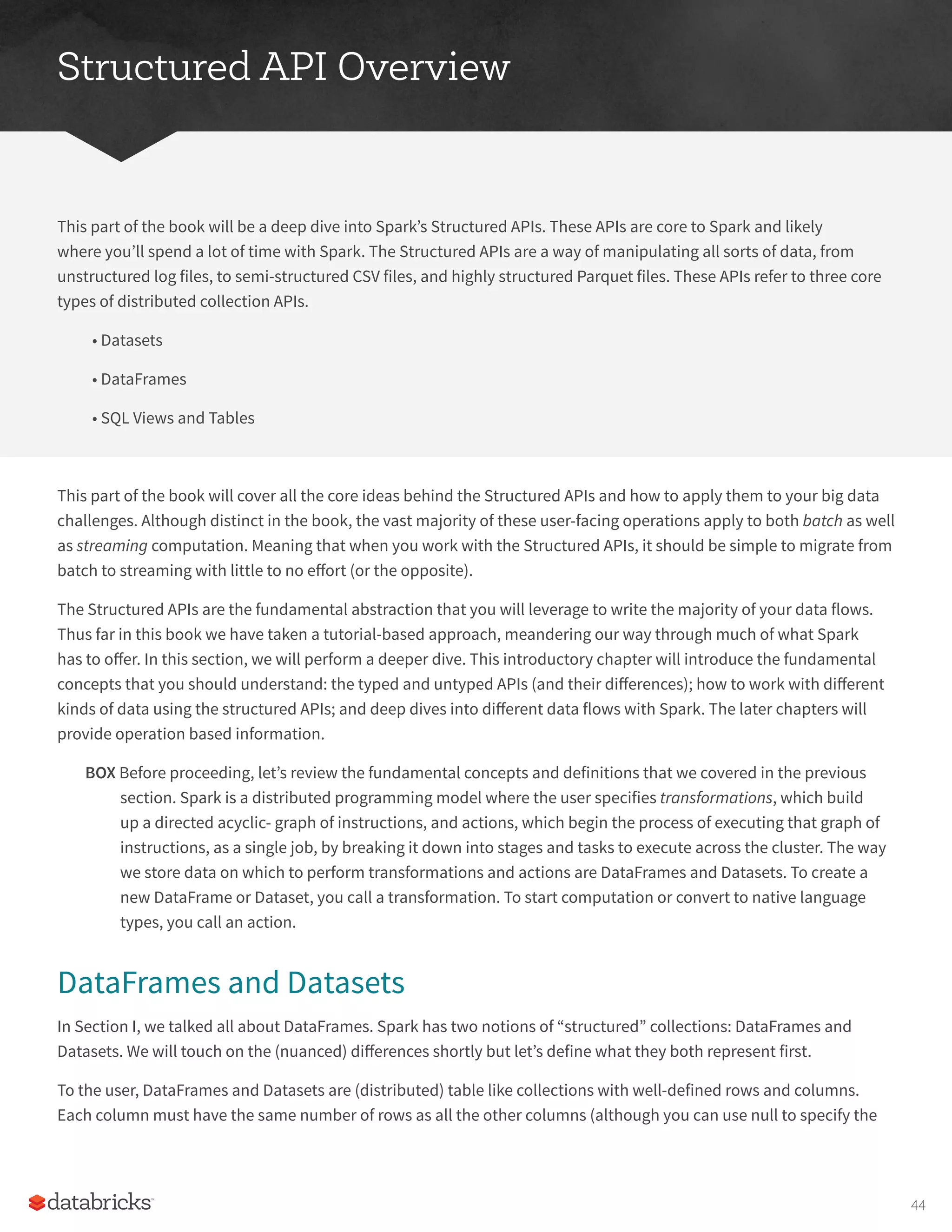
![lack of a value) and columns have type information that must be consistent for every row in the collection. To Spark,
DataFrames and Datasets represent immutable, lazily-evaluated plans that specify what operations to apply to
data residing at a location to generate some output. When we perform an action on a DataFrame we instruct Spark
to perform the actual transformations and return the result. These represent plans of how to manipulate rows and
columns to compute the user’s desired result. Let’s go over rows and column to more precisely define those concepts.
note
Tables and views are basically the same thing as DataFrames. We just execute SQL against them instead of
DataFrame code. We cover all of this in the Spark SQL Chapter later on in Part II of this book.
In order to do that,we should talk about schemas, the way we define the types of data we’re storing in this
distributed collection.
Schemas
A schema defines the column names and types of a DataFrame. Users can define schemas manually or users can
read a schema from a data source (often called schema on read)|. Now that we know what defines DataFrames and
Datasets and how they get their structure, via a Schema, let’s see an overview of all of the types.
Overview of Structured Spark Types
Spark is effectively a programming language of its own. Internally, Spark uses an engine called Catalyst that maintains
its own type information through the planning and processing of work. This may seem like overkill, but it doing so,
this opens up a wide variety of execution optimizations that make significant differences. Spark types map directly
to the different language APIs that Spark maintains and there exists a lookup table for each of these in each of Scala,
Java, Python, SQL, and R. Even if we use Spark’s Structured APIs from Python or R, the majority of our manipulations
will operate strictly on Spark types, not Python types. For example, the below code does not perform addition in Scala
or Python, it actually performs addition purely in Spark.
%scala
val df = spark.range(500).toDF(“number”)
df.select(df.col(“number”) + 10)
// org.apache.spark.sql.DataFrame = [(number + 10): bigint]
%python
df = spark.range(500).toDF(“number”)
df.select(df[“number”] + 10)
# DataFrame[(number + 10): bigint]
45](https://image.slidesharecdn.com/apache-spark-the-definitive-guide-excerpts-r1-211010030627/75/Apache-spark-the-definitive-guide-excerpts-r1-45-2048.jpg)

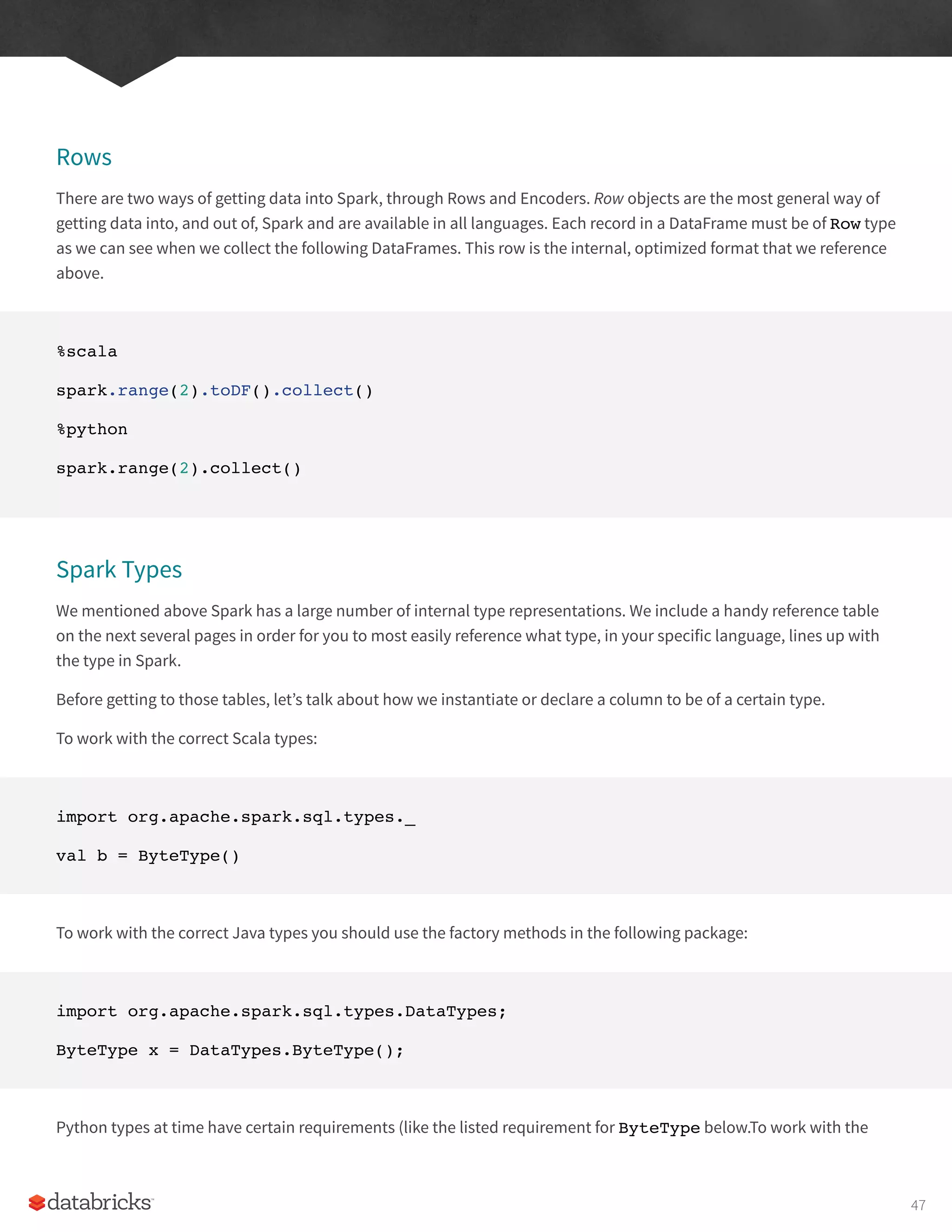
![correct Python types:
from pyspark.sql.types import *
b = byteType()
Scala Type Reference
Data type Value type in Scala API to access or create a data type
ByteType
ShortType
IntegerType
LongType
FloatType
DoubleType
DecimalType
StringType
BinaryType
BooleanType
TimestampType
DateType
ArrayType
MapType
StructType
Struct Field
Byte
Short
Type
Long
Float
Double
java.math.BigDecimal
String
Array [Byte]
Boolean
java.sql.Timestamp
java.sql.Date
scala.collection.Seq
scala.collection.Map
org.apache.spark.sql.Row
The value type in Scala of the data
type of this field (For example, Int
for a StructField with the data type
IntegerType)
ByteType
ShortType
IntegerType
LongType
FloatType
DoubleType
DecimalType
StringType
BinaryType
BooleanType
TimestampType
DateType
ArrayType(elementType, [containsNull]) Note:
The default value of containsNull is true.
MapType (keyType, valueType,
[valuecontainsNull]) Note: The default value
of valuecontainsNull is true.
StructType (fields) Note: fields is a Seq of
StructFields. Also, two fields with the same
name are not allowed.
StructField(name, dataType, [nullable]) Note:
The default value of nullable is true.
48](https://image.slidesharecdn.com/apache-spark-the-definitive-guide-excerpts-r1-211010030627/75/Apache-spark-the-definitive-guide-excerpts-r1-48-2048.jpg)
![Java Type Reference
Data type Value type in Java API to access or create a data type
ByteType
ShortType
IntegerType
LongType
FloatType
DoubleType
DecimalType
StringType
BinaryType
BooleanType
TimestampType
DateType
ArrayType
MapType
StructType
Struct Field
byte or Byte
short or Short
integer or Integer
long or Long
float or Float
double or Double
java.math.BigDecimal
String
byte []
boolean or Boolean
java.sql.Timestamp
java.sql.Date
java.util.List
java.util.Map
org.apache.spark.sql.Row
Field value type in Java of the data
type of this field (For example, int
for a StructField with the data type
IntegerType)
DataTypes.ByteType
DataTypes.ShortType
DataTypes.IntegerType
DataTypes.LongType
DataTypes.FloatType
DataTypes.DoubleType
DataTypes.DecimalType
DataTypes.StringType
DataTypes.BinaryType
DataTypes.BooleanType
DataTypes.TimestampType
DataTypes.DateType
DataTypes.createArrayType(elementType)
Note: The value of containsNull will be true
DataTypes.createArrayType(elementType,
containsNull).
DataTypes.createMapType(keyType,
valueType) Note: The value of
valueContainsNull will be true. DataTypes.
createMapType(keyType, valueType,
valueContainsNull)
DataTypes.createStructType(fields) Note:
fields is a List or an array of StructFields.
Also, two fields with the same name are not
allowed.
DataTypes.createStructField(name, dataType,
nullable)
49](https://image.slidesharecdn.com/apache-spark-the-definitive-guide-excerpts-r1-211010030627/75/Apache-spark-the-definitive-guide-excerpts-r1-49-2048.jpg)
![Python Type Reference
Data type Value type in Python API to access or create a data type
ByteType
ShortType
IntegerType
LongType
FloatType
DoubleType
DecimalType
StringType
BinaryType
BooleanType
TimestampType
DateType
ArrayType
MapType
StructType
intor long Note: Numbers will be
converted to 1-byte signed integer
numbers at runtime. Please make sure
that numbers are within the range of
-128 to 127.
intor long Note: Numbers will be
converted to 2-byte signed integer
numbers at runtime. Please make sure
that numbers are within the range of
-32768 to 32767.
type long
long Note: Numbers will be
converted to 8-byte signed integer
numbers at runtime. Please make
sure that numbers are within the
range of -9223372036854775808 to
9223372036854775807. Otherwise,
please convert data to decimal.Decimal
and use DecimalType.
float Note: Numbers will be converted
to 4-byte single-precision floating point
numbers at runtime.
float
decimal.Decimal
string
bytearray
bool
datetime.datetime
datetime.date
list, tuple, or array
dict
Field value type in Java of the data
type of this field (For example, int
for a StructField with the data type
IntegerType)
ByteType()
ShortType()
IntegerType()
LongType()
FloatType()
DoubleType()
DecimalType()
StringType()
BinaryType()
BooleanType()
TimestampType()
DateType()
ArrayType(elementType, [containsNull]) Note:
The default value of containsNull is True.
MapType(keyType, valueType,
[valueContainsNull]) Note: The default value
of valueContainsNull is True.
StructType(fields) Note: fields is a Seq of
StructFields. Also, two fields with the same
name are not allowed.
50](https://image.slidesharecdn.com/apache-spark-the-definitive-guide-excerpts-r1-211010030627/75/Apache-spark-the-definitive-guide-excerpts-r1-50-2048.jpg)
![SQL
Datasets
DataFrames
Catalyst optimizer Physical plan
Python Type Reference (cont.)
Data type Value type in Python API to access or create a data type
Struct Field The value type in Python of the data
type of this field (For example, Int
for a StructField with the data type
IntegerType)
StructField(name, dataType, [nullable]) Note:
The default value of nullable is True.
It’s worth keeping in mind that the types may change over time and there may be truncation (especially when
dealing with certain languages lack of precise data types). It’s always worth checking the documentation for the most
up to date information.
Overview of Structured API Execution
In order to help you understand (and potentially debug) the process of writing and executing code on clusters, let’s
walk through the execution of a single structured API query from user code to executed code. As an overview the
steps are:
1. Write DataFrame/Dataset/SQL Code
2. If valid code, Spark converts this to a Logical Plan
3. Spark transforms this Logical Plan to a Physical Plan
4. Spark then executes this Physical Plan on the cluster
To execute code, we have to write code. This code is then submitted to Spark either through the console or via a
submitted job. This code then passes through the Catalyst Optimizer which decides how the code should be executed
and lays out a plan for doing so, before finally the code is run and the result is returned to the user.
Figure
51](https://image.slidesharecdn.com/apache-spark-the-definitive-guide-excerpts-r1-211010030627/75/Apache-spark-the-definitive-guide-excerpts-r1-51-2048.jpg)
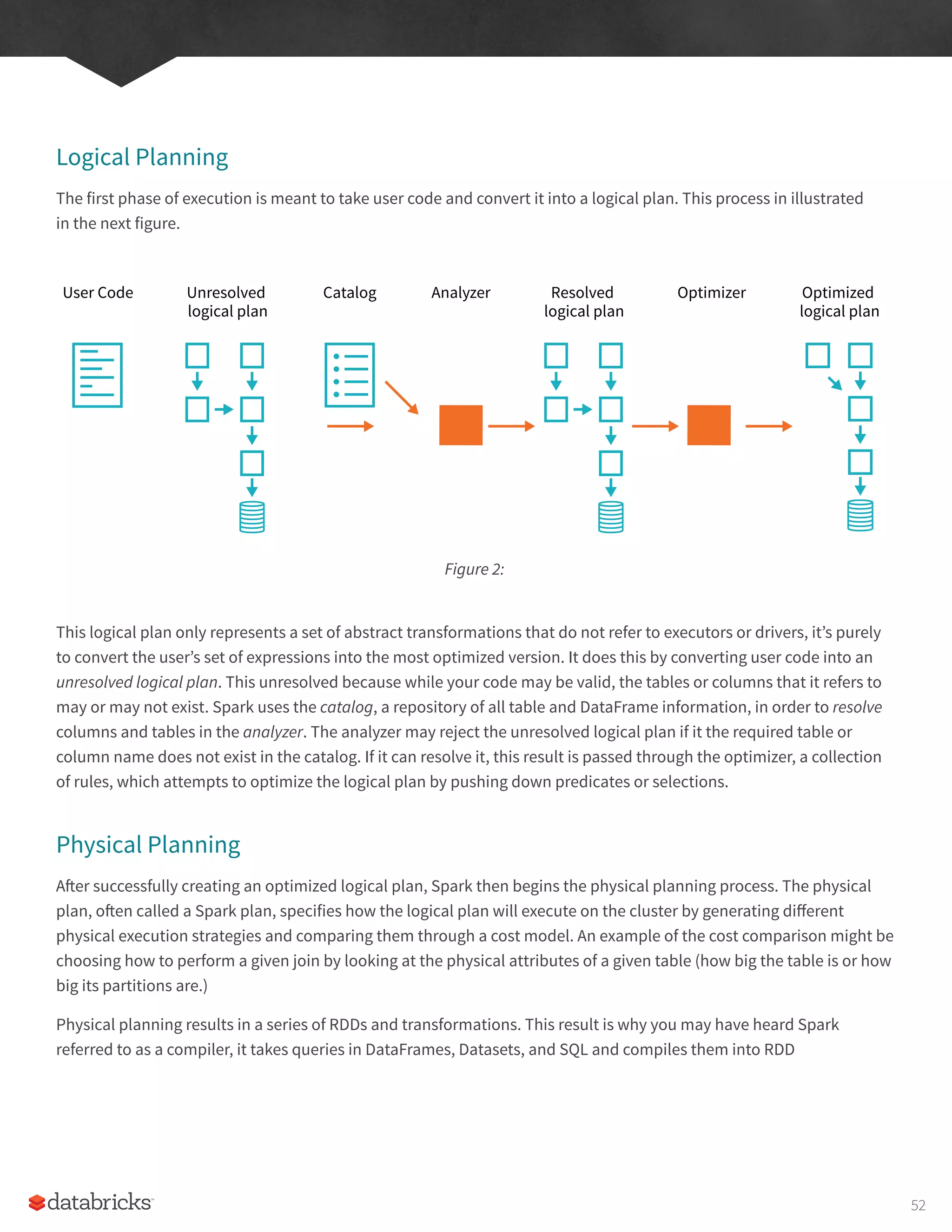
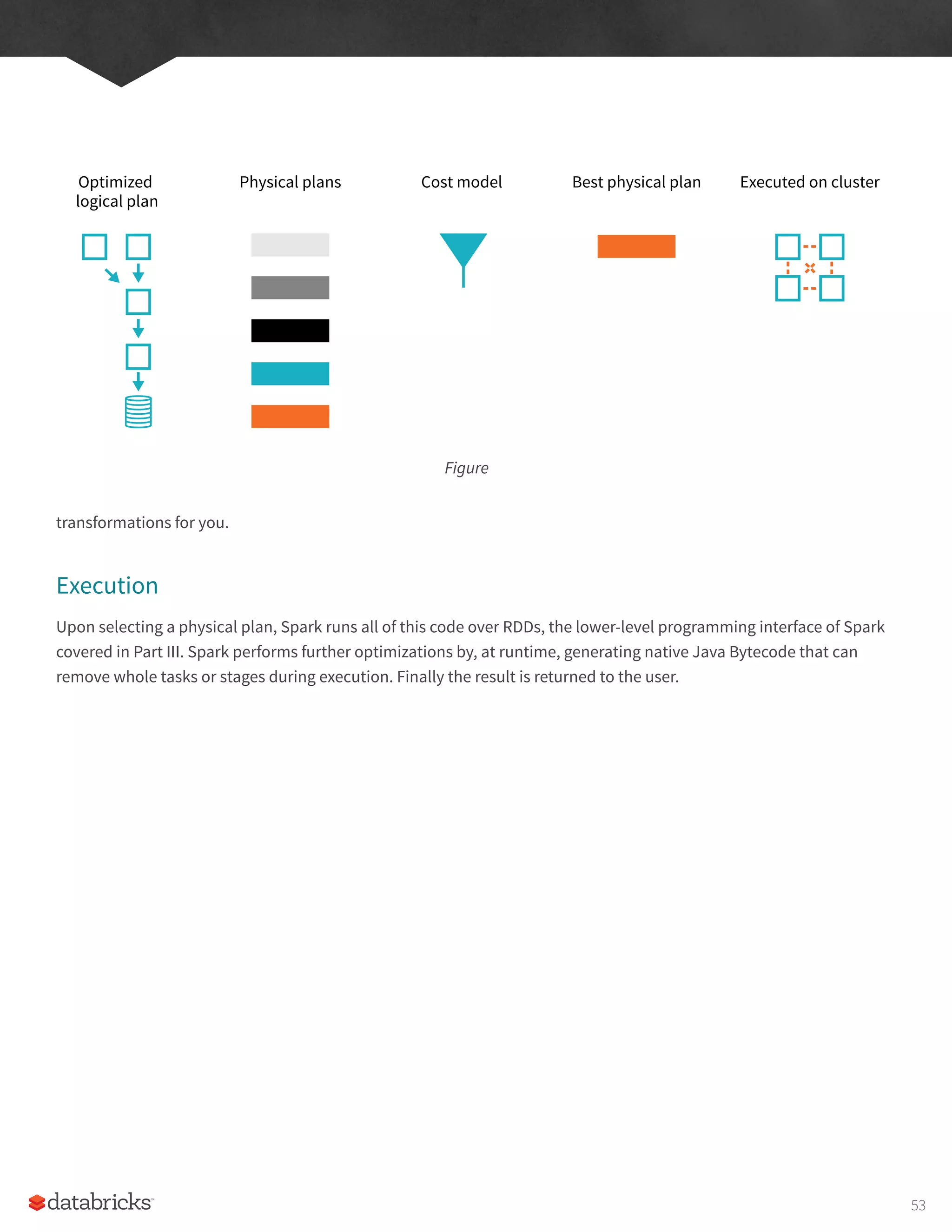
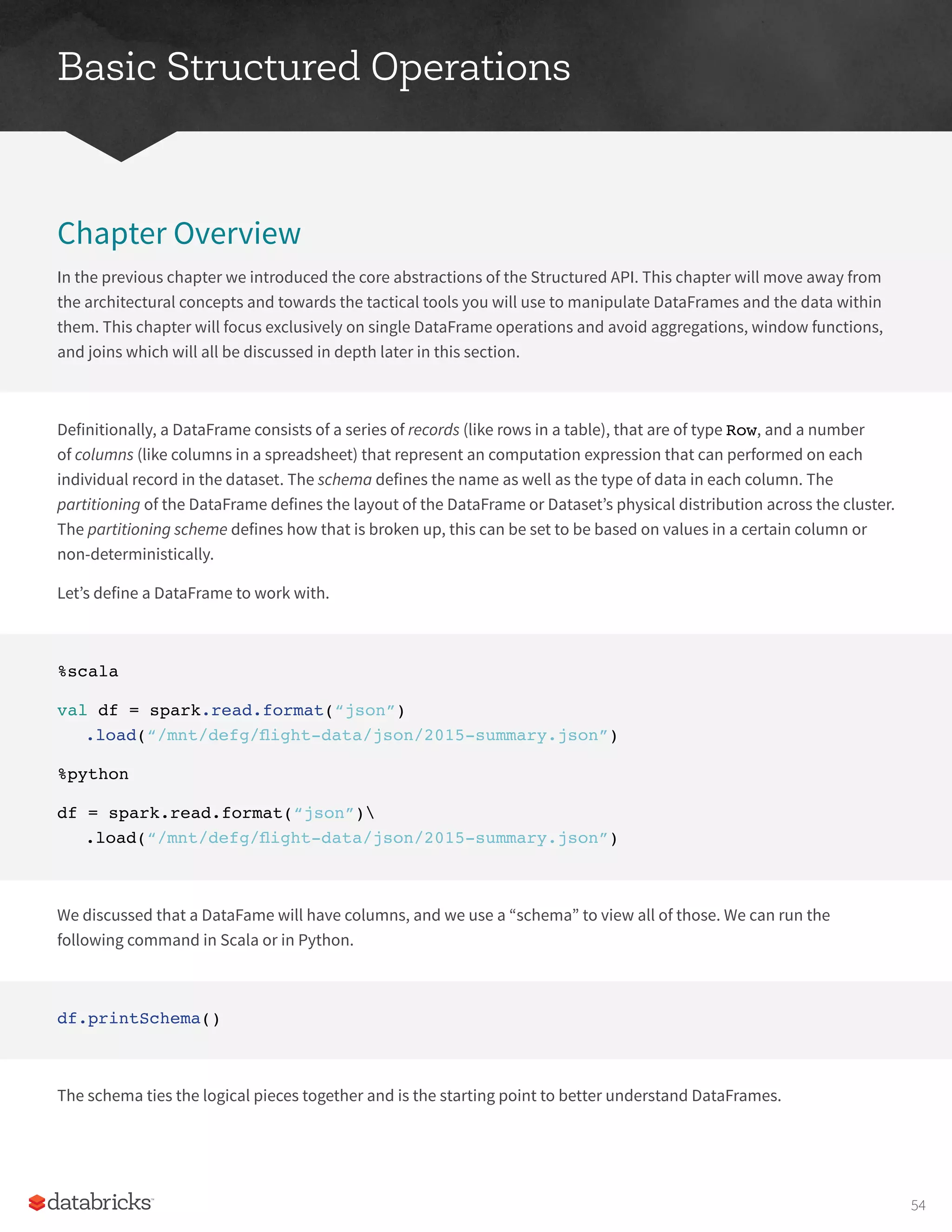
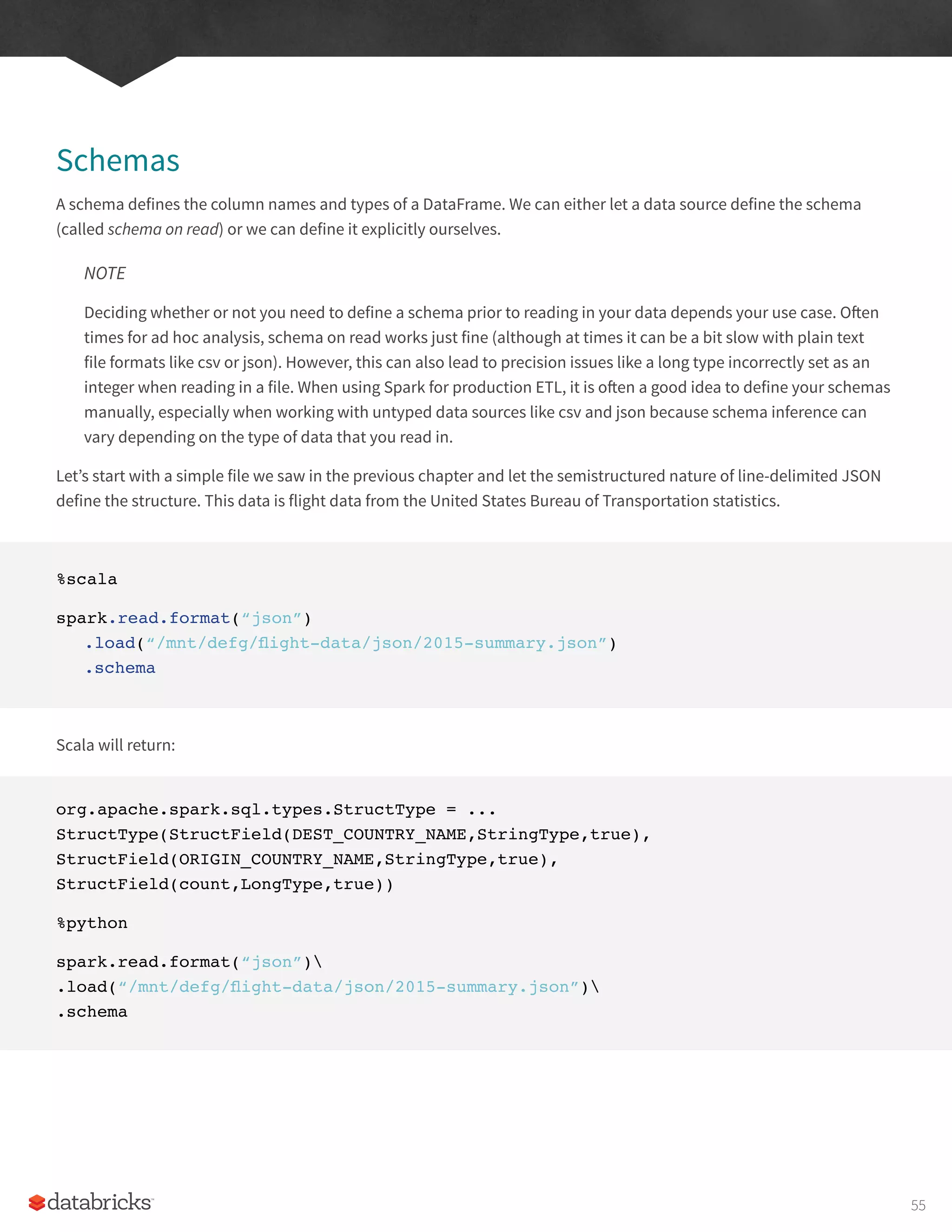
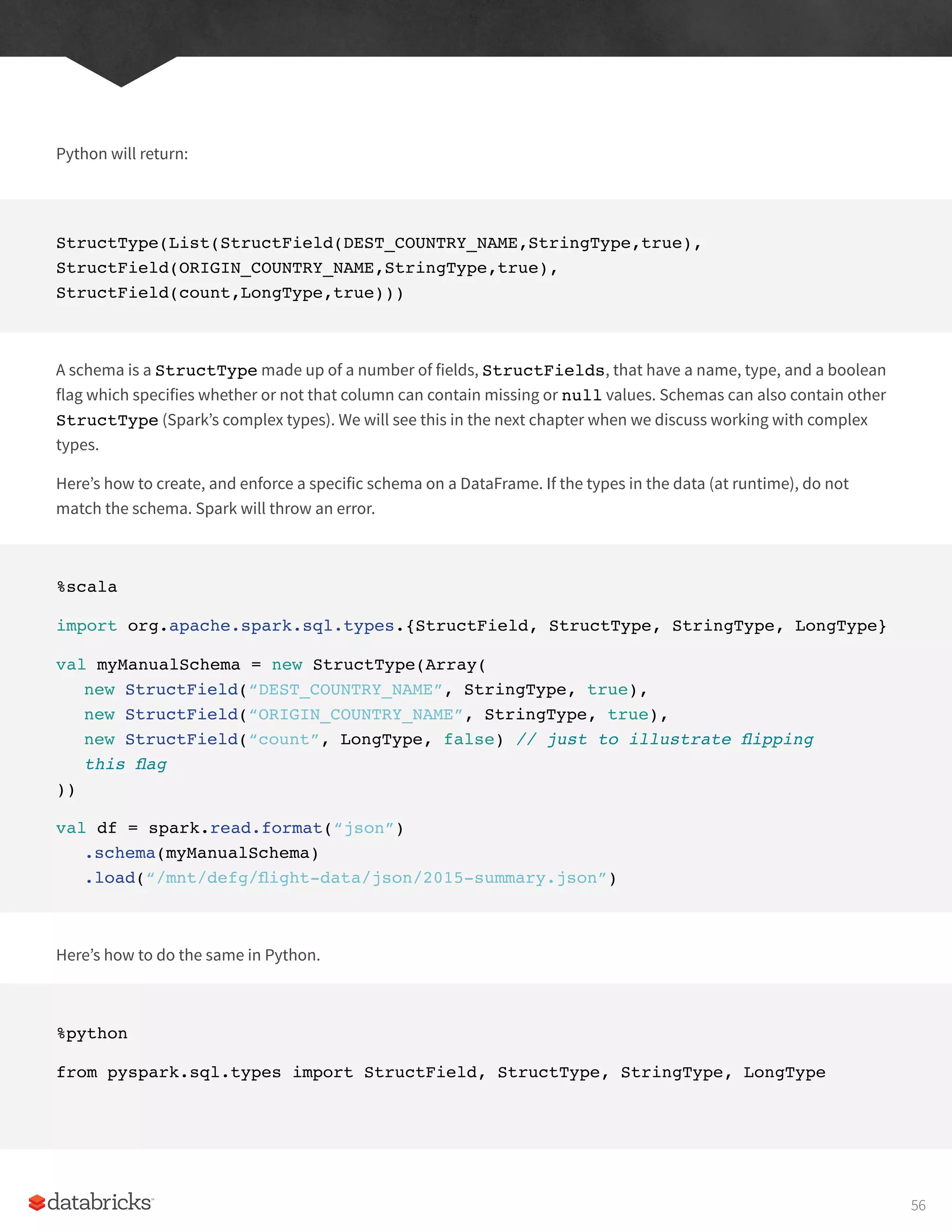
![myManualSchema = StructType([
StructField(“DEST_COUNTRY_NAME”, StringType(), True),
StructField(“ORIGIN_COUNTRY_NAME”, StringType(), True),
StructField(“count”, LongType(), False)
])
df = spark.read.format(“json”)
.schema(myManualSchema)
.load(“/mnt/defg/flight-data/json/2015-summary.json”)
As discussed in the previous chapter, we cannot simply set types via the per language types because Spark maintains
its own type information. Let’s now discuss what schemas define, columns.
Columns and Expressions
To users, columns in Spark are similar to columns in a spreadsheet, R dataframe, pandas DataFrame. We can select,
manipulate, and remove columns from DataFrames and these operations are represented as expressions.
To Spark, columns are logical constructions that simply represent a value computed on a per-record basis by means
of an expression. This means, in order to have a real value for a column, we need to have a row, and in order to
have a row we need to have a DataFrame. This means that we cannot manipulate an actual column outside of a
DataFrame, we can only manipulate a logical column’s expressions then perform that expression within the context of
a DataFrame.
Columns
There are a lot of different ways to construct and or refer to columns but the two simplest ways are with the col or
column functions. To use either of these functions, we pass in a column name.
%scala
import org.apache.spark.sql.functions.{col, column}
col(“someColumnName”)
column(“someColumnName”)
%python
from pyspark.sql.functions import col, column
col(“someColumnName”)
57](https://image.slidesharecdn.com/apache-spark-the-definitive-guide-excerpts-r1-211010030627/75/Apache-spark-the-definitive-guide-excerpts-r1-57-2048.jpg)
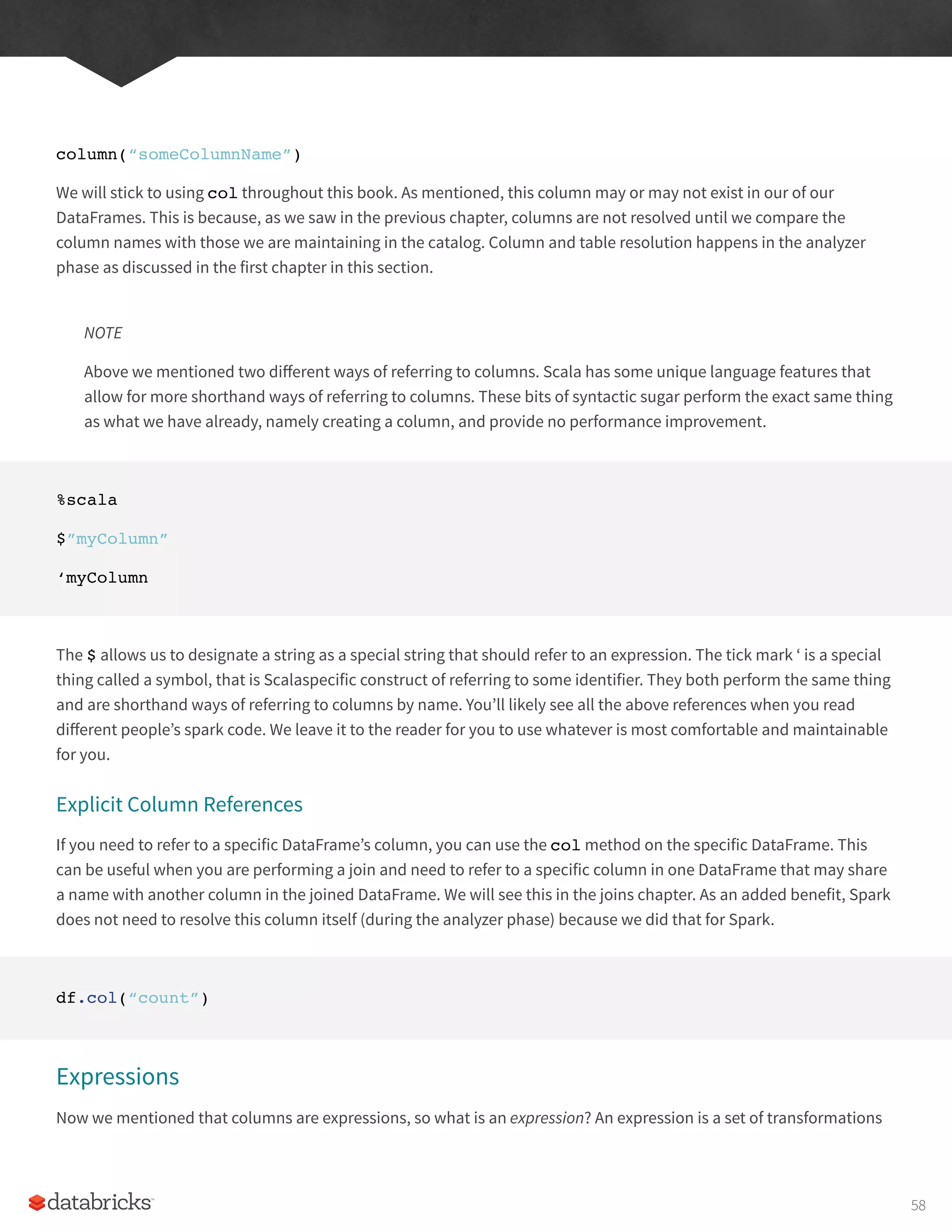
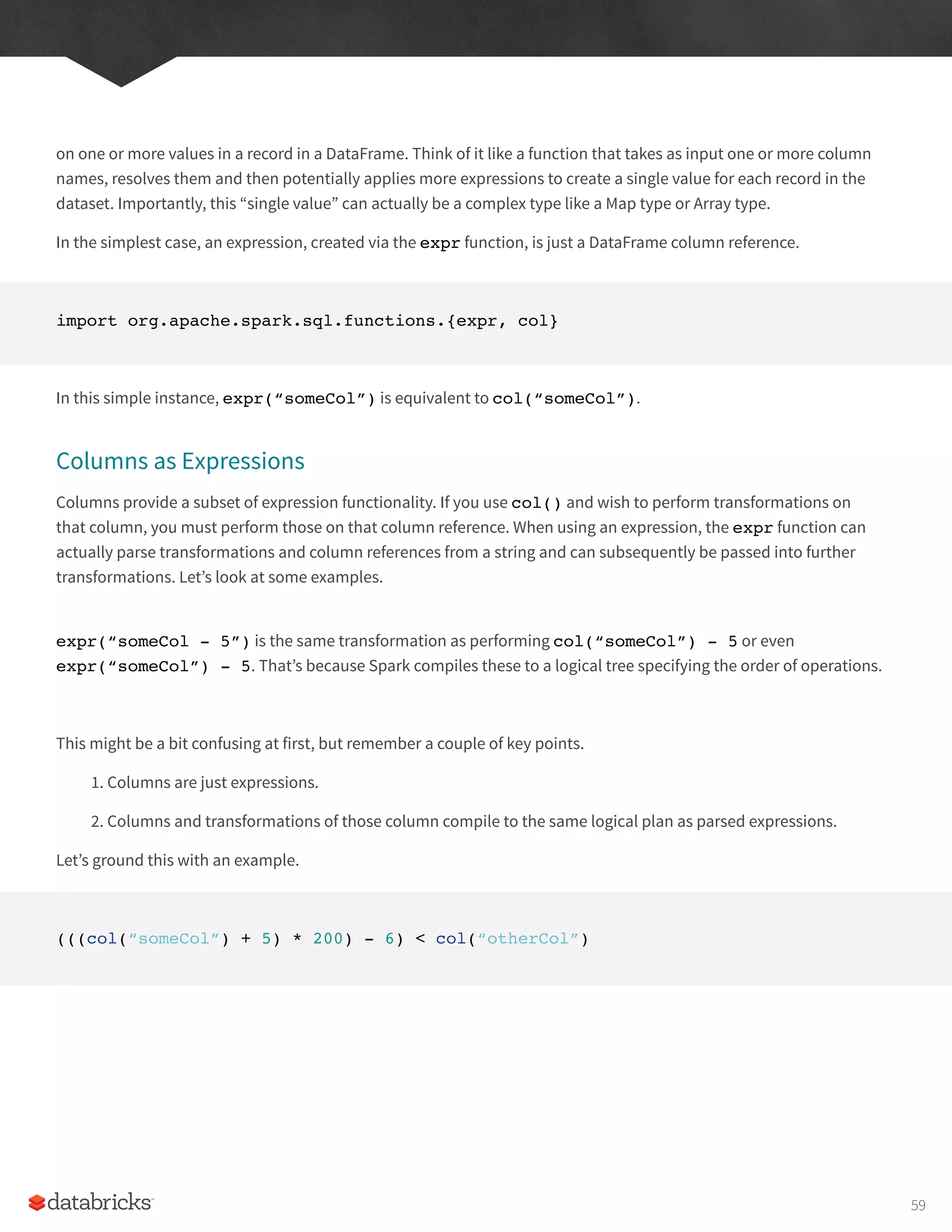
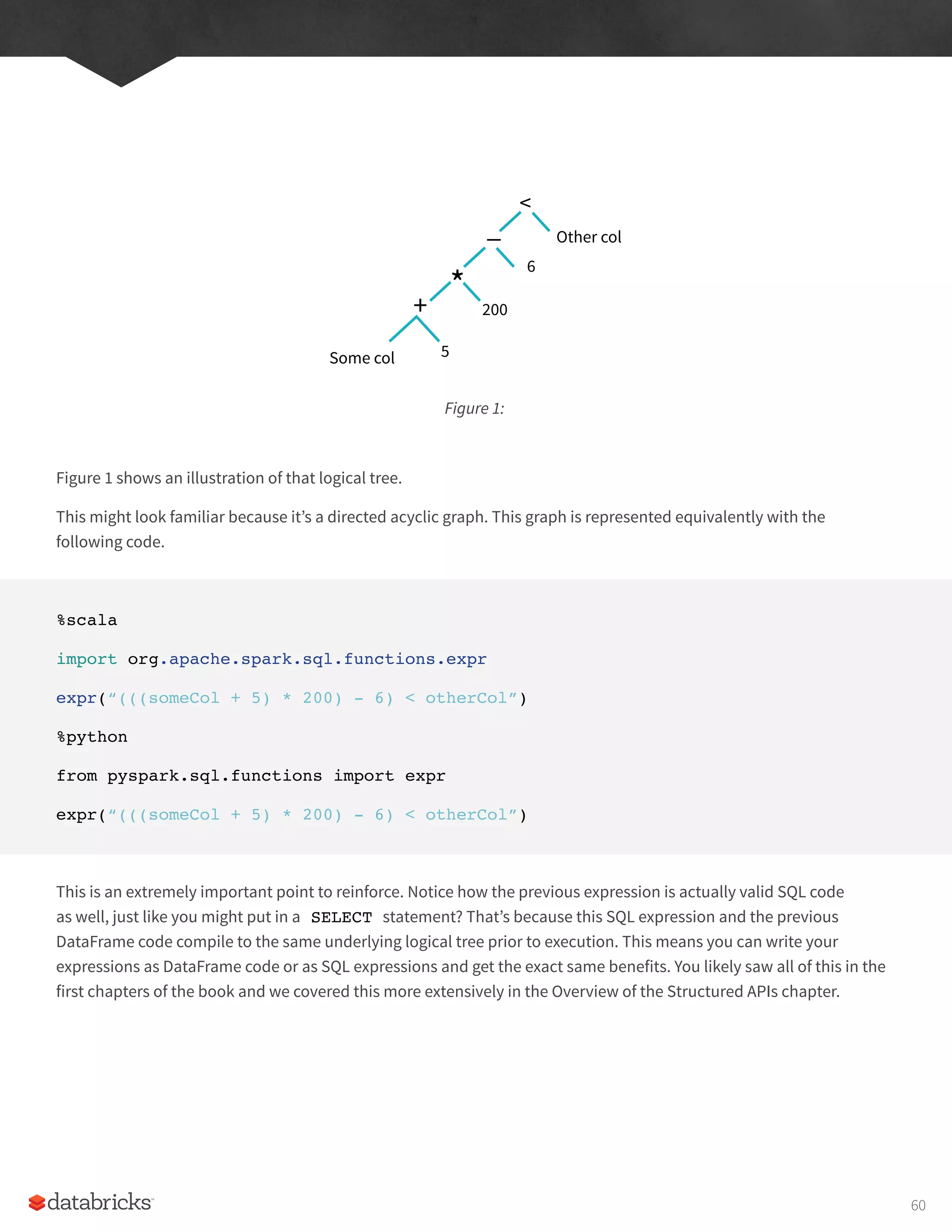
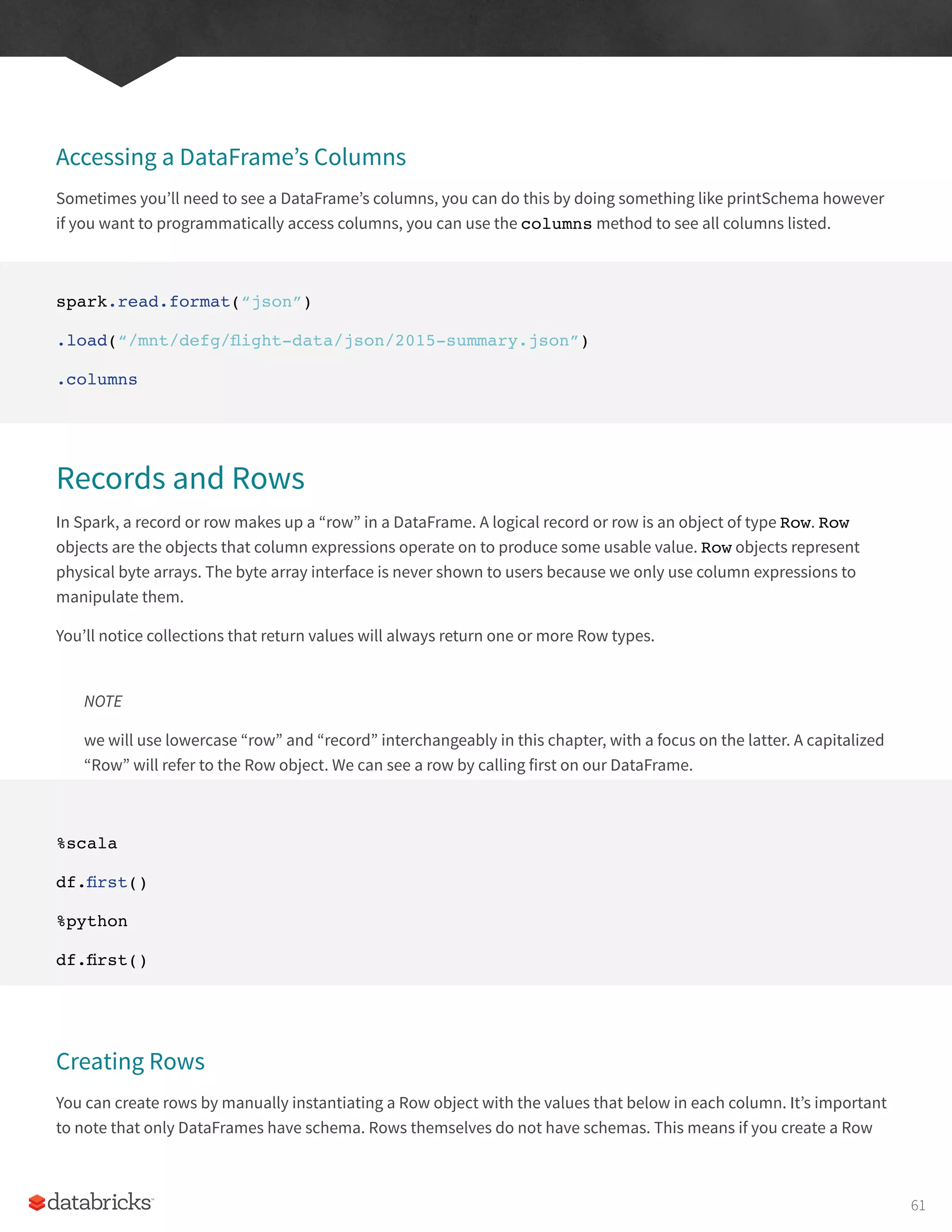
![manually, you must specify the values in the same order as the schema of the DataFrame they may be appended to.
We will see this when we discuss creating DataFrames.
%scala
import org.apache.spark.sql.Row
val myRow = Row(“Hello”, null, 1, false)
%python
from pyspark.sql import Row
myRow = Row(“Hello”, None, 1, False)
Accessing data in rows is equally as easy. We just specify the position. However because Spark maintains its own type
information, we will have to manually coerce this to the correct type in our respective language.
For example in Scala, we have to either use the helper methods or explicitly coerce the values.
%scala
myRow(0) // type Any
myRow(0).asInstanceOf[String] // String
myRow.getString(0) // String
myRow.getInt(2) // String
There exist one of these helper functions for each corresponding Spark and Scala type. In Python, we do not have to
worry about this, Spark will automatically return the correct type by location in the Row Object.
%python
myRow[0]
myRow[2]
62](https://image.slidesharecdn.com/apache-spark-the-definitive-guide-excerpts-r1-211010030627/75/Apache-spark-the-definitive-guide-excerpts-r1-62-2048.jpg)
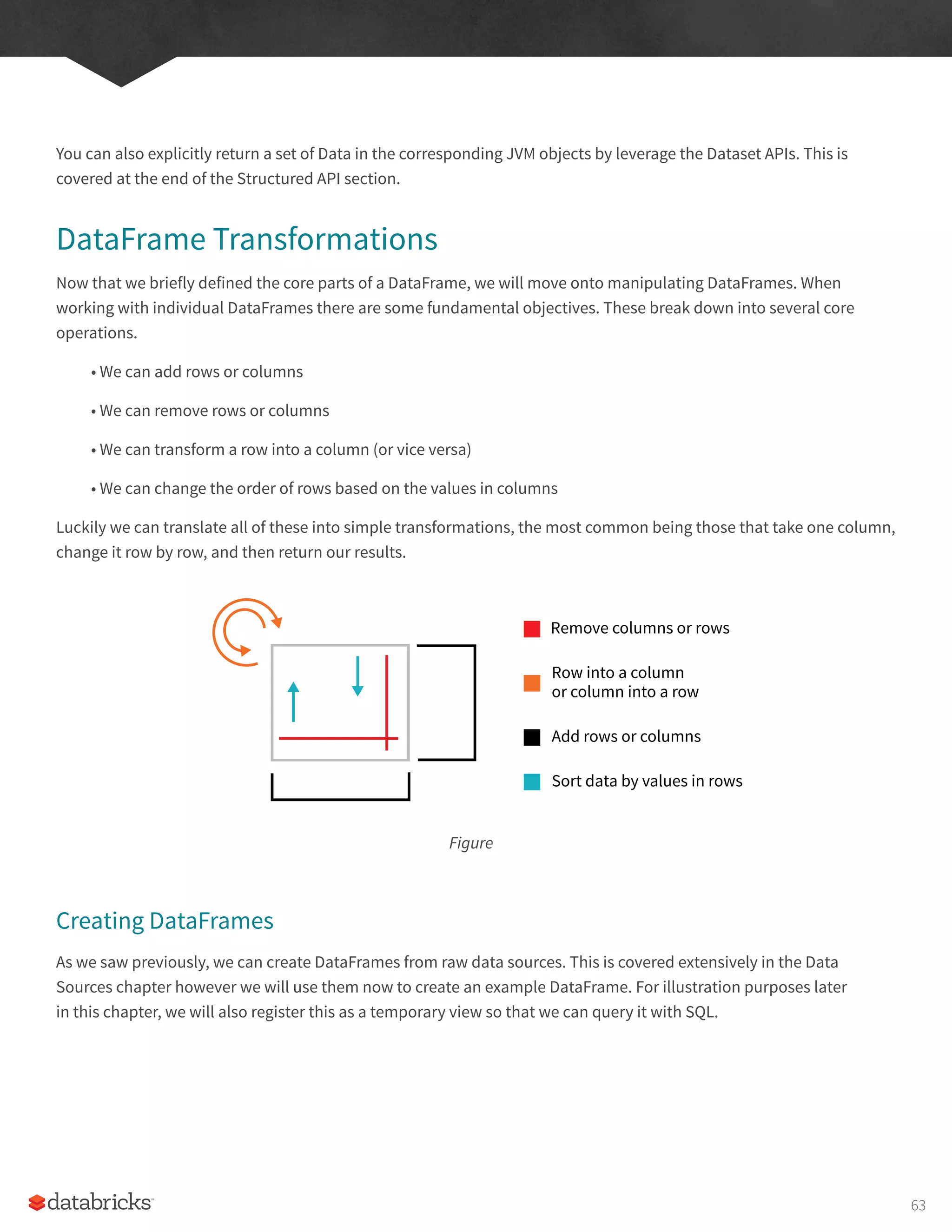
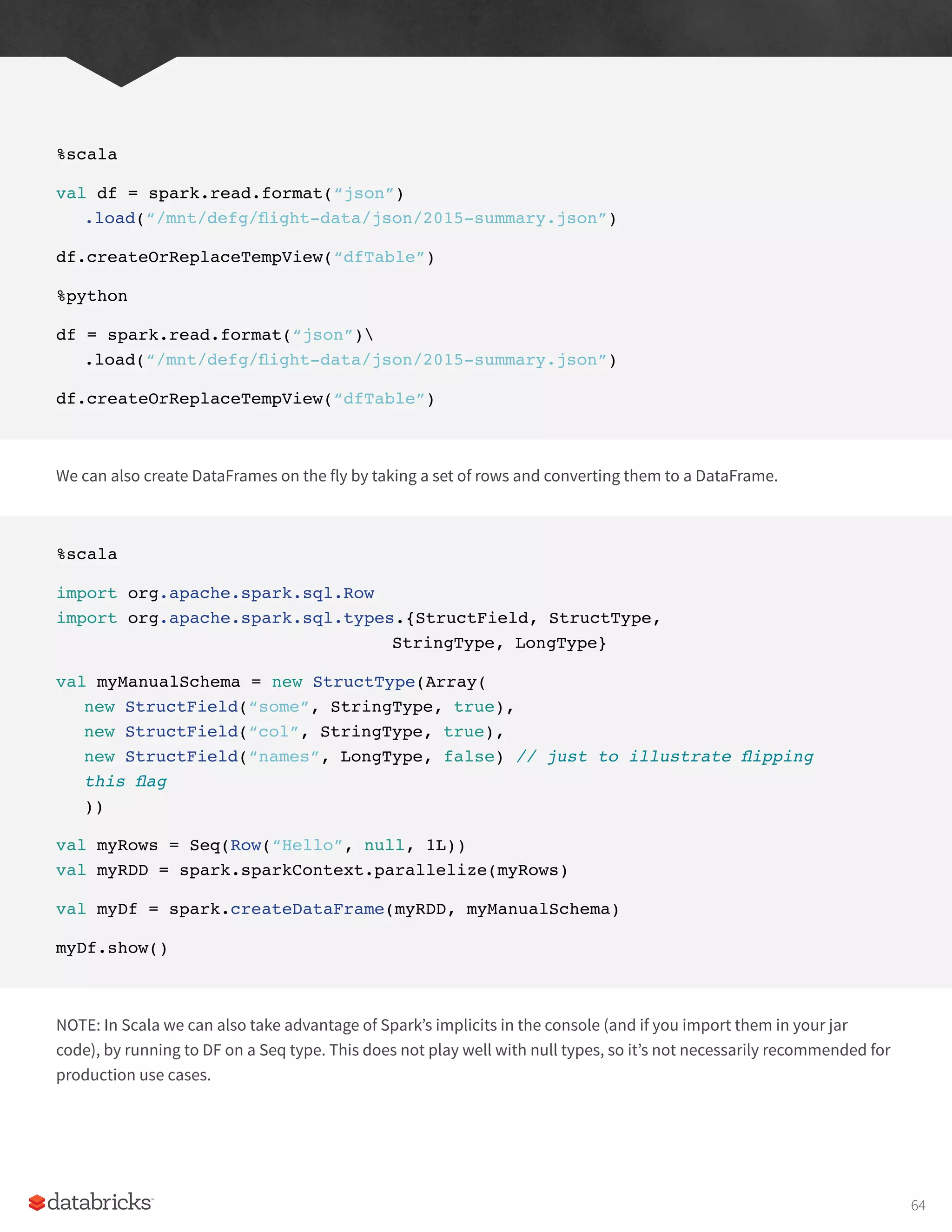
![%scala
val myDF = Seq((“Hello”, 2, 1L)).toDF()
%python
from pyspark.sql import Row
from pyspark.sql.types import StructField, StructType,
StringType, LongType
myManualSchema = StructType([
StructField(“some”, StringType(), True),
StructField(“col”, StringType(), True),
StructField(“names”, LongType(), False)
])
myRow = Row(“Hello”, None, 1)
myDf = spark.createDataFrame([myRow], myManualSchema)
myDf.show()
Now that we know how to create DataFrames, let’s go over their most useful methods that you’re going to be using
are: the select method when you’re working with columns or expressions and the selectExpr method when
you’re working with expressions in strings. Naturally some transformations are not specified as a methods on
columns, therefore there exists a group of functions found in the org.apache.spark.sql.functions package.
With these three tools, you should be able to solve the vast majority of transformation challenges that you may
encourage in DataFrames.
Select & SelectExpr
Select and SelectExpr allow us to do the DataFrame equivalent of SQL queries on a table of data.
SELECT * FROM dataFrameTable
SELECT columnName FROM dataFrameTable
SELECT columnName * 10, otherColumn, someOtherCol as c FROM dataFrameTable
65](https://image.slidesharecdn.com/apache-spark-the-definitive-guide-excerpts-r1-211010030627/75/Apache-spark-the-definitive-guide-excerpts-r1-65-2048.jpg)
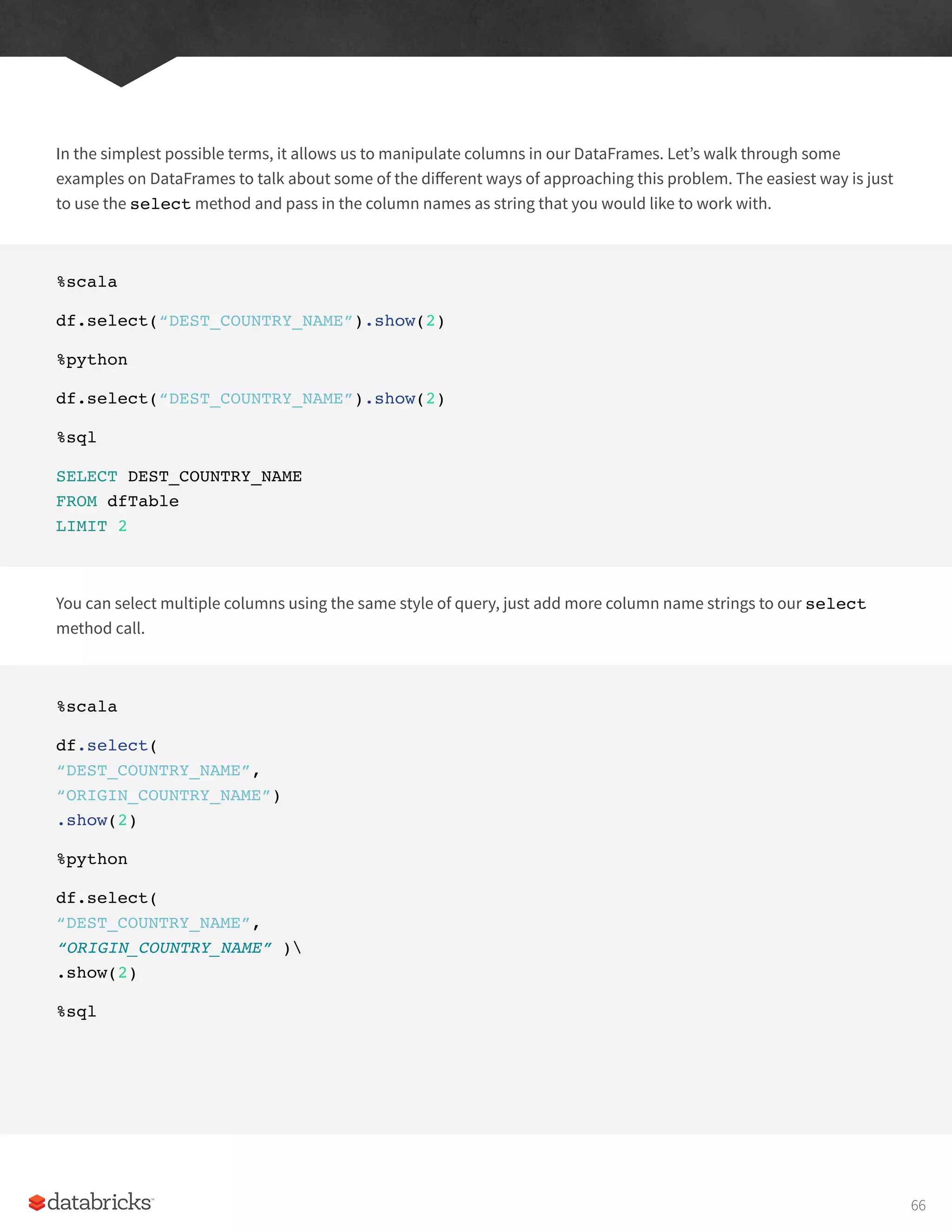



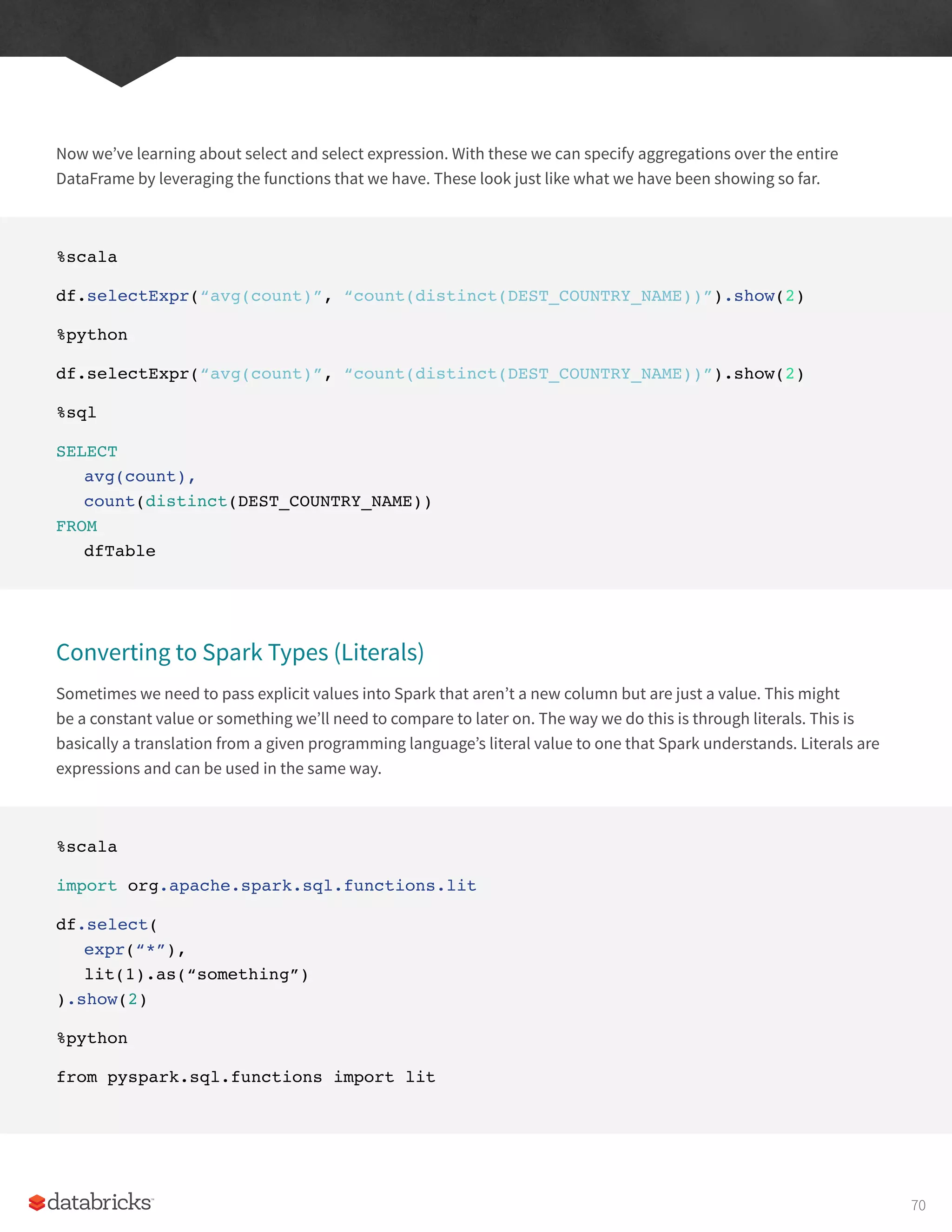
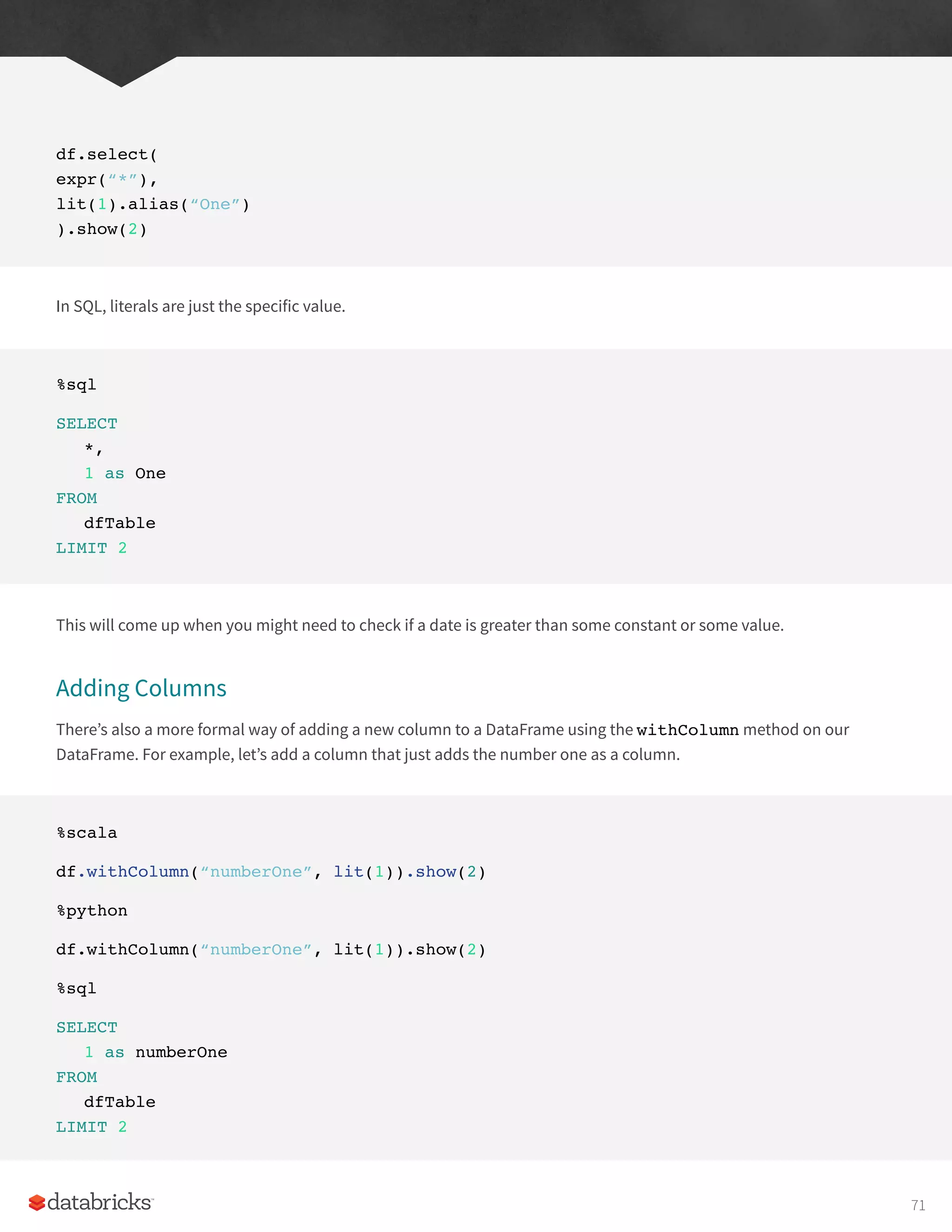
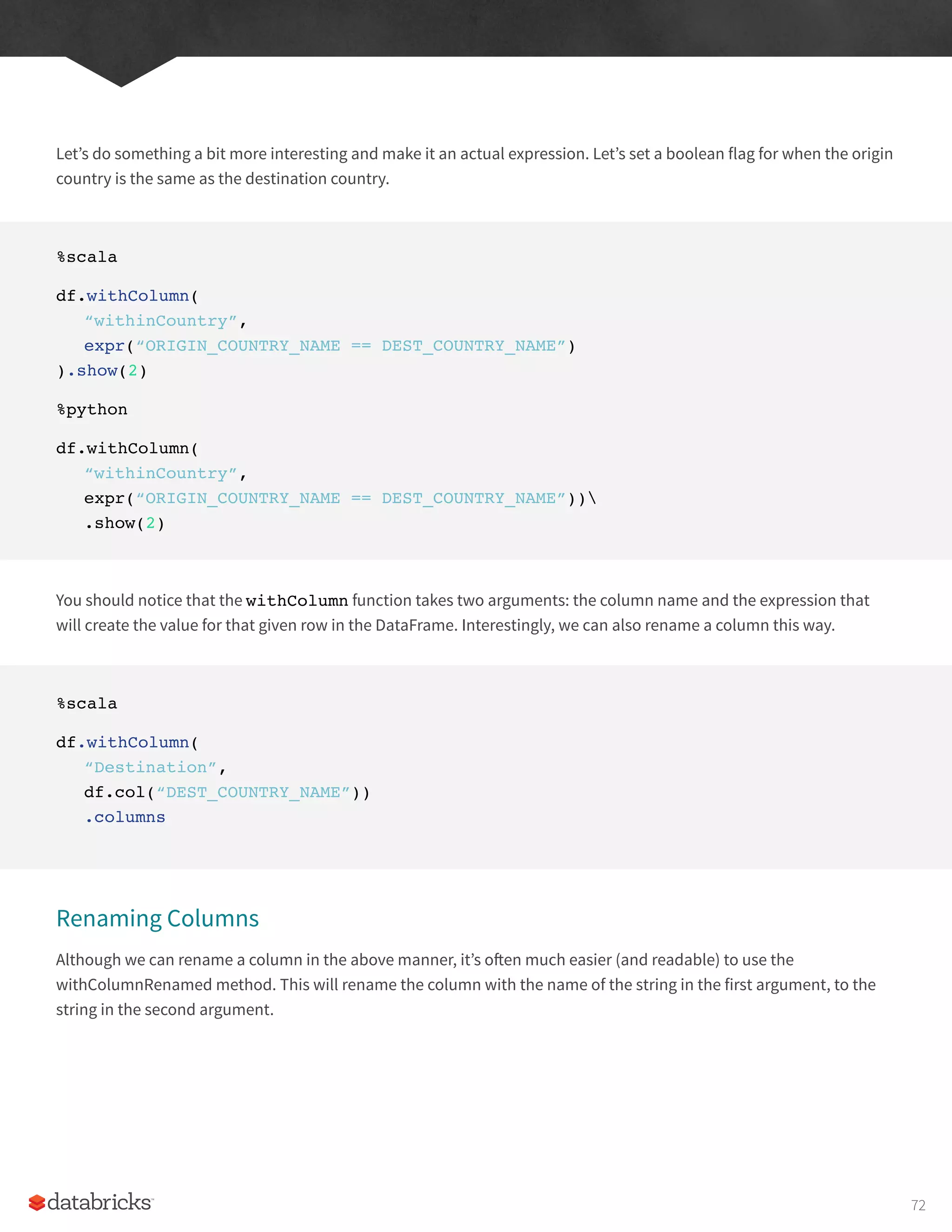
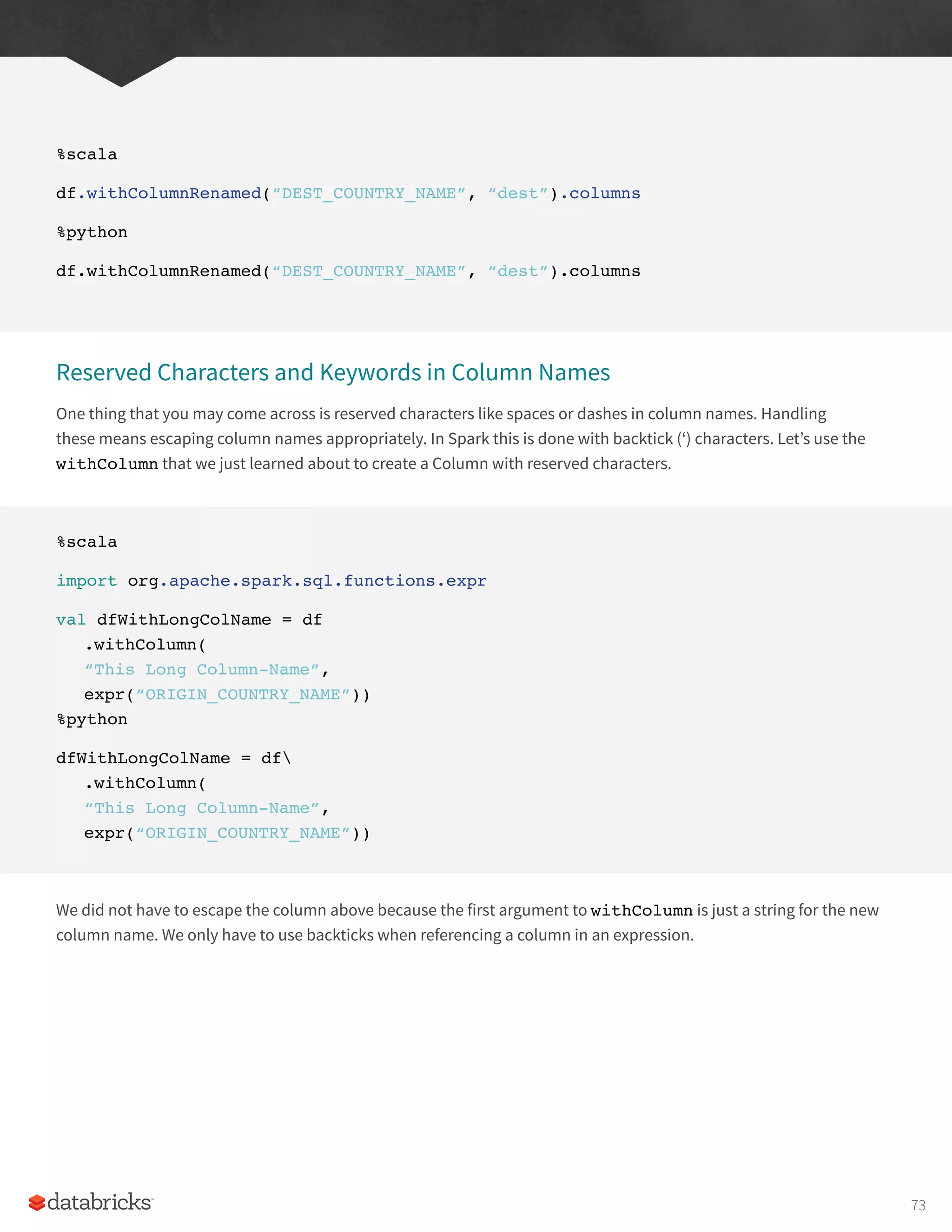
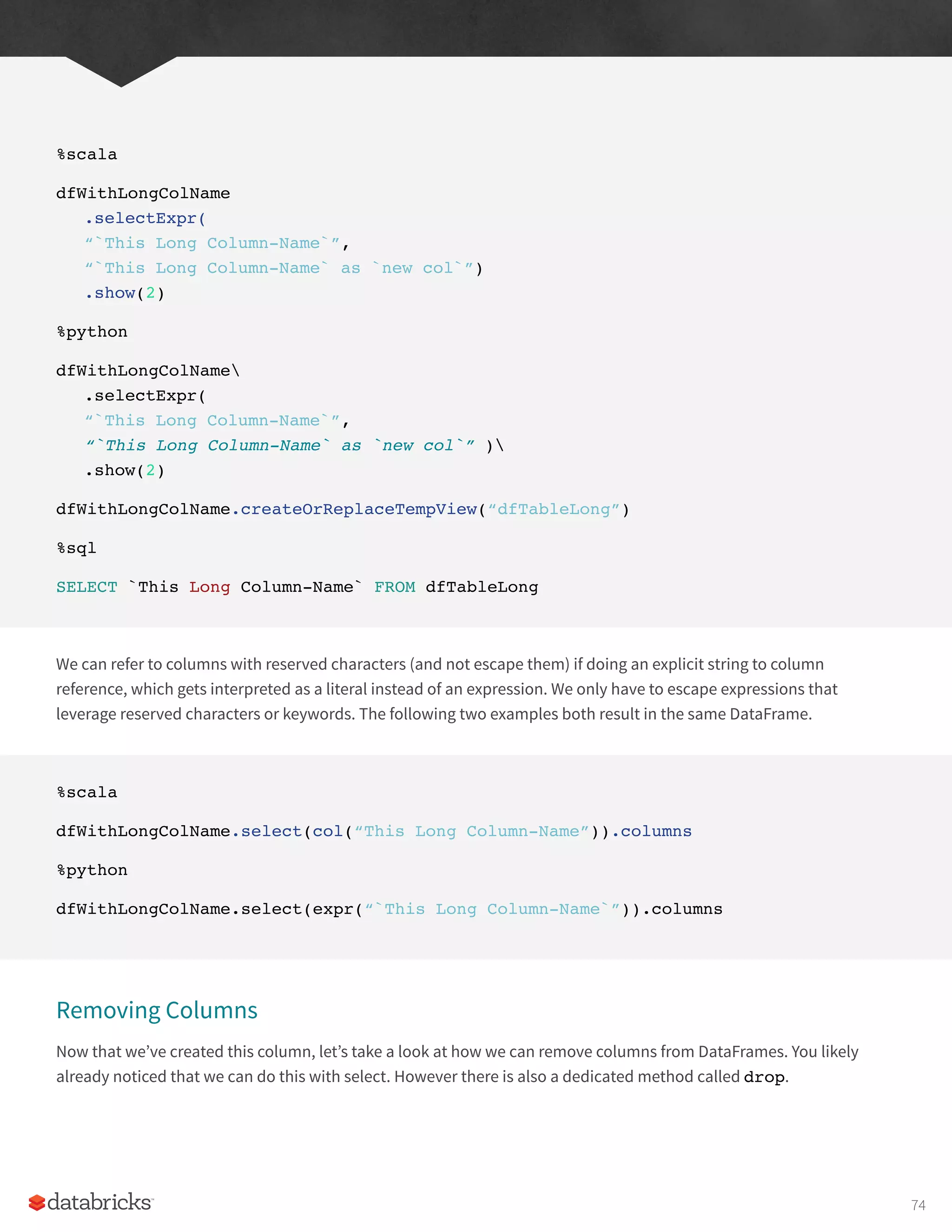
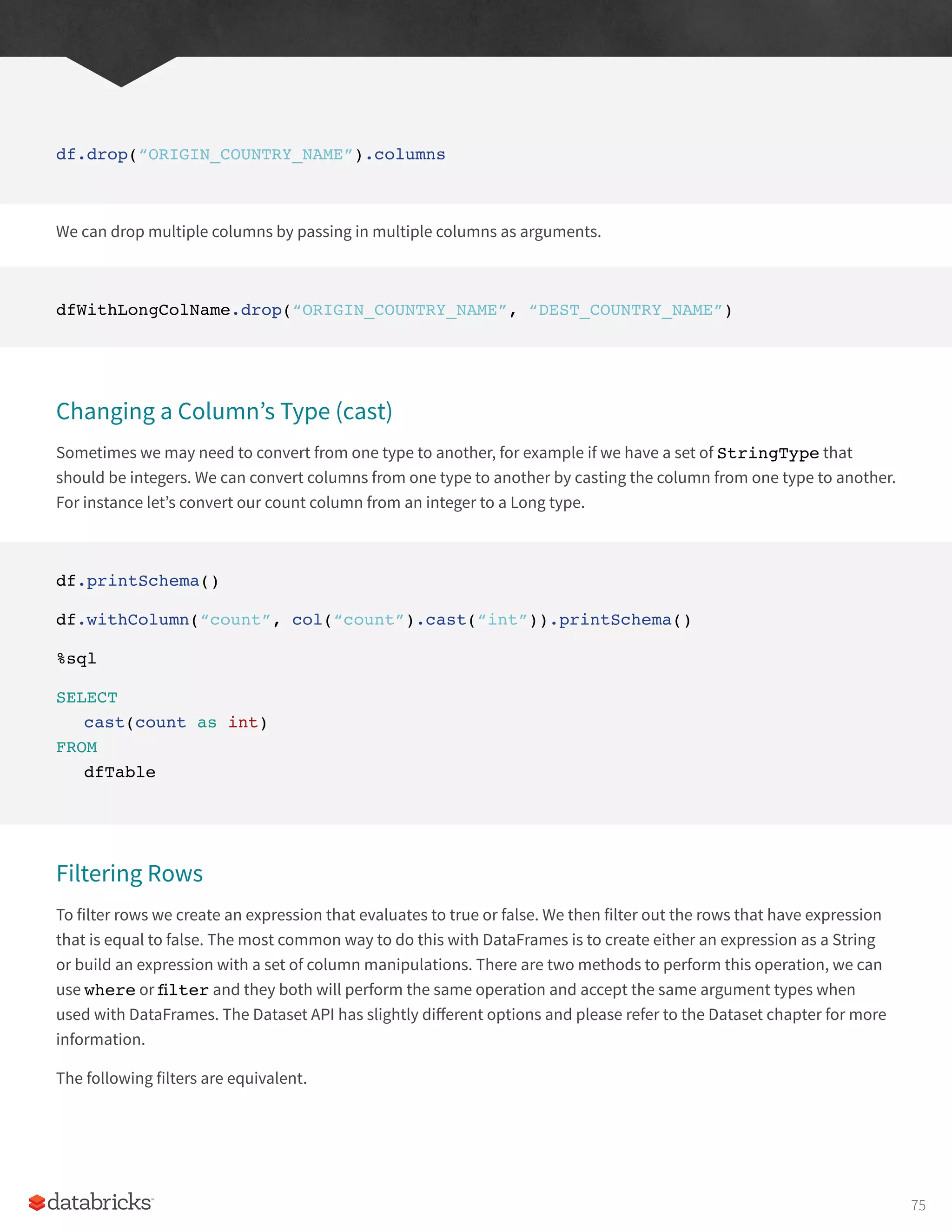
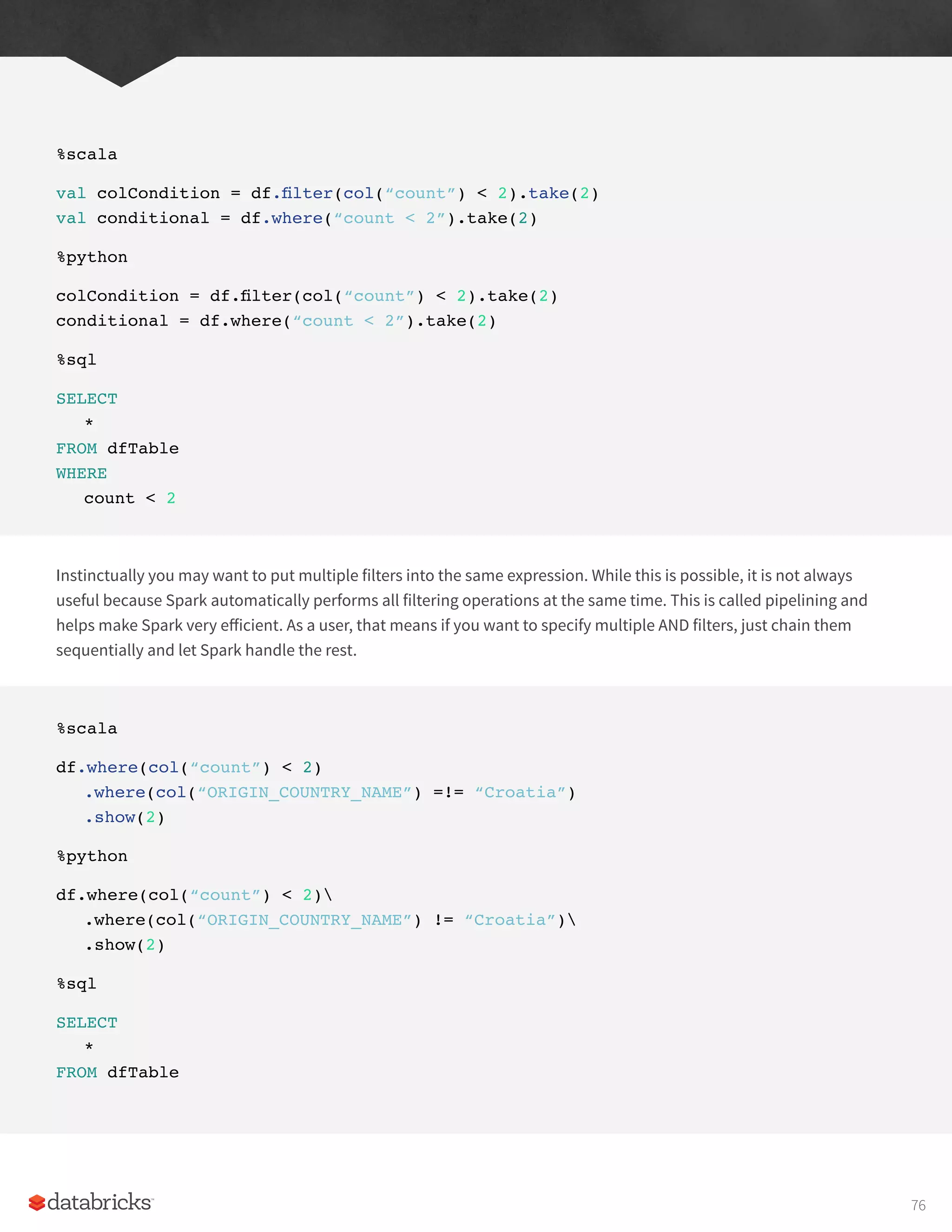
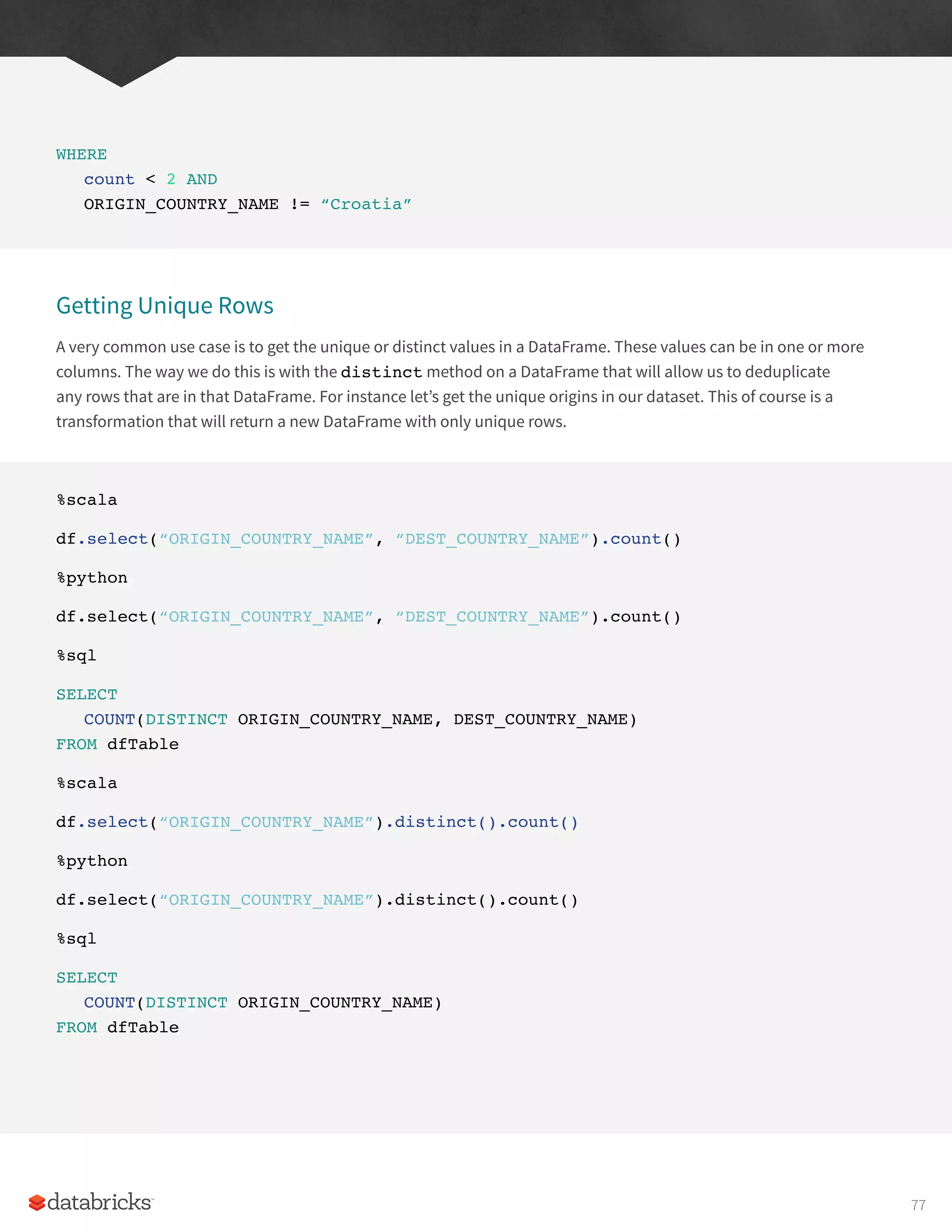
![Random Samples
Sometimes you may just want to sample some random records from your DataFrame. This is done with the sample
method on a DataFrame that allows you to specify a fraction of rows to extract from a DataFrame and whether you’d
like to sample with or without replacement.
val seed = 5
val withReplacement = false
val fraction = 0.5
df.sample(withReplacement, fraction, seed).count()
%python
seed = 5
withReplacement = False
fraction = 0.5
df.sample(withReplacement, fraction, seed).count()
Random Splits
Random splits can be helpful when you need to break up your DataFrame, randomly, in such a way that sampling
random cannot guarantee that all records are in one of the DataFrames that you’re sampling from. This is often
used with machine learning algorithms to create training, validation, and test sets. In this example we’ll split our
DataFrame into two different DataFrames by setting the weights by which we will split the DataFrame (these are the
arguments to the function). Since this method involves some randomness, we will also specify a seed. It’s important
to note that if you don’t specify a proportion for each DataFrame that adds up to one, they will be normalized so that
they do.
%scala
val dataFrames = df.randomSplit(Array(0.25, 0.75), seed)
dataFrames(0).count() > dataFrames(1).count()
%python
dataFrames = df.randomSplit([0.25, 0.75], seed)
dataFrames[0].count() > dataFrames[1].count()
78](https://image.slidesharecdn.com/apache-spark-the-definitive-guide-excerpts-r1-211010030627/75/Apache-spark-the-definitive-guide-excerpts-r1-78-2048.jpg)
![Concatenating and Appending Rows to a DataFrame
As we learned in the previous section, DataFrames are immutable. This means users cannot append to DataFrames
because that would be changing it. In order to append to a DataFrame, you must union the original DataFrame along
with the new DataFrame. This just concatenates the two DataFrames together. To union two DataFrames, you have to
be sure that they have the same schema and number of columns, else the union will fail.
%scala
import org.apache.spark.sql.Row
val schema = df.schema
val newRows = Seq(
Row(“New Country”, “Other Country”, 5L),
Row(“New Country 2”, “Other Country 3”, 1L)
)
val parallelizedRows = spark.sparkContext.parallelize(newRows)
val newDF = spark.createDataFrame(parallelizedRows, schema)
df.union(newDF)
.where(“count = 1”)
.where($”ORIGIN_COUNTRY_NAME” =!= “United States”)
.show() // get all of them and we’ll see our new rows at the end
%python
from pyspark.sql import Row
schema = df.schema
newRows = [
Row(“New Country”, “Other Country”, 5L),
Row(“New Country 2”, “Other Country 3”, 1L)
]
parallelizedRows = spark.sparkContext.parallelize(newRows)
newDF = spark.createDataFrame(parallelizedRows, schema)
%python
79](https://image.slidesharecdn.com/apache-spark-the-definitive-guide-excerpts-r1-211010030627/75/Apache-spark-the-definitive-guide-excerpts-r1-79-2048.jpg)
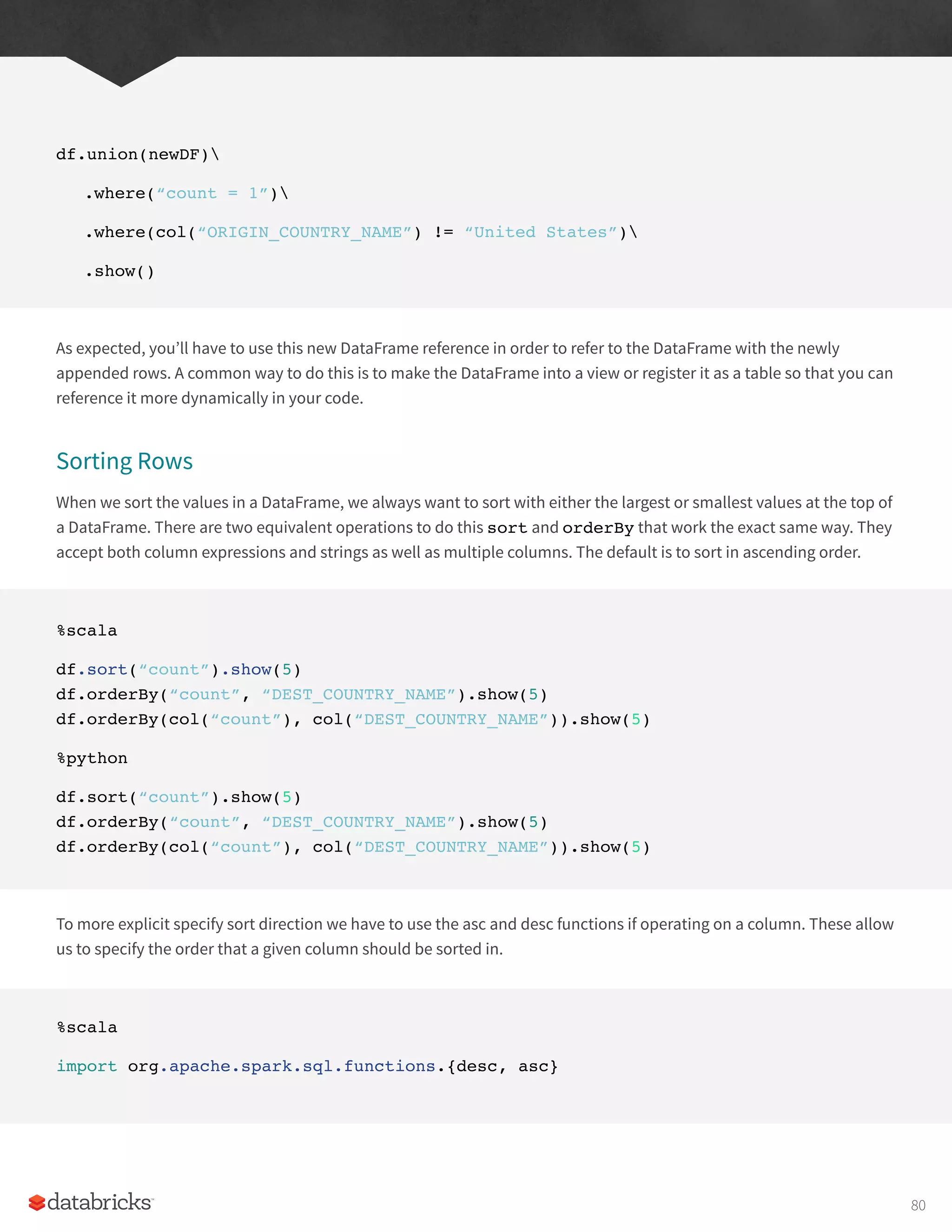

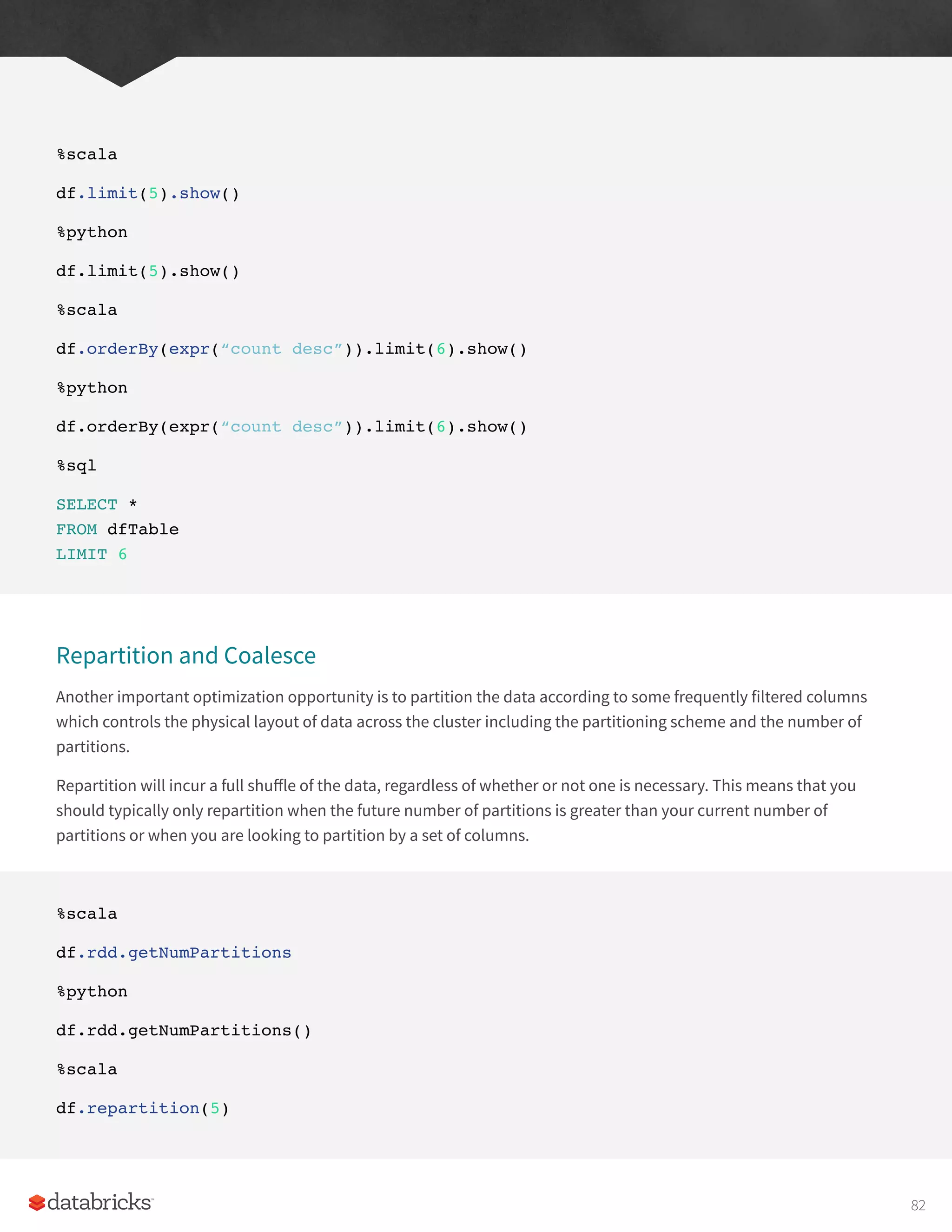
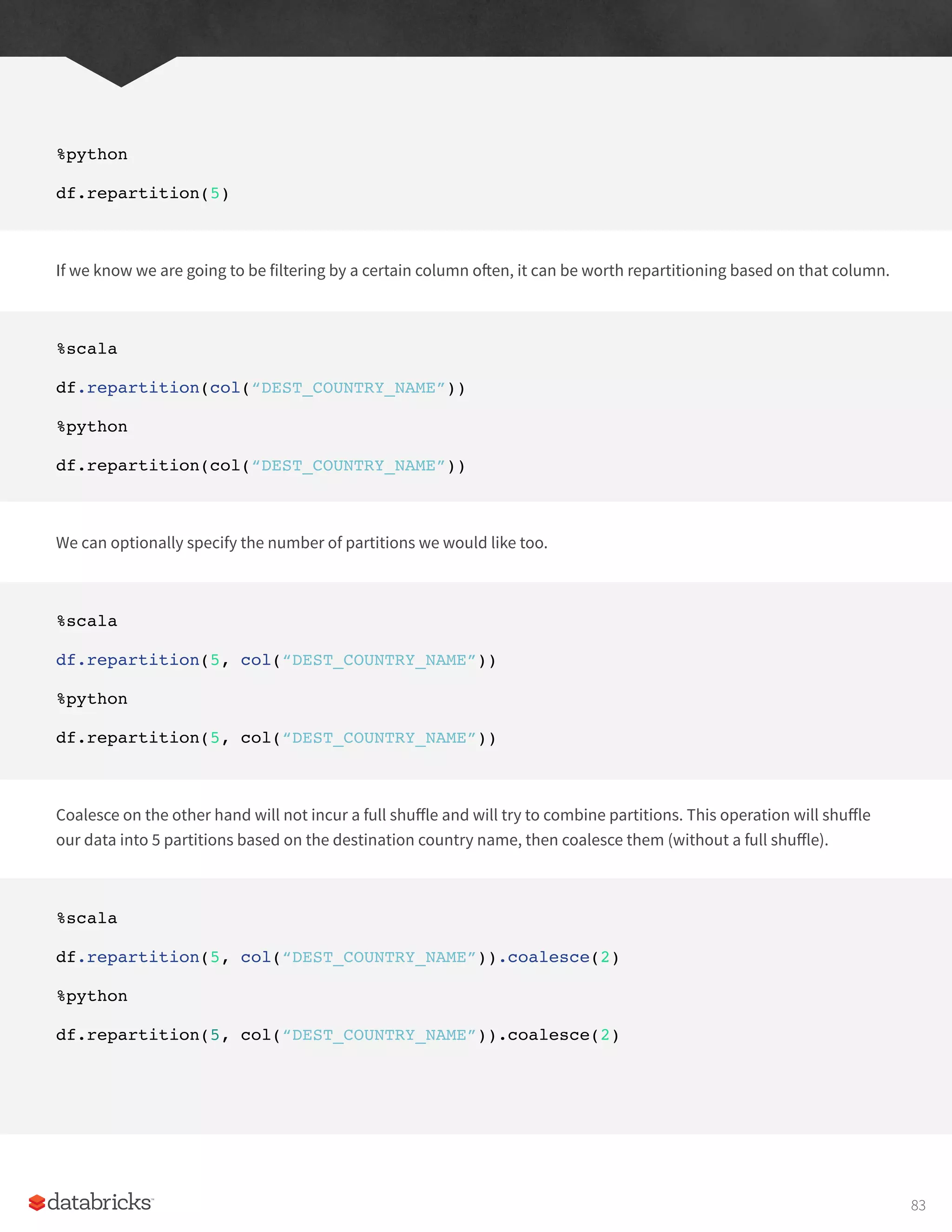
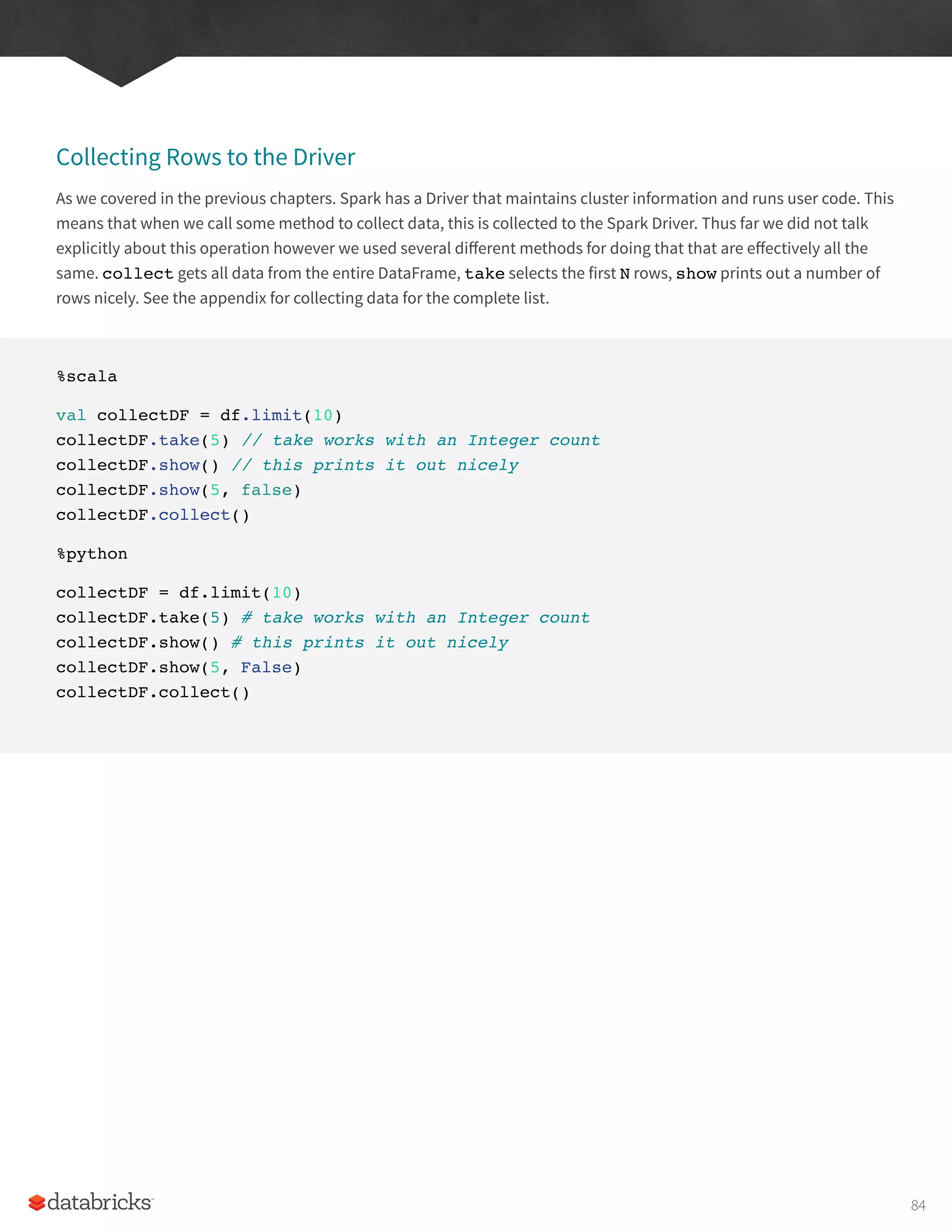
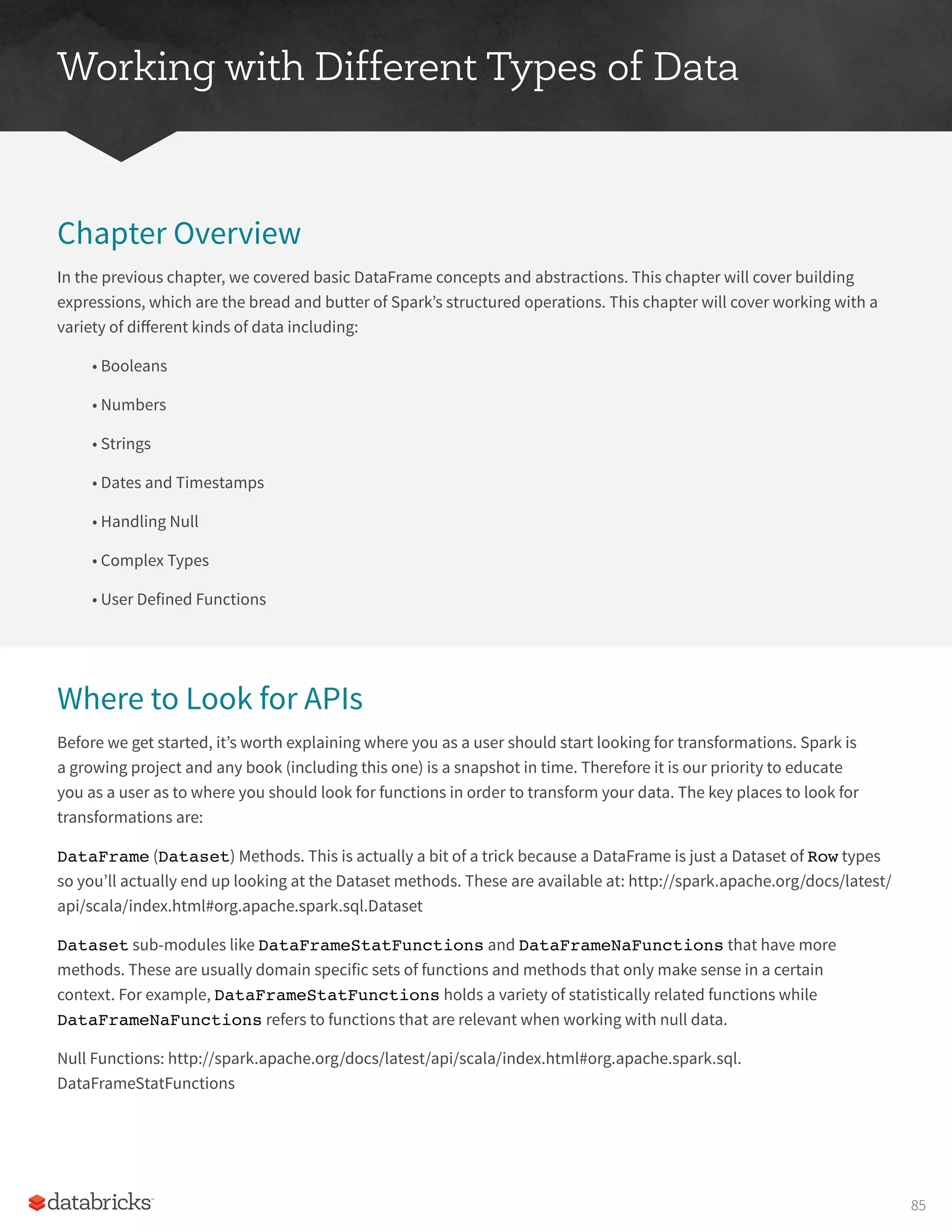
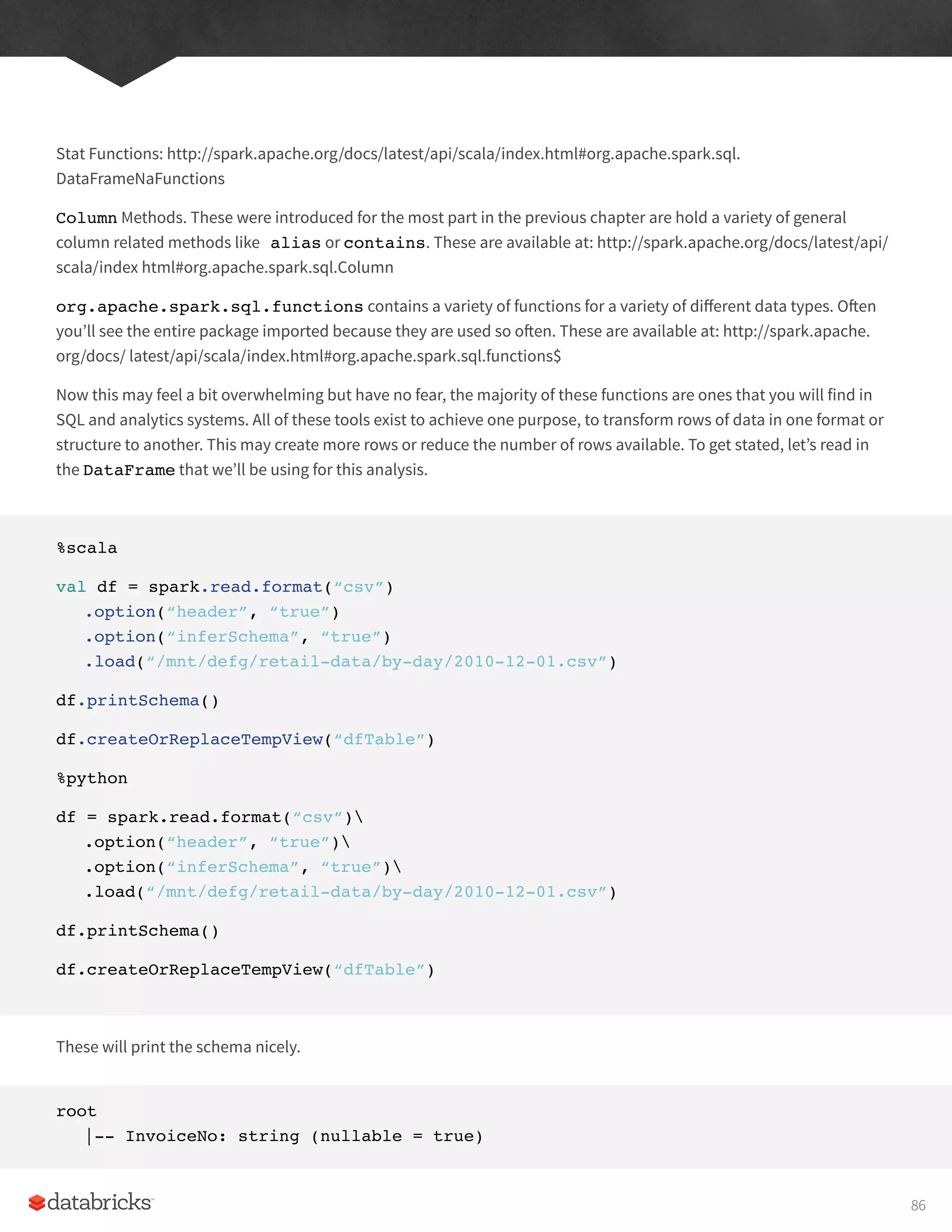

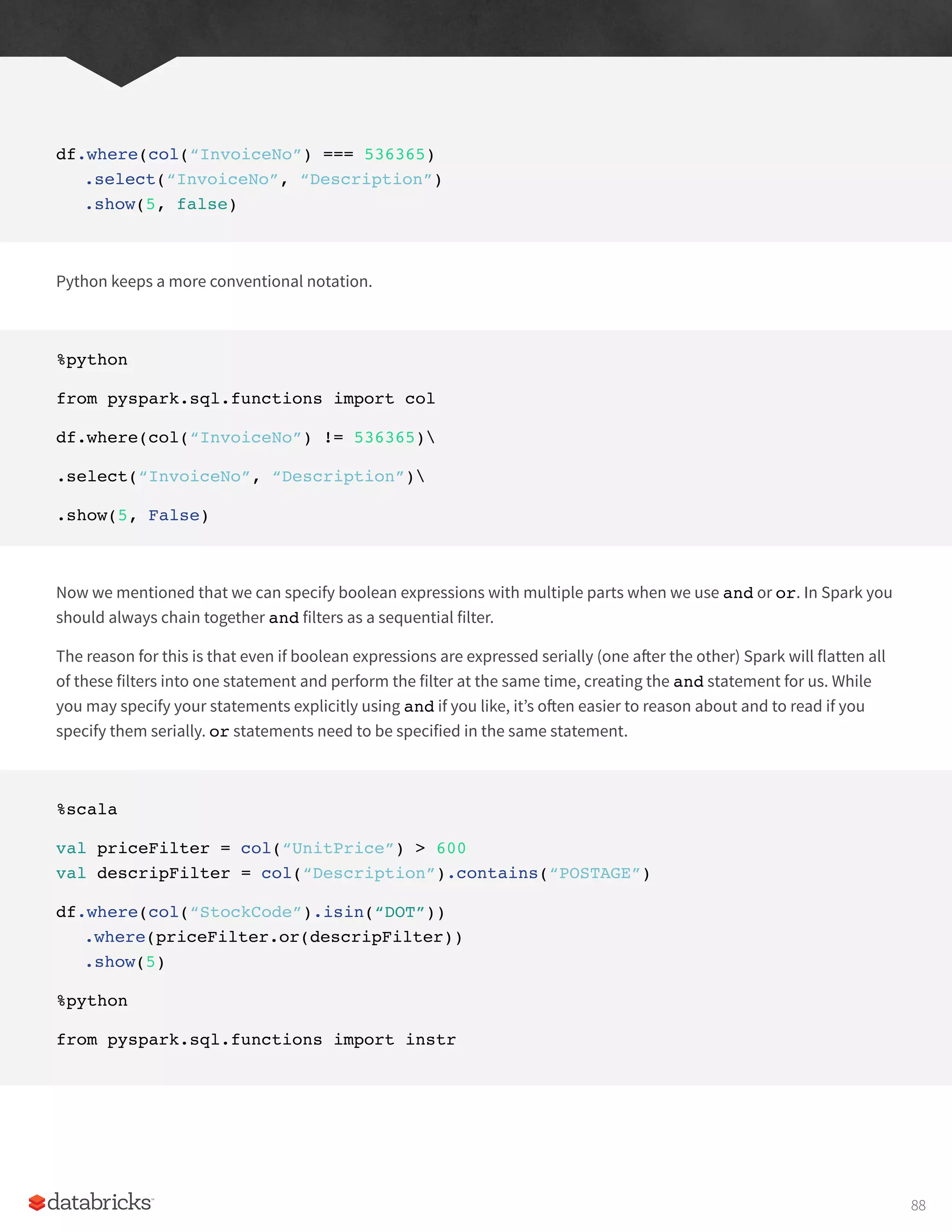
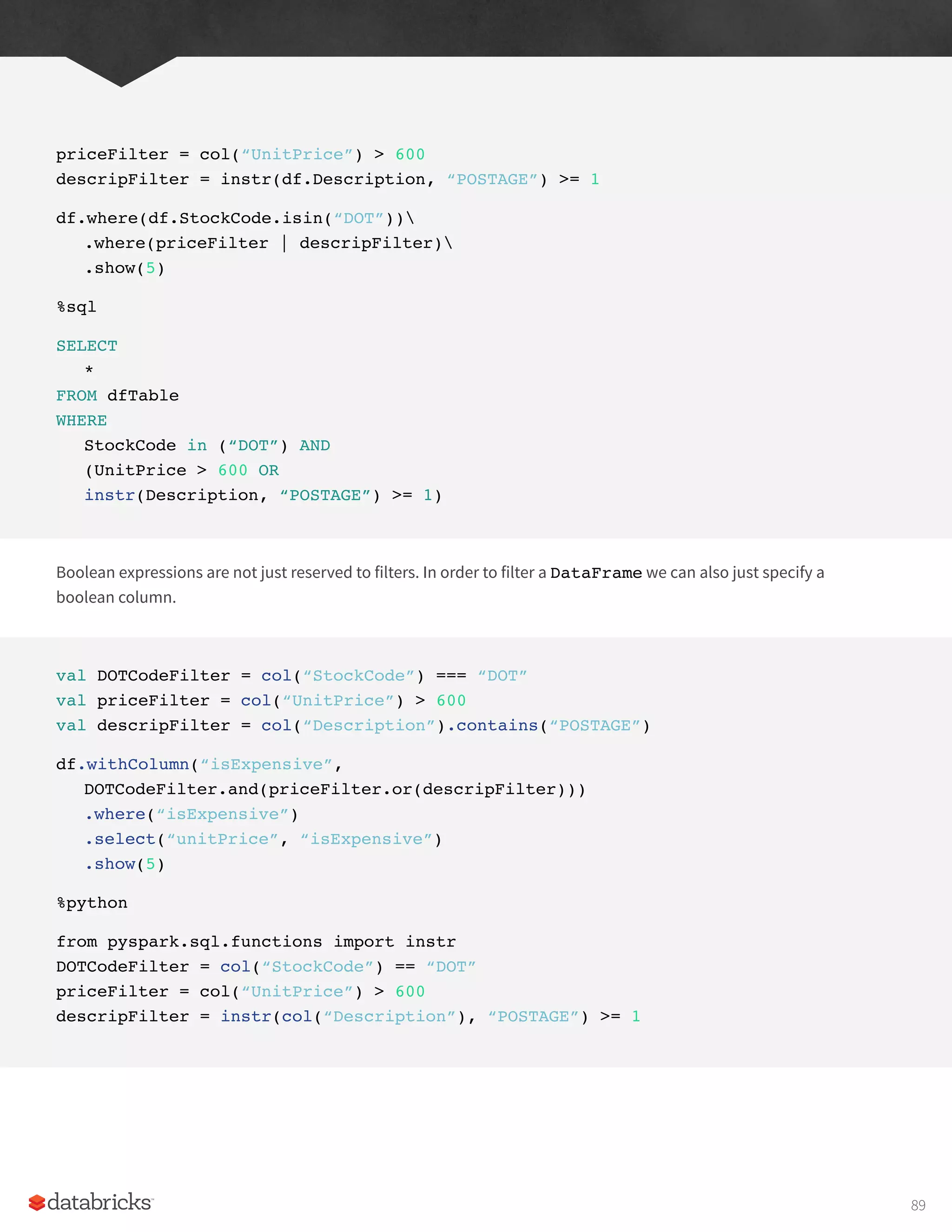
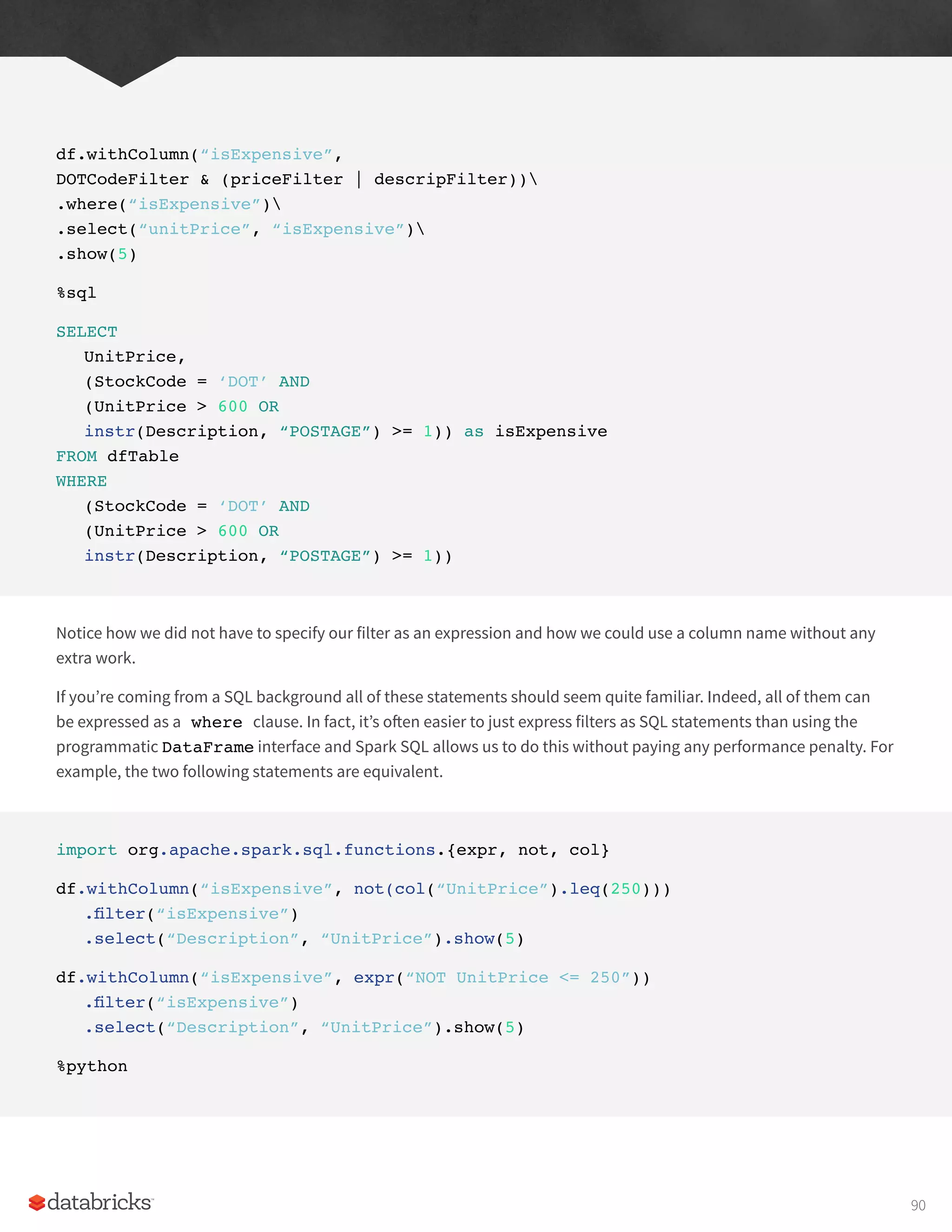

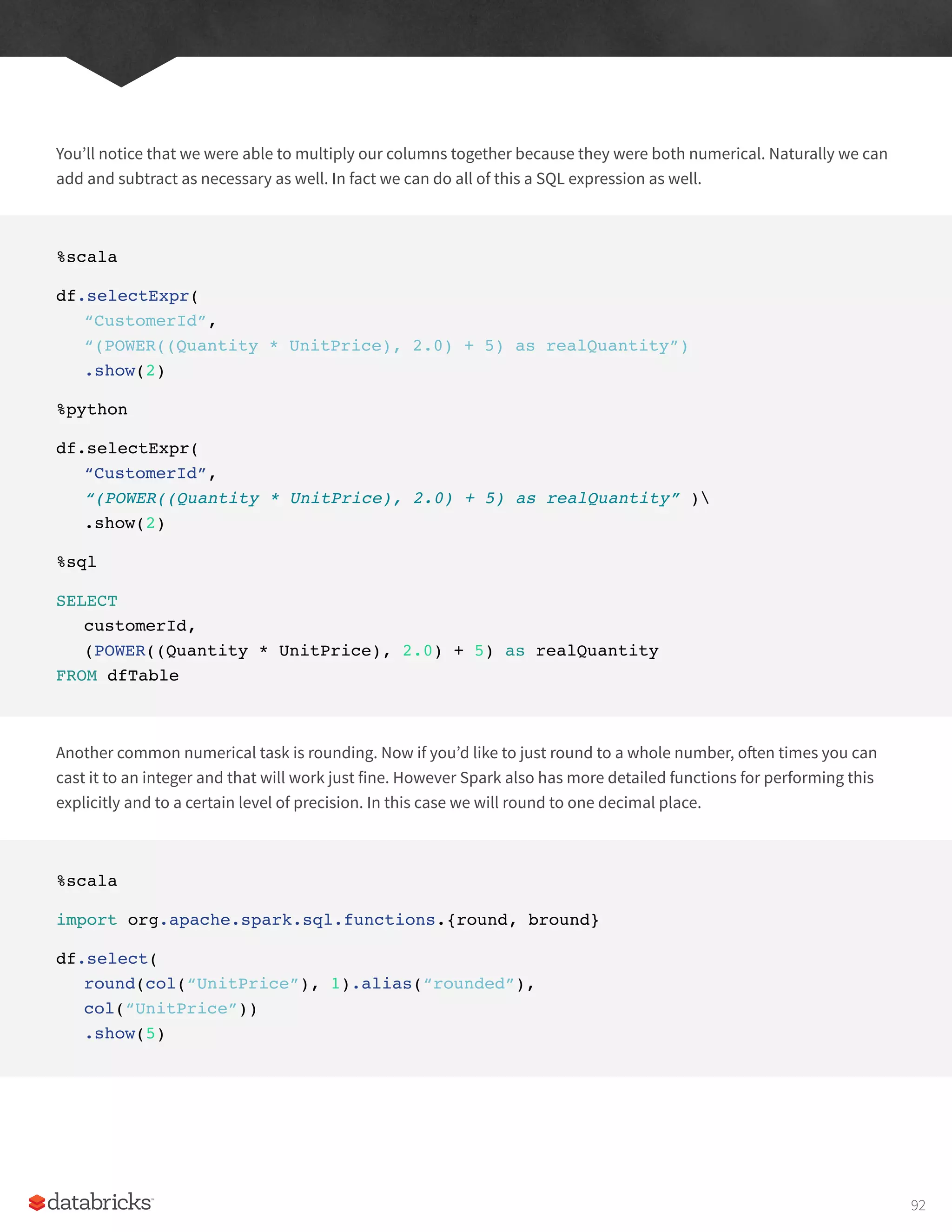
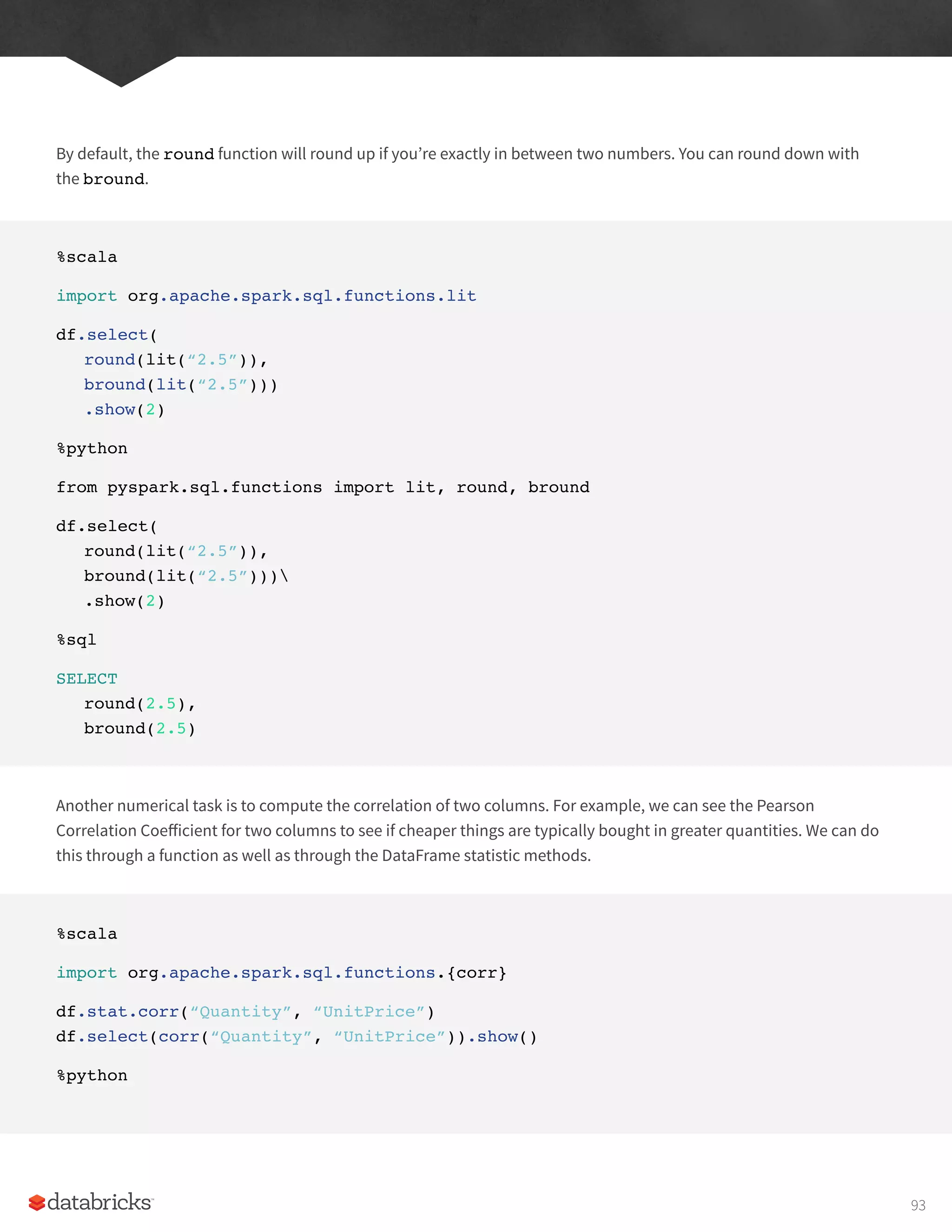
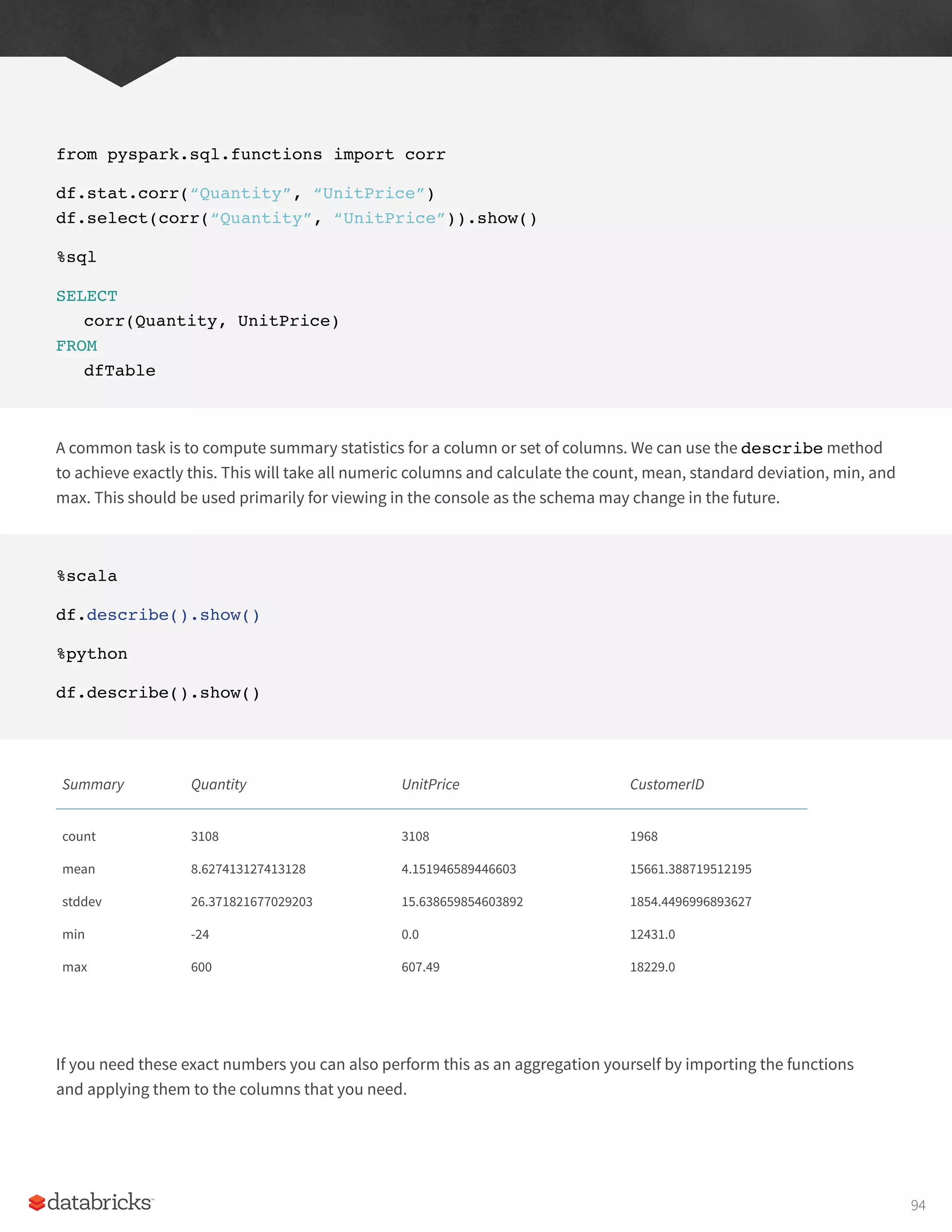
![%scala
import org.apache.spark.sql.functions.{count, mean, stddev_pop, min, max}
%python
from pyspark.sql.functions import count, mean, stddev_pop, min, max
There are a number of statistical functions available in the StatFunctions Package. These are DataFrame methods
that allow you to calculate a vareity of different things. For instance, we can calculate either exact or approximate
quantiles of our data using the approxQuantile method.
%scala
val colName = “UnitPrice”
val quantileProbs = Array(0.5)
val relError = 0.05
df.stat.approxQuantile(“UnitPrice”, quantileProbs, relError)
%python
colName = “UnitPrice”
quantileProbs = [0.5]
relError = 0.05
df.stat.approxQuantile(“UnitPrice”, quantileProbs, relError)
We can also use this to see a cross tabulation or frequent item pairs (Be careful, this output will be large).
%scala
df.stat.crosstab(“StockCode”, “Quantity”).show()
%python
df.stat.crosstab(“StockCode”, “Quantity”).show()
%scala
df.stat.freqItems(Seq(“StockCode”, “Quantity”)).show()
95](https://image.slidesharecdn.com/apache-spark-the-definitive-guide-excerpts-r1-211010030627/75/Apache-spark-the-definitive-guide-excerpts-r1-95-2048.jpg)
![%python
df.stat.freqItems([“StockCode”, “Quantity”]).show()
Spark is home to a variety of other features and functionality. For example, you can use Spark to construct a Bloom
Filter or Count Min Sketch using the stat sub-package. There are also a multitude of other functions available that
are self-explanatory and need not be explained individually.
Working with Strings
String manipulation shows up in nearly every data flow and its worth explaining what you can do with strings. You
may be manipulating log files performing regular expression extraction or substitution, or checking for simple string
existence, or simply making all strings upper or lower case.
We will start with the last task as it’s one of the simplest. The initcap function will capitalize every word in a given
string when that word is separated from another via whitespace.
%scala
import org.apache.spark.sql.functions.{initcap}
df.select(initcap(col(“Description”))).show(2, false)
%python
from pyspark.sql.functions import initcap
df.select(initcap(col(“Description”))).show()
%sql
SELECT
initcap(Description)
FROM
dfTable
As mentioned above, we can also quite simply lower case and upper case strings as well.
96](https://image.slidesharecdn.com/apache-spark-the-definitive-guide-excerpts-r1-211010030627/75/Apache-spark-the-definitive-guide-excerpts-r1-96-2048.jpg)
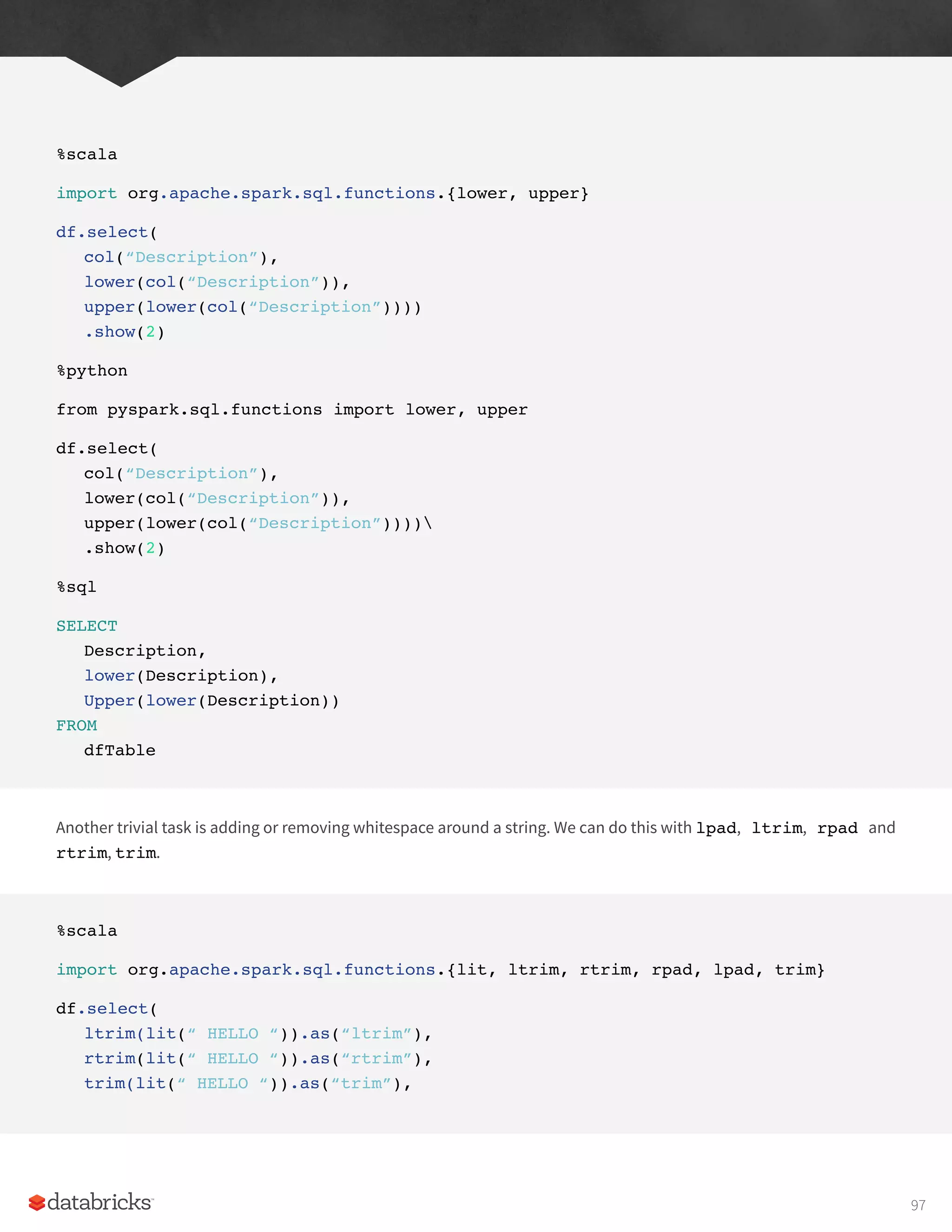

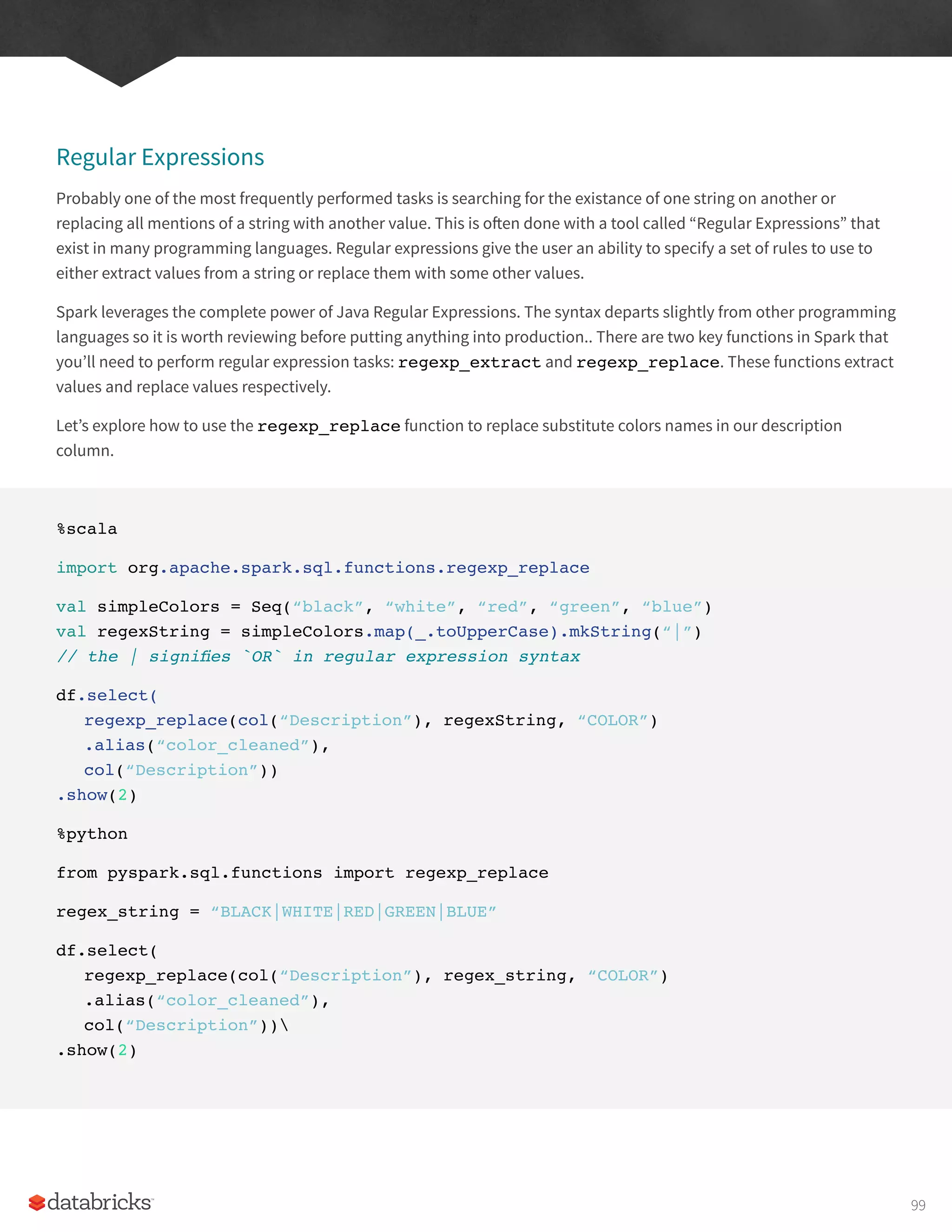
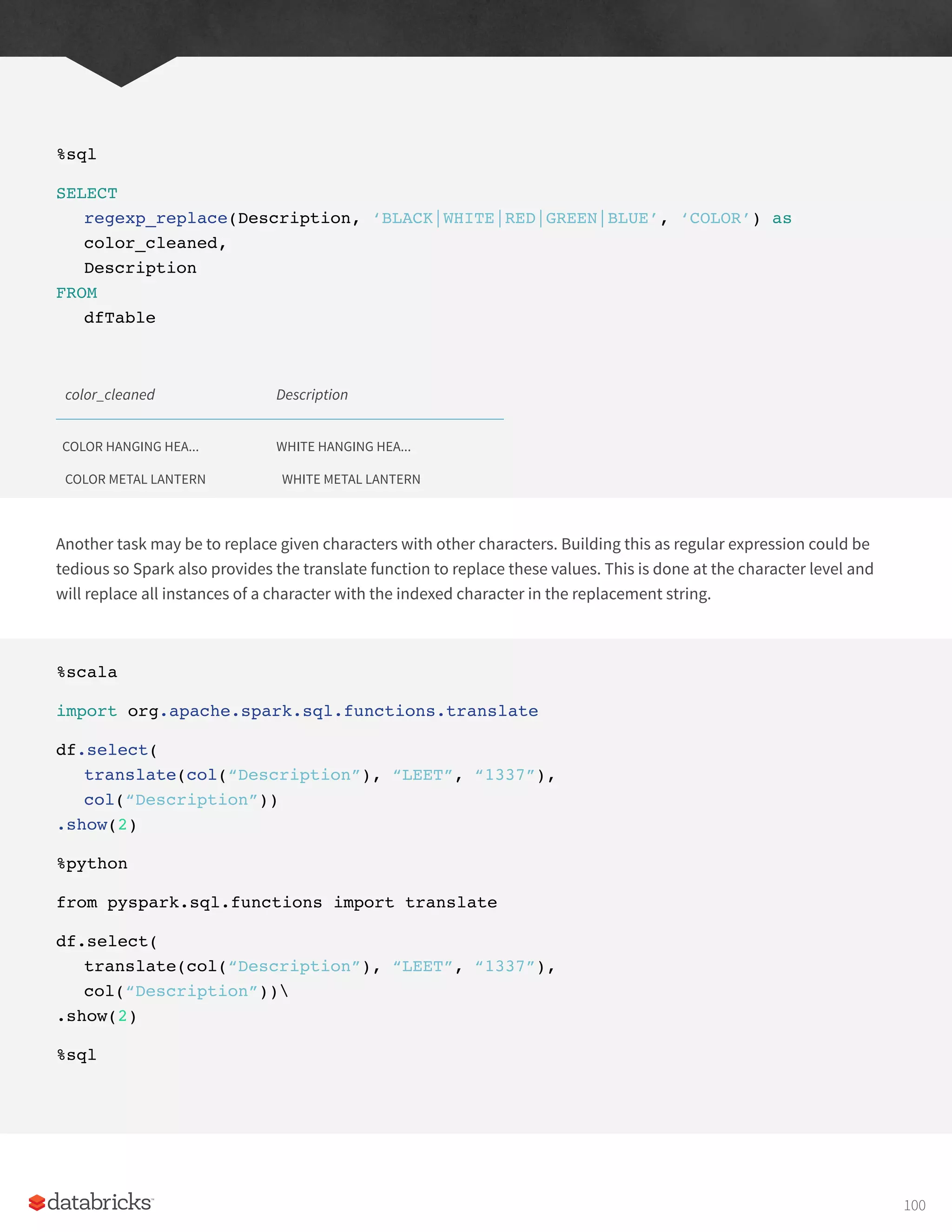
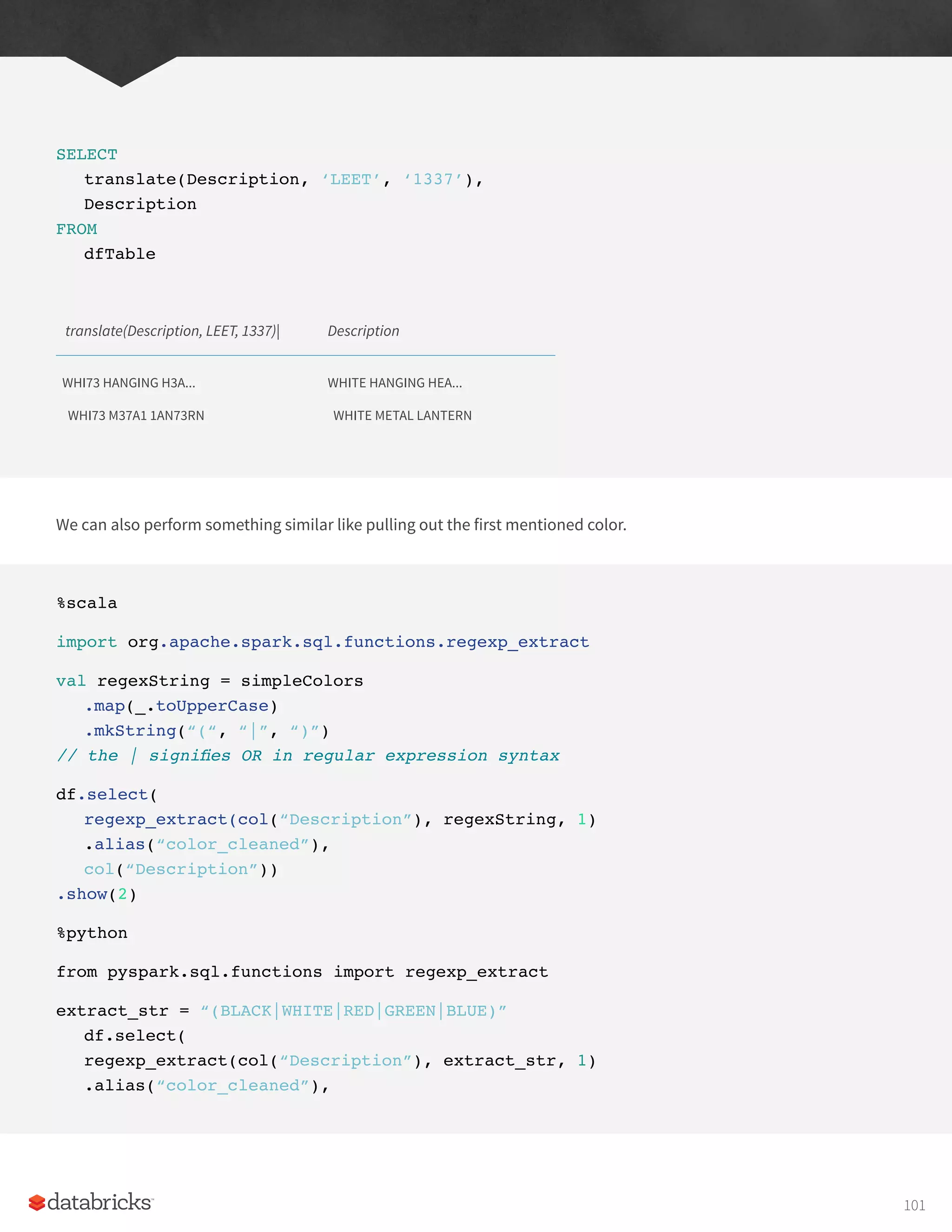
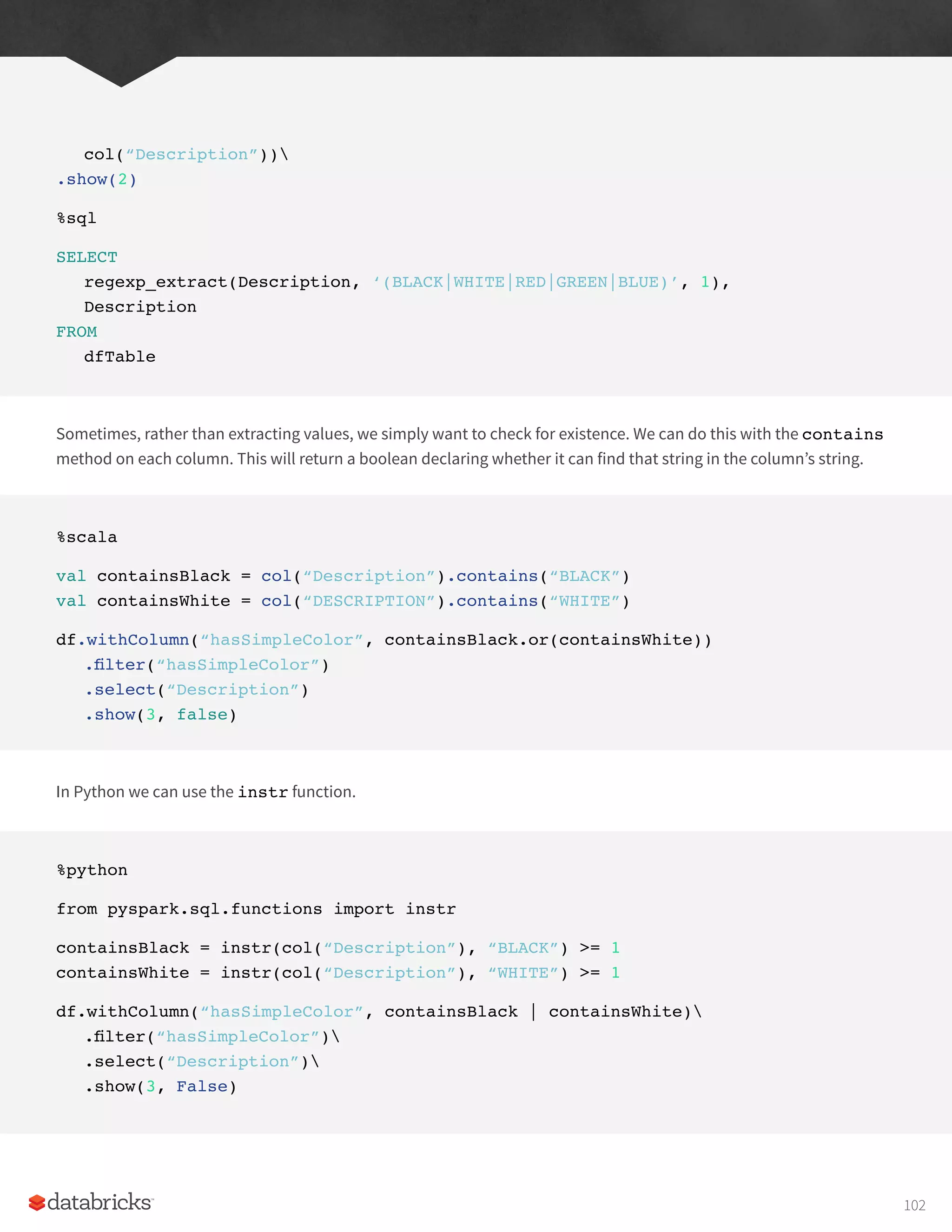
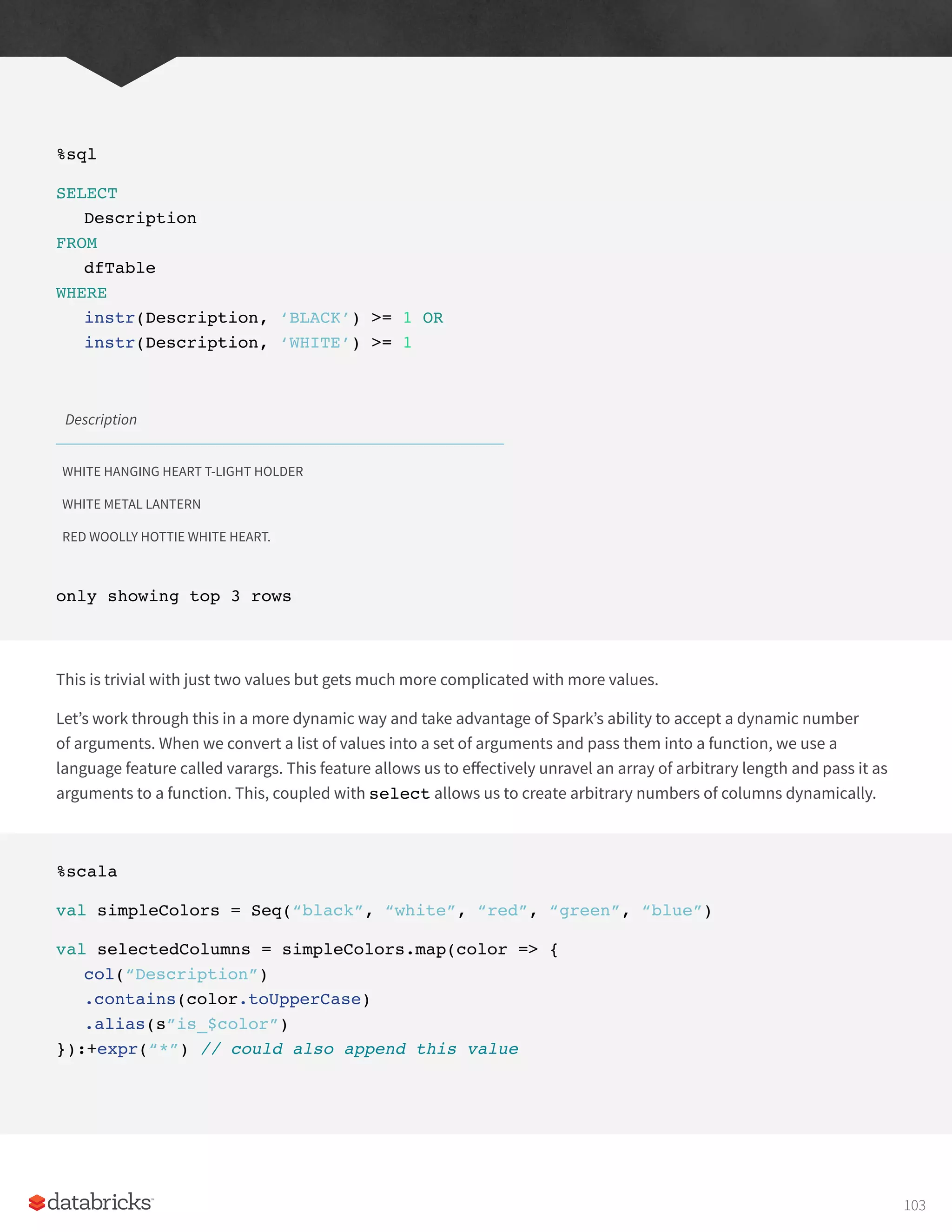
![df
.select(selectedColumns:_*)
.where(col(“is_white”).or(col(“is_red”)))
.select(“Description”)
.show(3, false)
Description
WHITE HANGING HEART T-LIGHT HOLDER
WHITE METAL LANTERN
RED WOOLLY HOTTIE WHITE HEART.
We can also do this quite easily in Python. In this case we’re going to use a different function locate that returns the
integer location (1 based location). We then convert that to a boolean before using it as a the same basic feature.
%python
from pyspark.sql.functions import expr, locate
simpleColors = [“black”, “white”, “red”, “green”, “blue”]
def color_locator(column, color_string):
“””This function creates a column declaring whether or
not a given pySpark column contains the UPPERCASED
color.
Returns a new column type that can be used
in a select statement.
“””
return locate(color_string.upper(), column)
.cast(“boolean”)
.alias(“is_” + c)
selectedColumns = [color_locator(df.Description, c) for c in simpleColors]
selectedColumns.append(expr(“*”)) # has to a be Column type
104](https://image.slidesharecdn.com/apache-spark-the-definitive-guide-excerpts-r1-211010030627/75/Apache-spark-the-definitive-guide-excerpts-r1-104-2048.jpg)
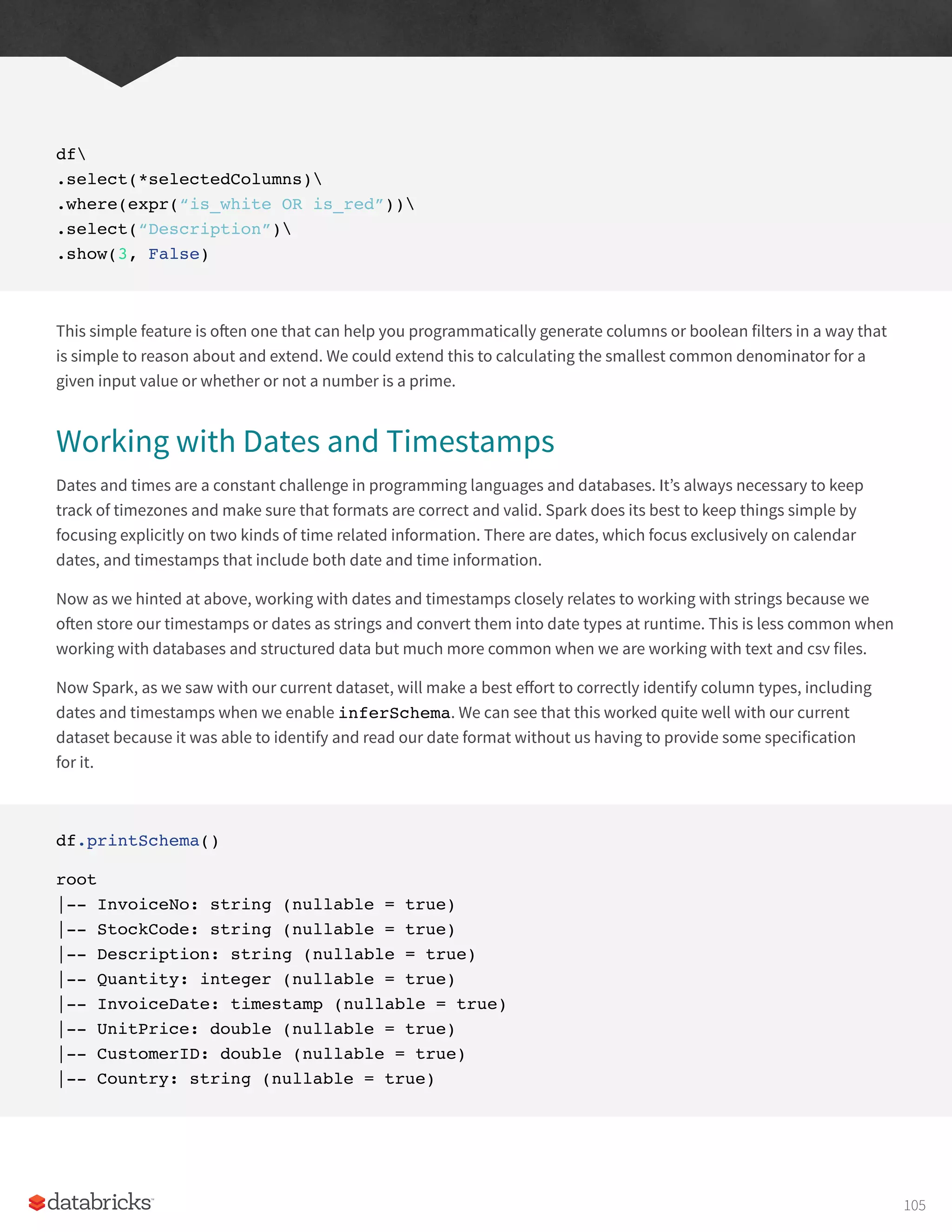
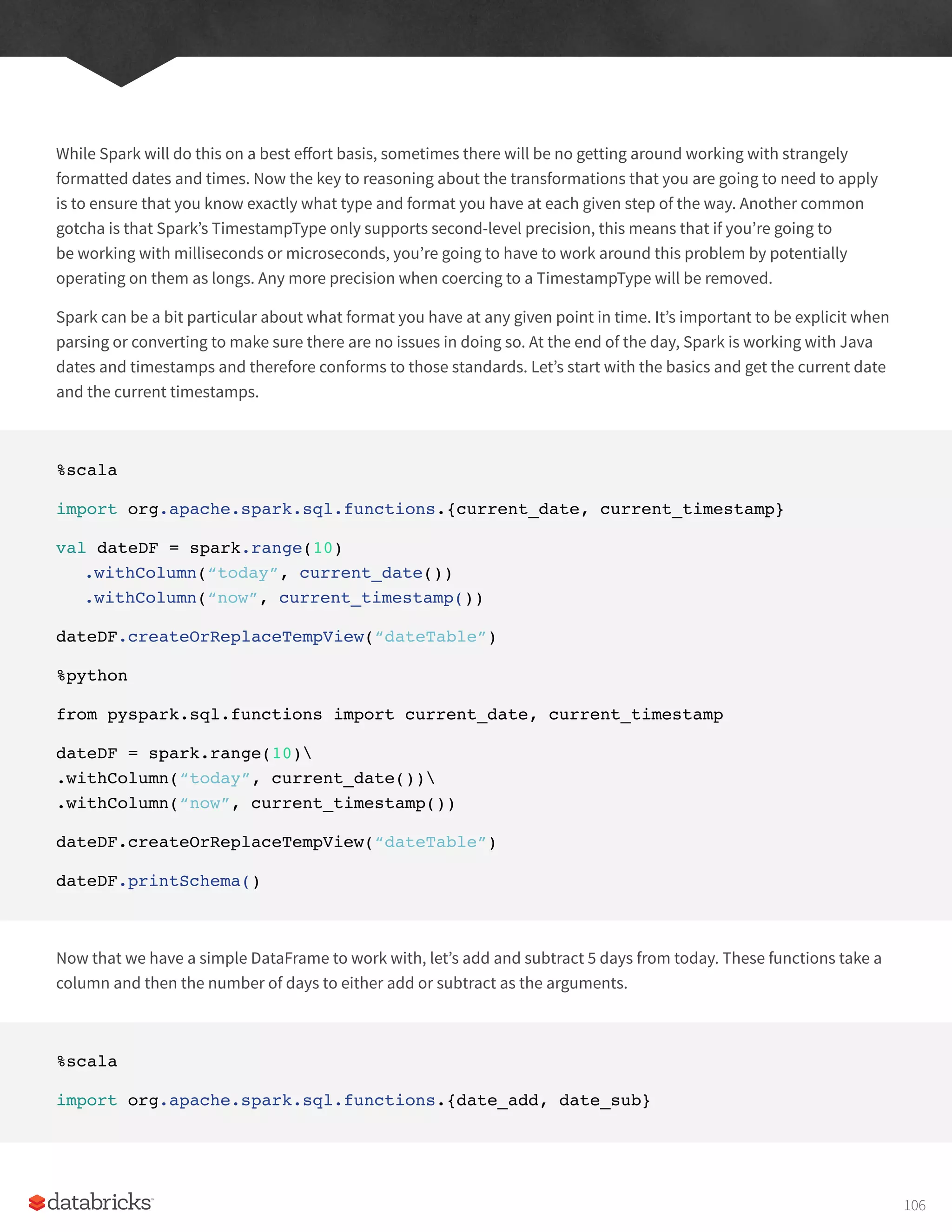
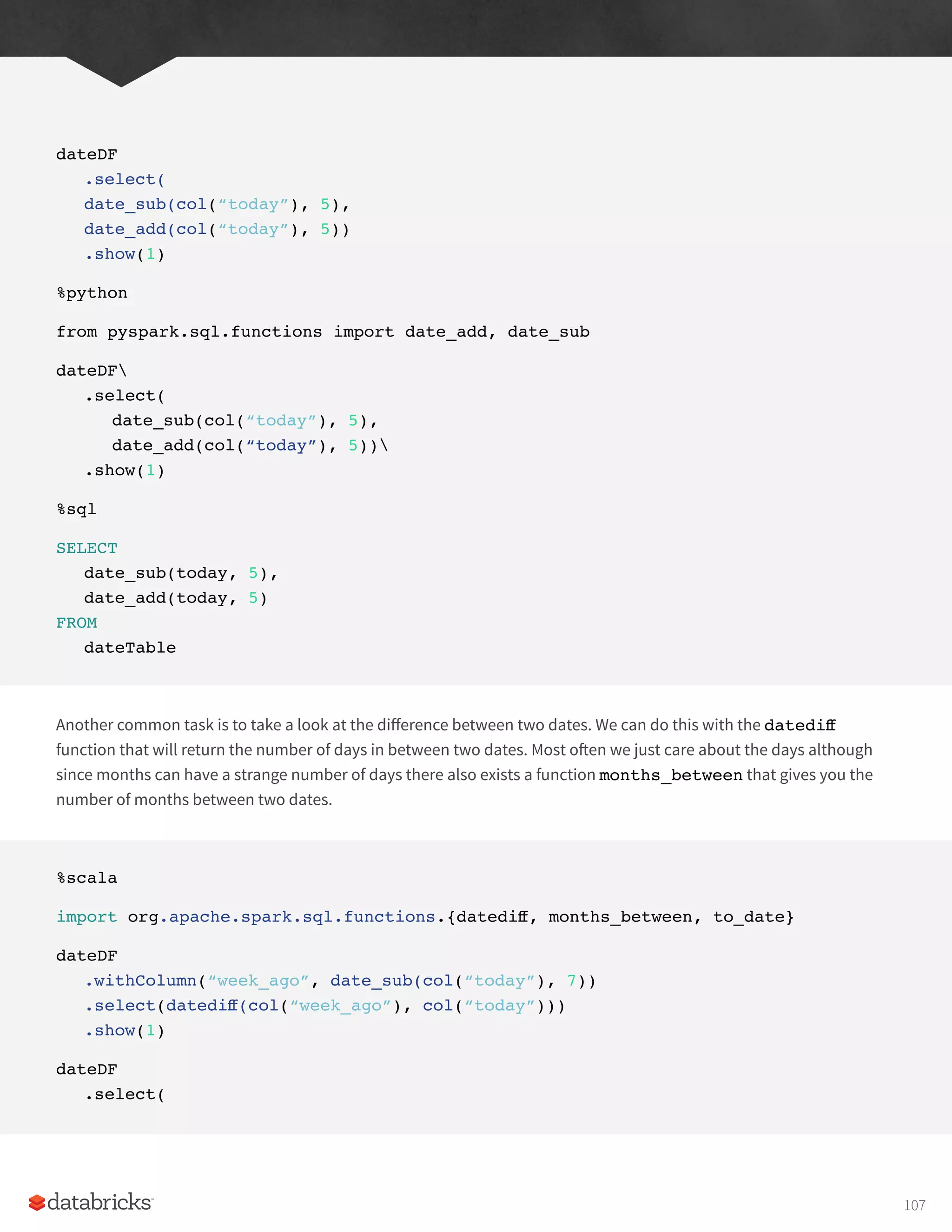
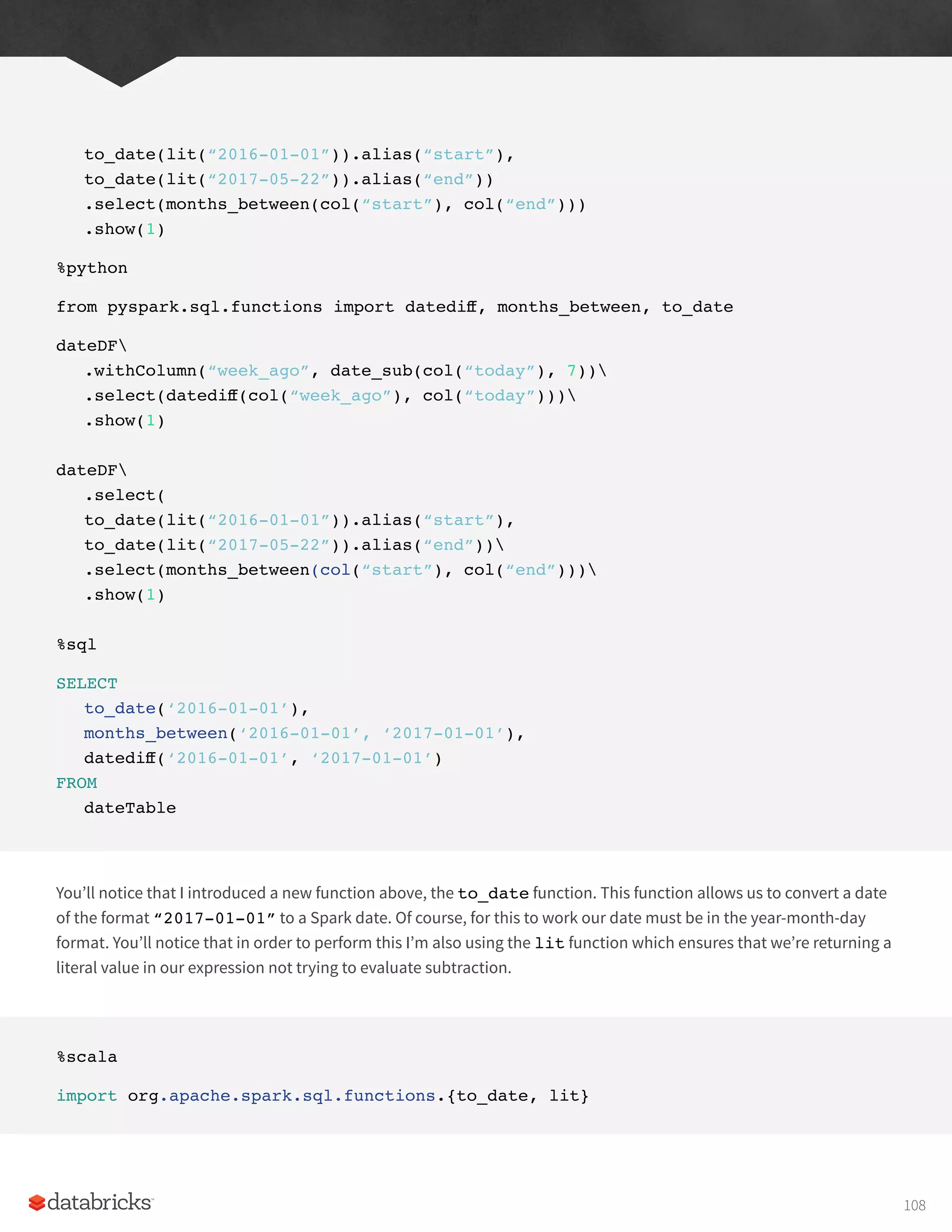

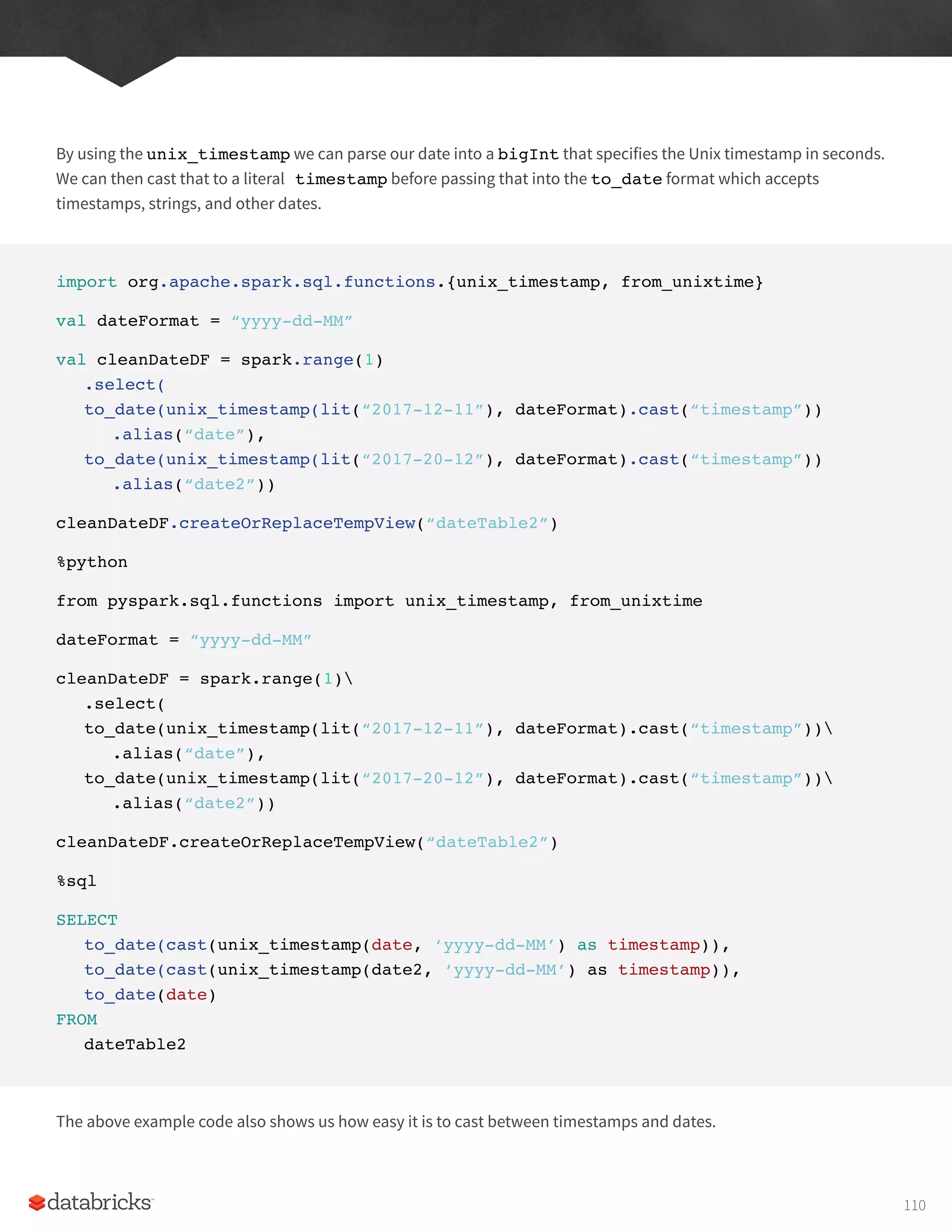
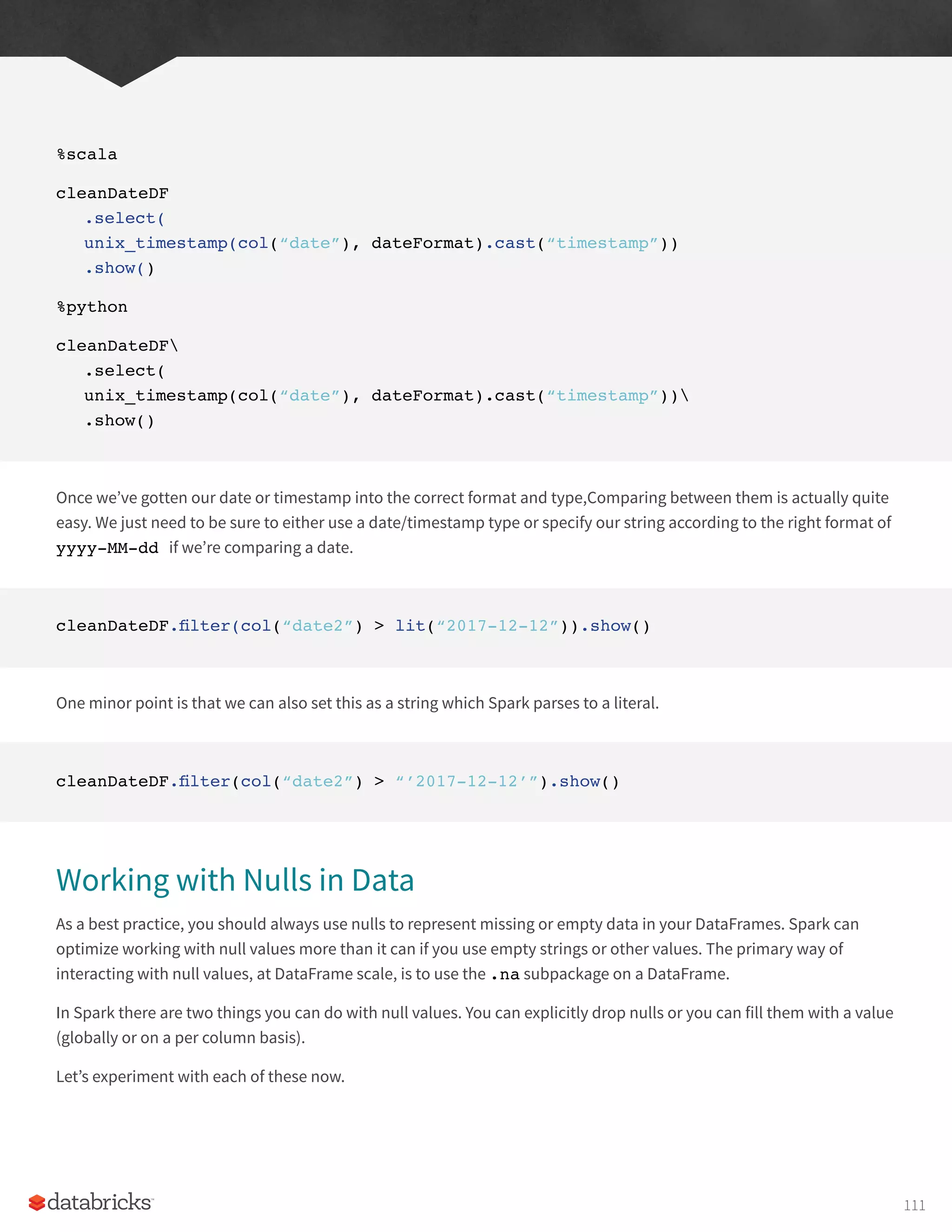
![Drop
The simplest is probably drop, which simply removes rows that contain nulls. The default is to drop any row where
any value is null.
df.na.drop()
df.na.drop(“any”)
In SQL we have to do this column by column.
%sql
SELECT
*
FROM
dfTable
WHERE
Description IS NOT NULL
Passing in “any” as an argument will drop a row if any of the values are null. Passing in “all” will only drop the row if all
values are null or NaN for that row.
df.na.drop(“all”)
We can also apply this to certain sets of columns by passing in an array of columns.
%scala
df.na.drop(“all”, Seq(“StockCode”, “InvoiceNo”))
%python
df.na.drop(“all”, subset=[“StockCode”, “InvoiceNo”])
112](https://image.slidesharecdn.com/apache-spark-the-definitive-guide-excerpts-r1-211010030627/75/Apache-spark-the-definitive-guide-excerpts-r1-112-2048.jpg)
![Fill
Fill allows you to fill one or more columns with a set of values. This can be done by specifying a map, specific value
and a set of columns.
For example to fill all null values in String columns I might specify.
df.na.fill(“All Null values become this string”)
We could do the same for integer columns with df.na.fill(5:Integer) or for Doubles df.na.
fill(5:Double). In order to specify columns, we just pass in an array of column names like we did above.
%scala
df.na.fill(5, Seq(“StockCode”, “InvoiceNo”))
%python
df.na.fill(“all”, subset=[“StockCode”, “InvoiceNo”])
We can also do with with a Scala Map where the key is the column name and the value is the value we would like to
use to fill null values.
%scala
val fillColValues = Map(
“StockCode” -> 5,
“Description” -> “No Value”
)
df.na.fill(fillColValues)
%python
113](https://image.slidesharecdn.com/apache-spark-the-definitive-guide-excerpts-r1-211010030627/75/Apache-spark-the-definitive-guide-excerpts-r1-113-2048.jpg)
![fill_cols_vals = {
“StockCode”: 5,
“Description” : “No Value”
}
df.na.fill(fill_cols_vals)
Replace
In addition to replacing null values like we did with drop and fill, there are more flexible options that we can use
with more than just null values. Probably the most common use case is to replace all values in a certain column
according to their current value. The only requirement is that this value be the same type as the original value.
%scala
df.na.replace(“Description”, Map(“” -> “UNKNOWN”))
%python
df.na.replace([“”], [“UNKNOWN”], “Description”)
Working with Complex Types
Complex types can help you organize and structure your data in ways that make more sense for the problem you are
hoping to solve. There are three kinds of complex types, structs, arrays, and maps.
Structs
You can think of structs as DataFrames within DataFrames. A worked example will illustrate this more clearly. We can
create a struct by wrapping a set of columns in parenthesis in a query.
df.selectExpr(“(Description, InvoiceNo) as complex”, “*”)
df.selectExpr(“struct(Description, InvoiceNo) as complex”, “*”)
114](https://image.slidesharecdn.com/apache-spark-the-definitive-guide-excerpts-r1-211010030627/75/Apache-spark-the-definitive-guide-excerpts-r1-114-2048.jpg)
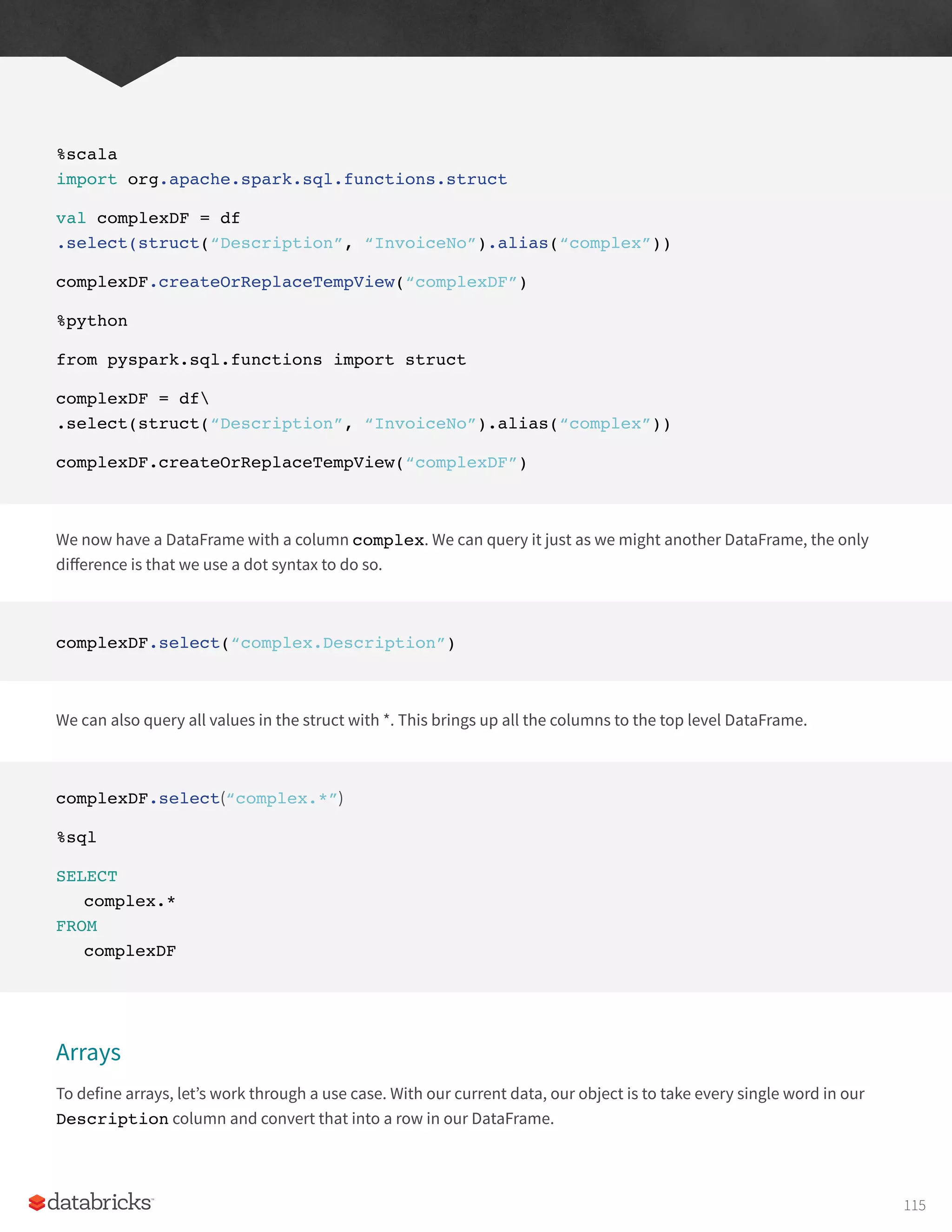
![The first task is to turn our Description column into a complex type, an array.
split
We do this with the split function and specify the delimiter.
%scala
import org.apache.spark.sql.functions.split
df.select(split(col(“Description”), “ “)).show(2)
%python
from pyspark.sql.functions import split
df.select(split(col(“Description”), “ “)).show(2)
%sql
SELECT
split(Description, ‘ ‘)
FROM
dfTable
This is quite powerful because Spark will allow us to manipulate this complex type as another column. We can also
query the values of the array with a python-like syntax.
%scala
df.select(split(col(“Description”), “ “).alias(“array_col”))
.selectExpr(“array_col[0]”)
.show(2)
%python
df.select(split(col(“Description”), “ “).alias(“array_col”))
.selectExpr(“array_col[0]”)
.show(2)
116](https://image.slidesharecdn.com/apache-spark-the-definitive-guide-excerpts-r1-211010030627/75/Apache-spark-the-definitive-guide-excerpts-r1-116-2048.jpg)
![%sql
SELECT
split(Description, ‘ ‘)[0]
FROM
dfTable
Array Contains
For instance we can see if this array contains a value.
import org.apache.spark.sql.functions.array_contains
df.select(array_contains(split(col(“Description”), “ “), “WHITE”)).show(2)
%python
from pyspark.sql.functions import array_contains
df.select(array_contains(split(col(“Description”), “ “), “WHITE”)).show(2)
%sql
SELECT
array_contains(split(Description, ‘ ‘), ‘WHITE’)
FROM
dfTable
However this does not solve our current problem. In order to convert a complex type into a set of rows (one per value
in our array), we use the explode function.
Explode
The explode function takes a column that consists of arrays and creates one row (with the rest of the values
duplicated) per value in the array. The following figure illustrates the process.
117](https://image.slidesharecdn.com/apache-spark-the-definitive-guide-excerpts-r1-211010030627/75/Apache-spark-the-definitive-guide-excerpts-r1-117-2048.jpg)
![%scala
import org.apache.spark.sql.functions.{split, explode}
df.withColumn(“splitted”, split(col(“Description”), “ “))
.withColumn(“exploded”, explode(col(“splitted”)))
.select(“Description”, “InvoiceNo”, “exploded”)
%python
from pyspark.sql.functions import split, explode
df.withColumn(“splitted”, split(col(“Description”), “ “))
.withColumn(“exploded”, explode(col(“splitted”)))
.select(“Description”, “InvoiceNo”, “exploded”)
Maps
Maps are used less frequently but are still important to cover. We create them with the map function and key value
pairs of columns. Then we can select them just like we might select from an array.
import org.apache.spark.sql.functions.map
df.select(map(col(“Description”), col(“InvoiceNo”)).alias(“complex_map”))
.selectExpr(“complex_map[‘Description’]”)
Figure 1:
“Hello World” , “other col”
Split Explode
[ “Hello” , “World” ] , “other col” “Hello” , “other col”
“World” , “other col”
118](https://image.slidesharecdn.com/apache-spark-the-definitive-guide-excerpts-r1-211010030627/75/Apache-spark-the-definitive-guide-excerpts-r1-118-2048.jpg)
![%sql
SELECT
map(Description, InvoiceNo) as complex_map
FROM
dfTable
WHERE
Description IS NOT NULL
We can also explode map types which will turn them into columns.
import org.apache.spark.sql.functions.map
df.select(map(col(“Description”), col(“InvoiceNo”)).alias(“complex_map”))
.selectExpr(“explode(complex_map)”)
.take(5)
Working with JSON
Spark has some unique support for working with JSON data. You can operate directly on strings of JSON in Spark and
parse from JSON or extract JSON objects. Let’s start by creating a JSON column.
%scala
val jsonDF = spark.range(1)
.selectExpr(“””
‘{“myJSONKey” : {“myJSONValue” : [1, 2, 3]}}’ as jsonString
“””)
119](https://image.slidesharecdn.com/apache-spark-the-definitive-guide-excerpts-r1-211010030627/75/Apache-spark-the-definitive-guide-excerpts-r1-119-2048.jpg)
![%python
jsonDF = spark.range(1)
.selectExpr(“””
‘{“myJSONKey” : {“myJSONValue” : [1, 2, 3]}}’ as jsonString
“””)
We can use the get_json_object to inline query a JSON object, be it a dictionary or array. We can use json_
tuple if this object has only one level of nesting.
%scala
import org.apache.spark.sql.functions.{get_json_object, json_tuple}
jsonDF.select(
get_json_object(col(“jsonString”), “$.myJSONKey.myJSONValue[1]”),
json_tuple(col(“jsonString”), “myJSONKey”))
.show()
%python
from pyspark.sql.functions import get_json_object, json_tuple
jsonDF.select(
get_json_object(col(“jsonString”), “$.myJSONKey.myJSONValue[1]”),
json_tuple(col(“jsonString”), “myJSONKey”))
.show()
The equivalent in SQL would be.
jsonDF.selectExpr(“json_tuple(jsonString, ‘$.myJSONKey.myJSONValue[1]’) as res”)
We can also turn a StructType into a JSON string using the to_json function.
120](https://image.slidesharecdn.com/apache-spark-the-definitive-guide-excerpts-r1-211010030627/75/Apache-spark-the-definitive-guide-excerpts-r1-120-2048.jpg)
